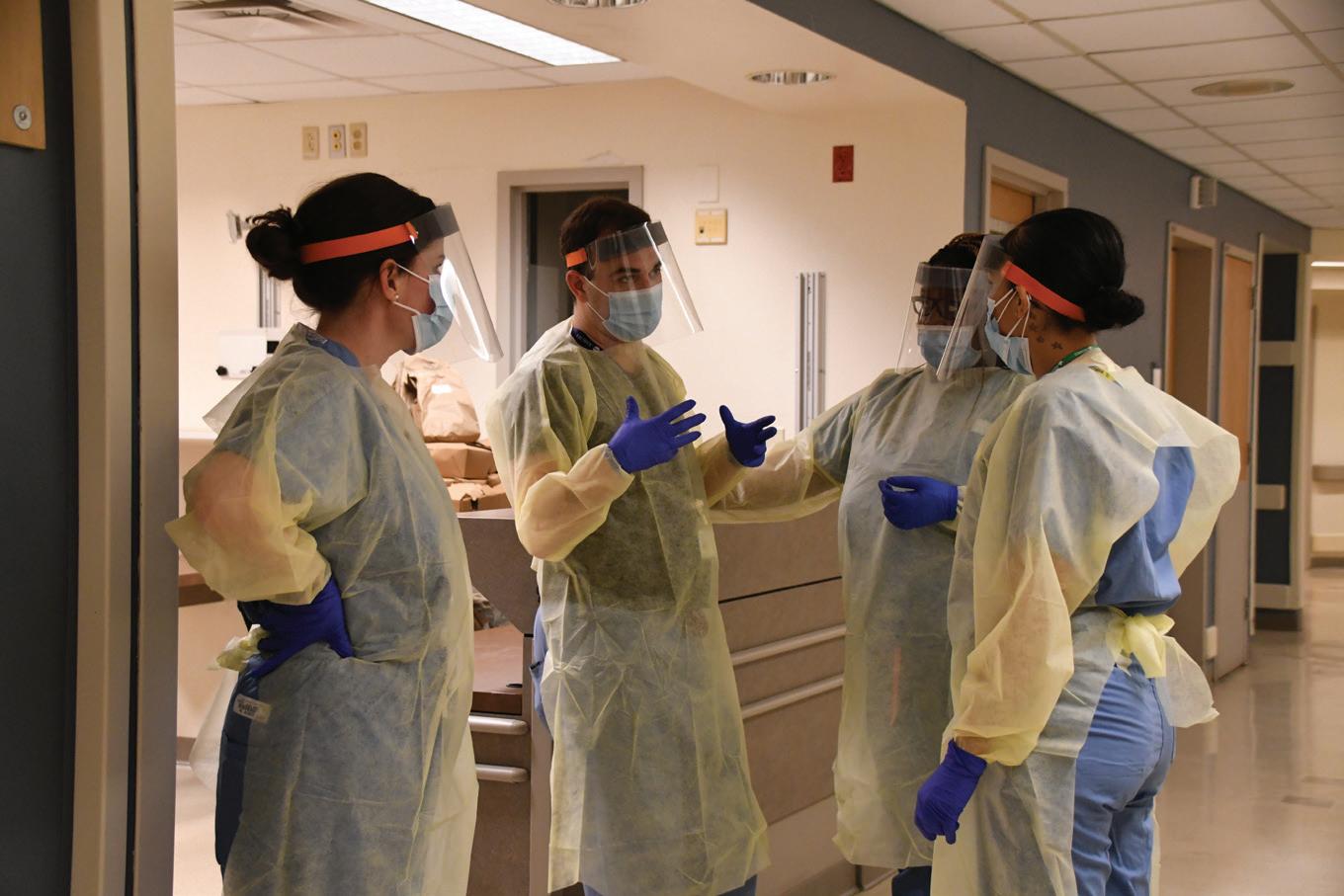




















70 /// A World Away
Once discovered, Maine’s Blue Hill Peninsula and Deer Isle are impossible to forget. By Wayne Curtis
84 /// The Buffalo Bay Bounce
Sweet memories of a family’s seaside retreat also bring questions about what the future holds. By Tim Clark

88 /// The Big Question
We ask Peter Korn, founder of Maine’s Center for Furniture Craftsmanship: Why do we need to make stuff?
90 /// Resilience, Courage, and Hope
Yankee ’s favorite stories of New Englanders getting through hard times.
100 /// Gull Trouble
As more seagulls move into coastal cities, their overall numbers are shrinking. What’s going on with the bird everyone loves to hate?
 By Sara Anne Donnelly
By Sara Anne Donnelly








24 /// Bringing the Sea Inside
From otherworldly paintings and flowing scarves to crisply nautical totes, meet 10 New England makers who are sharing their love of the coast.
 By Annie Graves
By Annie Graves
34 /// House for Sale
Art lovers can put themselves in the picture with a Stockbridge, Massachusetts, property that guest-stars in a Norman Rockwell painting.
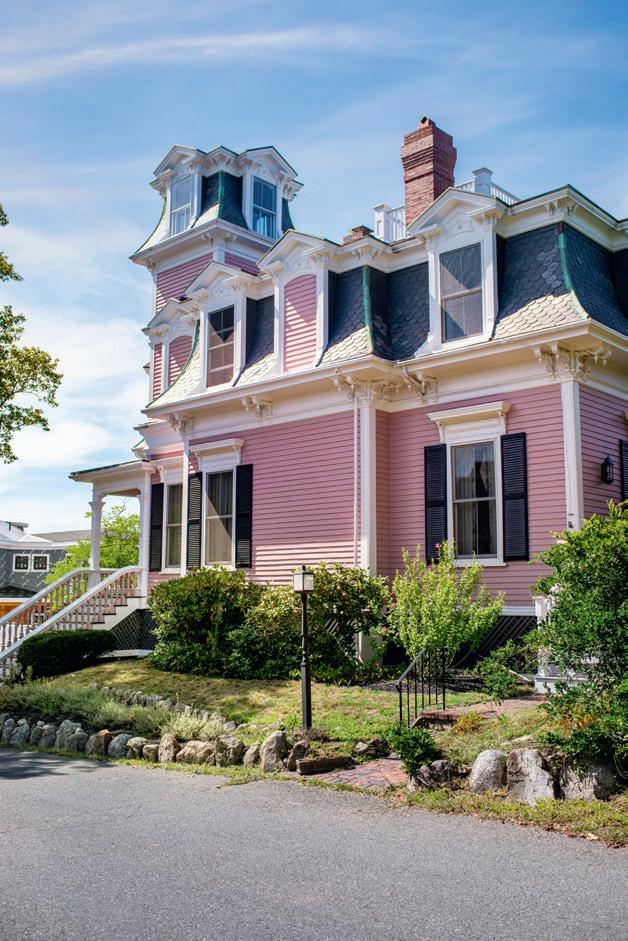 By Joe Bills
By Joe Bills
40 /// La Vida Local
In a New Hampshire cornfield, acclaimed chef David Vargas has discovered a way to reconnect with his roots. By
 Amy Traverso
Amy Traverso
46 /// Local Flavor
We travel to Lobster Landing to find the perfect hot buttered roll on the Connecticut shore.
By Amy Traverso48 /// In Season
Celebrate the bounty of local produce with this update on the French classic ratatouille.
By Amy Traverso50 /// Weekend Away
On Massachusetts’s “Other Cape,” Gloucester and Rockport are summertime treasures hiding in plain sight. By Amy
Traverso60 /// The Best 5
These New England beaches have everything you and the kids need for an ideal day of surf and sand. By
Kim Knox Beckius62 /// The Great Outdoors
When the time is right to hit the trail, these hikes deserve a spot on your to-do list.
BY D.A.W.
12
INSIDE YANKEE
14
FIRST PERSON
On the 75th anniversary of the end of World War II, we’re resharing some of our favorite memories from Yankee readers who lived through that era.
16
FIRST LIGHT
Hitting the Connecticut Art Trail, where $25 can get you access to half a million works of art. By Joe
Bills20
5 QUESTIONS WITH...
We catch up with Vermont’s Charlie Shackleton, creator of the Naked Table Project and a featured Weekends with Yankee guest.
23
KNOWLEDGE & WISDOM
Will the real Independence Day please stand up?
120
LIFE IN THE KINGDOM
On the homestead there’s animals to tend, wood to cut—and outside the window, a fast-changing world. By Ben
Hewitt



EDITORIAL
Editor Mel Allen
Deputy Editor Ian Aldrich
Managing Editor Jenn Johnson
Senior Food Editor Amy Traverso
Home & Garden Editor Annie Graves
Associate Editor Joe Bills
Senior Digital Editor Aimee Tucker
Associate Digital Editor Katherine Keenan
Contributing Editors Kim Knox Beckius, Ben Hewitt, Rowan Jacobsen, Krissy O’Shea, Julia Shipley

ART
Art Director Katharine Van Itallie
Photo Editor Heather Marcus
Contributing Photographers Adam DeTour, Megan Haley, Corey Hendrickson, Michael Piazza, Greta Rybus
PRODUCTION
Director David Ziarnowski
Manager Brian Johnson
Senior Artists Jennifer Freeman, Susan Shute
DIGITAL
Vice President Paul Belliveau Jr.
Designer Amy O’Brien
Marketing Specialist Holly Sanderson
CORPORATE STAFF
Credit Manager Bill Price
Staff Accountant Nancy Pfuntner
Accounting Coordinator Meg Hart-Smith
Executive Assistant Christine Tourgee
Receptionist Linda Clukay
Maintenance Supervisor Mike Caron
Facilities Attendant Paul Langille
YANKEE PUBLISHING INC.
ESTABLISHED 1935 | A N EMPLOYEE-OWNED COMPANY
President Jamie Trowbridge
Vice Presidents Paul Belliveau Jr., Jody Bugbee, Ernesto Burden, Judson D. Hale Jr., Brook Holmberg, Sandra Lepple, Sherin Pierce
Editor Emeritus Judson D. Hale Sr.
BOARD OF DIRECTORS
Andrew Clurman, Daniel Hale, Judson D. Hale Jr., Joel Toner, Cor Trowbridge, Jamie Trowbridge
FOUNDERS
Robb and Beatrix Sagendorph
Publisher Brook Holmberg
ADVERTISING
Vice President Judson D. Hale Jr.
Media Account Managers Kelly Moores, Dean DeLuca , Steven Hall
Canada Account Manager Françoise Chalifour
Senior Production Coordinator Janet Selle
For advertising rates and information, call 800-736-1100, ext. 204, or email NewEngland.com/adinfo.
MARKETING
ADVERTISING
Director Kate Hathaway Weeks
Manager Valerie Lithgow
Associate Holly Sloane
PUBLIC RELATIONS
Roslan & Associates Public Relations LLC, 212-966-4600
NEWSSTAND
Vice President Sherin Pierce
NEWSSTAND CONSULTING
Linda Ruth, PSCS Consulting, 603-924-4407
SUBSCRIPTION SERVICES
To subscribe, give a gift, or change your mailing address, or for any other questions, please contact our customer service department:
Yankee Magazine Customer Service
P.O. Box 422446
Palm Coast, FL 32142-2446
Online NewEngland.com/contact
Email customerservice@yankeemagazine.com
Toll-free 800-288-4284
To order additional copies, contact Stacey Korpi at 800-895-9265, ext. 160.
Yankee occasionally shares its mailing list with approved advertisers to promote products or services we think our readers will enjoy. If you do not wish to receive these offers, please contact us.
Yankee Publishing Inc., 1121 Main St., P.O. Box 520, Dublin, NH 03444 603-563-8111; editor@yankeemagazine.com





































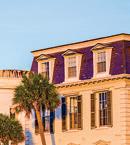


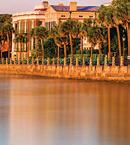
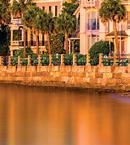











A curated look at New England featuring standout shots from our Instagram community.



Use our Instagram hashtag, #mynewengland, for a chance to be featured in an upcoming issue!





Want more of the best of New England? Follow us on Instagram to stay up to date on all of our latest travel tips and recipes, share your local knowledge with other readers, and see stunning images from photographers around New England.





























GRETA RYBUS
A Portland-based photojournalist who’s been published by The New York Times and Smithsonian , among others, Rybus was already a fan of the Blue Hill region when she took Yankee ’s assignment [“A World Away,” p. 70], praising it as a place that “has long celebrated and supported artists, writers, farmers, and fishermen in ways that feel truly unique, and often a bit off-kilter.”


TOM HAUGOMAT
For this artist born and bred in Paris, depicting a New England scene may have felt a tad exotic [“Life in the Kingdom,” p. 120]. “It’s a poetic story set in Vermont, a wild place that I found very inspiring,” says Haugomat, whose illustrations have appeared everywhere from Le Monde to The New Yorker, and who recently published the graphic novel Through a Life
TRISTAN SPINSKI


A freelance photographer interested in stories about “the intersections of people, economy, and what is left of wild places,” Spinski lives in midcoast Maine and has worked for publications including Rolling Stone, The Washington Post. Of his Yankee assignment [“Gull Trouble,” p. 100], he reports that having to wear a bike helmet to protect himself from dive-bombing gulls was a humbling experience.
Having explored artists’ studios up and down the Yankee ’s home and garden editor, this lifelong New Englander shares some favorite ocean-inspired creations in “Bringing the Sea Inside” [p. 24]. “It seemed like a natural extension to see how our artisans capture the ocean’s salty magnificence in everything from silk and porcelain to recycled sails.”

This veteran journalist and former Mainer relished the chance to return to the Blue Hill region, talk with residents, and learn more about recent changes there [“A World Away,” p. 70]. He was especially struck by the rising food scene: “It didn’t feel like outsiders fancying the place up so much as a partnership of producers, restaurant owners, and consumers figuring out how to navigate a new economy.”

SARA ANNE DONNELLY
The more she learned about seagulls [“Gull Trouble,” p. 100], the more Donnelly understood “why their coarse vulnerability inspires such love among those who study them.” The longtime freelance journalist grew up in Portland and subscribes to the theory that you’re not really a local until you’ve been pooped on by a seagull. (For the record, Donnelly is now a local many times over.)
I am a priest by profession, and I seem to hear themes of hopelessness expressed more and more frequently with almost each passing day. And it’s getting harder and harder to listen to now, as I know I am feeling it within myself as well.
But today I read Sophfronia Scott’s story about her son, Tain, a survivor of the 2012 tragedy at Sandy Hook [“Hope on Any Given Day,” March/ April]. It was one of the most moving and beautifully written articles I think I have ever read.
No one in our country, especially a child, should ever have to go through such a horrific experience. It is a very, very tragic story—but, ironically, it is also one filled with hope!
Thank you for publishing Ms. Scott’s most inspiring article. It has actually helped to change the way I am looking at our world right now.
Rev. Jim Morris New York, New YorkThe March/April Yankee arrived in our winter Honolulu mail locker on the day we headed home to New Hampshire. Family had advised that my nearly 96-year-old father had taken a downward turn. The night before we left Hawaii, I read aloud to my husband an old Edie Clark essay on maple sugaring with plastic tubing versus sap buckets.
As my dad lived his last few days, I read Yankee aloud to him, too.
When others wanted their private time with Dad, we went out under a brisk blue March sky to enjoy maple producers’ open houses. We kept driving familiar back roads, searching, until we found a farm with metal buckets hanging on their old front-yard maples. We opened the windows, turned off the car, and listened, soaking up the sounds Edie described, of the fresh sap dripping rhythmically.
Every few years I try to cancel my ancient Yankee subscription, but I
Beware the bathing suit you trust
To stay around your waist or bust…
Elastic breaks and rivets rust
So buy a new one, if you must.
—D.A.W.
always come back. Here’s to you. And as my departed parents would often say, Keep a-goin’.
Rebecca Kimball Faunce Epping, New HampshireKnowing we’d be busy in March and April in our little log cabin sugarhouse we built over 40 years ago, I picked up the spring issue of Yankee, as its focus on maple sugaring was an instant draw. My husband and I enjoyed all the articles, reading between firing up the arch, paying attention to the pans, guiding our on-farm resident grandsons (ages 7 and 4) in this year’s sugaring procedures, and, of course, sampling each batch to grade it properly.
What also prompted me to write was a funny anecdote: The magazine
was on the same bench where we do the bottling, and some syrup dripped out of an unsealed container right onto the cover photo of yummy-looking waffles. I guess they were “asking” to be topped with real Vermont maple syrup! Thanks for a fine issue, and given that we had to restrict visitors this year due to the virus, we were happy to have the reading material on hand. Let’s hope New England, along with the rest of the world, can come out of viral hibernation before too long.
Sandal Cate Montpelier, VermontToday my husband and I drove the Mohawk Trail just to get away from the world for a little bit; this week we intend to go sit in the parking lot in front of our beloved Nubble Light. Our personal touchstones are always important, never more so than when we feel a little anxious. Getting out and seeing part of our community is important for the soul and helps put a bit of perspective into our hearts instead of so much sadness and fear. As always, I look forward to more wonderful storytelling from Yankee, and along with it, great ideas for places to see once the world rights itself.
Lori Joyal Sudbury, MassachusettsI am a Southerner who lives in Georgia over the winter and summers on an island in Maine. Down here, we love our barbecue, so with some trepidation we tried the recipe for maple barbecue ribs in your latest issue [“Good as Gold,” March/April].
Absolutely the best ribs we have ever served—and a big thank-you for that and the nice magazine you publish. Yankee and Southern Living are the only magazines we now subscribe to. Keep up the great work!!
Pete Joslin Dahlonega, Georgia
60 Grandma Moses Rd. P.O. Box 94, Eagle Bridge,
“Art to warm your heart and home”
“Art to warm your heart and home”
“Art to warm your heart and home” MT. NEBO GALLERY 60 Grandma Moses Rd. P.O. Box 94, Eagle Bridge, NY12057

60 Grandma Moses Rd. P.O. Box 94, Eagle Bridge, NY12057 1-800-328-6326
MT. NEBO GALLERY 60 Grandma Moses Rd. P.O. Box 94, Eagle Bridge, NY12057 1-800-328-6326
MT. NEBO GALLERY 60 Grandma Moses Rd. P.O. Box 94, Eagle Bridge, NY12057 1-800-328-6326

FREE color catalog is available featuring Will Moses limited edition Folk Art Prints, Books, Puzzles, Cards & More!
1-800-328-6326
FREE color catalog is available featuring Will Moses limited edition Folk Art Prints, Books, Puzzles, Cards & More!

FREE color catalog is available featuring Will Moses limited edition Folk Art Prints, Books, Puzzles, Cards & More! VISAMASTERCARD AMERICAN
FREE color catalog is available featuring Will Moses limited edition Folk Art Prints, Books, Puzzles, Cards & More! VISAMASTERCARD
am writing this letter on the cusp of May. What the world and, in particular, New England will be like when you hold this issue remains a mystery. Will we be walking through the streets of Boston or Providence or Burlington? Will cars be streaming to Cape Cod? Will friends be over for a backyard barbecue? Will we lose ourselves in America’s pastime for a few hours at Fenway Park? Or will we still be doing the hard and essential work of staying home, helping to give everyone the best chance at emerging safely through these rough times?
In the weeks to come, the Yankee staff will be planning the issues we’ll publish months from now, just as we planned this issue during a time that I can barely remember, as if it fell into a hole when I wasn’t looking. But with so many unknowns, I have this certainty: Yankee has been welcomed into readers’ homes since 1935, in the depths of the Great Depression, because it offers the enduring stories and images of a New England that people want to know and to see. And this issue and the next one and the one after that will take you there—that’s a promise.
It was also in the 1930s that the writer E.B. White and his wife, Katharine, bought a saltwater farm in the village of Brooklin, Maine. Two decades later they moved from New York to live full-time on the Blue Hill Peninsula, where White wrote some of the most enduring essays and books in American literature, including Charlotte’s Web. What White found among the sea-scented villages was beauty and peacefulness. He famously wrote, “I would really rather feel bad in Maine than good anywhere else,” and he once compared driving across the Maine border to “having received a gift from a true love.” In this issue, our travel feature on the Blue Hill region, “A World Away” [p. 70], opens a window on what remains a tucked-away slice of the Maine coast. Maybe you’ll come sooner, maybe later.
While merely reading about people who fought through hardship may not magically give us the will to do the same, the New Englanders whose stories make up “Resilience, Courage, and Hope” [p. 90] would tell you, if they could, that they were no different than any of us. They did what they needed to do. We are all on a life raft, we are all lost on a mountain, we are all battling the flames—day by day, doing everything we can to make it through.
Finally, we here at Yankee want to hear about people in your own community whose resilience or service to others has inspired you—people who have given you hope, like a gift from a true love. Tell us about them by emailing heroes@yankeepub.com
 Mel Allen
Mel Allen








BACK IN 1995, to mark the 50th anniversary of the end of World War II, Yankee asked its readers to send in their memories of V-E Day and V-J Day, which for many were both joyous and bittersweet occasions. This year, on the 75th anniversary, we went into the archives to share again these New England voices from a time that changed the world.

train rumbling down the single track that ran parallel to the beach. It was a troop train, jam-packed with soldiers heading for Camp Edwards and discharge from the army. Car after car rolled by, the guys hanging out the open windows, whistling, waving, shouting, cheering. All day long for several days the trains rolled like clockwork. We sat on the beach, facing the track, and we waved and we cheered until our arms ached and our throats went dry. —
Elaine Bierbauerveryone saw the man at the same time, on the beach at the end of the lake. He was jumping up and down, waving his arms as if trying to take flight. We thought he needed help, so we all piled into the motorboat. As we moved down the lake toward him, he continued jumping and waving. He was shouting something at us, but we couldn’t hear him. Then my father cut the motor, and we heard the words the world had been waiting to hear for so many years: “The war is over! The war is over!”
Nancy ChurchillWhat a glorious time! The girls all rode the trolleys to Boston, where we joined the craziest, happiest mob that ever gathered. We were pushed, hauled, mauled, bussed, and praised—all at the same time. Arms enveloped from behind, hugs arrived and departed from unknowns, but we were all one family at that moment.
Jacqueline DeamIt was a hot, sultry day in late August 1945, and I was alone on the beach just minutes away from the railroad bridge across the Cape Cod Canal at Bourne. I heard the sound of a
I was about 7 years old and living in the industrial city of Waterbury, Connecticut, in 1945. Every factory in the city blew a whistle to call shifts to work, and each one had a different sound. Our fox terrier, Scotty, would bark every time a factory alarm went off. The day the war ended, every factory whistle and horn erupted. With relish, Scotty ran out the back door to accept the challenge. Of course he was outmatched, but he fought valiantly as long as he could. After several minutes he stopped barking, took a few deep breaths, and with a raspy voice started again. A few minutes later he had to stop again, take a few more deep breaths, and try to resume. By now he was just getting a few squeaks from his throat. Neighbors came out on their porches to watch Scotty’s brave efforts. Our stubborn dog was no longer making any sounds at all: He was doing a pantomime of barking. Eventually the horns and whistles stopped, and Scotty strutted away, knowing the battle was over. But when he tried to give a triumphant victory cry, all he could emit was a hoarse little cough. —
Ed MartinOn the evening of May 7, 1945, the Radcliffe Choral Society was at Boston’s Symphony Hall awaiting the arrival of conductor Serge Koussevitzky, who was to conduct us, along with the Harvard Glee Club, in a performance of the “Ode to Joy” from Beethoven’s Ninth Symphony. The audience grew restive, as it was past time to begin. Suddenly Koussevitzky strode onto the stage, flung off his elegant black cape, and declared: “Ladies and gentlemen, the war with Germany is over!” He whirled to lead the orchestra in “The Star-Spangled Banner,” which was sung by all, with tears flowing freely. Then we sang our “Ode to Joy” with hearts bursting. —
Jean Moulton BurdakinThis summer our Portland, Maine brick and mortar store might be open or maybe not. “Safety of course”, but we’ll always be here to serve you online, not just M-F, 9-5 but 24/7/365 with an awesome website to search, discover, it’s a place where treasure’s abound. You may Click & Buy or Click & Call and always, always, always we’d be delighted to hear from you. And we would love to stay in touch with you too.
Sign up for our daily emails and be the very first to know.
In our weekly emails, you’ll see the rare, the exotic and the unusual and sometimes you will see something so cute, so ordinary but so cute you simply can’t resist...we understand.

We know how you feel about inviting in, one more marketer who obviously is trying to sell you something. Which is why we’ve worked so hard to make our emails truly count, entertain and enthrall.
Go to our website to sign up, if we ever disappoint you, we deserve to be deleted, you can easily delete us in 10 seconds.
We guarentee you’ll be delighted with your new discoveries.


When the first stop on our journey lasts well over three hours, I realize that my goal of experiencing the entire Connecticut Art Trail won’t be met this weekend. No surprise, really: Linking nearly two dozen museums across the state, the 250-mile “trail” is more a marketing and programming collaboration than an actual route that travelers are meant to follow. Still, it’s good to have ambition, even if I’m suddenly aware that mine will need adjusting.
Launched 25 years ago as the Connecticut Impressionist Art Trail to celebrate the state’s leading role in the evolution of American Impressionism, the project today carries a shorter name to reflect its many additional kinds of museums and sites.
One of the brilliant threads that hold this innovative tapestry together is a little booklet, the Art Trail Passport, which can be purchased online or at member museums for $25. Good for a year, it grants a single admission to each of the 21 member museums, essentially merging them into a single sprawling entity, a multicampus museum that would rank among the best anywhere. (There are also two affiliate institutions on the trail, New Canaan’s Glass House and Silvermine Arts Center, but they don’t participate in the passport program.)
Joining me on my Connecticut Art Trail journey is a friend who also happens to be an arts journalist. I’m always happy to have her with me, but even more so on this trip: Her knowledge is my guide. When she “oohs” and “aahs” over a particular work, I know I should pay attention.
Our home base for this arts-immersion weekend is the posh Delamar Southport, so we launch our excursion in the southwest corner of the state, where the largest cluster of member museums is located. And our first two stops, coincidentally, perfectly encapsulate the Connecticut Art Trail’s diversity.
We start at Wilton’s Weir Farm National Historic Site , where artist Julian Alden Weir made his summer home
When you hit the Connecticut Art Trail, $25 can get you access to half a million works of art.
from 1882 to 1919. Weir acquired these 153 acres in exchange for a painting and 10 dollars. Classically trained, Weir initially disliked Impressionism— given how it de-emphasized realism in favor of light, color, and movement— but his attempts to portray this landscape helped change his mind. As we walk the grounds, we are surrounded by the same views that inspired Weir and
his contemporaries to gather here to paint en plein air. Weir left an artistic legacy that was built upon by succeeding generations of artists, including his daughter, painter Dorothy Weir Young, and her husband, sculptor Mahonri Young, whose massive creations were fashioned in a multilevel studio that is now a fascinating part of the Weir Farm tour.
FAIRFIELD COUNTY
Bush-Holley House, Greenwich. 203-869-6899; greenwichhistory.org
Bruce Museum, Greenwich. 203-869-0376; brucemuseum.org
Center for Contemporary Printmaking, Norwalk. 203899-7999; contemprints.org
Fairfield University Art Museum, Fairfield. 203-2544046; fairfield.edu/museum
*The Glass House, New Canaan. 203-594-9884; theglasshouse.org
Housatonic Museum of Art, Bridgeport. 203-
332-5052; museum. housatonic.edu
*Silvermine Arts Center, New Canaan. 203-966-9700; silvermineart.org
Stamford Museum & Nature Center, Stamford. 203-3221646; stamfordmuseum.org
Weir Farm National Historic Site, Wilton. 203-834-1896; nps.gov/wefa
NORTHWEST
Aldrich Contemporary Art Museum, Ridgefield. 203-438-4519; aldrichart.org
Mattatuck Museum, Waterbury. 203-753-0381; mattmuseum.org
GREATER NEW HAVEN
Less than 10 minutes’ drive from the Weir Farm, we discover what feels like the opposite end of the artistic universe, Ridgefield’s Aldrich Contemporary Art Museum . One of the least traditional museums on the trail, the Aldrich was founded in 1964. Although its focus has always been on contemporary art, the institution doubled down on that commitment in 1981, when it decided to sell its entire permanent collection and focus solely on exhibiting the most significant work being done by artists of the moment. Among the 8,000-plus artists to have one of their first major shows here are Eva Hesse and Frank Stella.
I love the Aldrich even before we step out of the car, as I spy Nari Ward’s 30-foot-tall sculpture Apollo/Poll in the museum’s backyard. There, the
Ireland’s Great Hunger Museum at Quinnipiac University, Hamden. 203-582-6500; ighm.org
Yale Center for British Art, New Haven. 203-432-2800; yale.edu/ycba
Yale University Art Gallery, New Haven. 203-432-0600; artgallery.yale.edu

MYSTIC COUNTRY
Florence Griswold Museum, Old Lyme. 860-434-5542; florence griswoldmuseum.org
Lyman Allyn Art Museum, New London. 860-443-2545; lymanallyn.org
Mystic Museum of Art, Mystic. 860-536-7601; mysticmuseumofart.org
Slater Memorial Museum, Norwich. 860-887-2506; slatermuseum.org
William Benton Museum of Art, University of Connecticut at Storrs. 860-486-4520; benton.uconn.edu
RIVER VALLEY/ GREATER HARTFORD Art Museum at the University of Saint Joseph, West Hartford. 860-2315399; usj.edu/artmuseum
Hill-Stead Museum, Farmington. 860-677-4787; hillstead.org
New Britain Museum of American Art, New Britain. 860-229-0257; nbmaa.org
Wadsworth Atheneum Museum of Art, Hartford. 860-278-2670; thewadsworth.org
stand-alone re-creation of the iconic sign outside Harlem’s Apollo Theater sprouts from a grassy clearing as if from a seed accidentally dropped by a city visitor.
While many of the museums on the trail are broad in scope, others are uniquely narrow, such as Quinnipiac University’s Ireland’s Great Hunger Museum , which houses the world’s largest collection of art and educational resources related to the Irish famine of the mid-19th century.





The hubs of the state’s most celebrated Impressionist colonies, the Bush-Holley House in Greenwich and Florence Griswold’s boarding house in Old Lyme, have both been reborn as museums that are highlights of the trail. At the latter, now known as the Florence Griswold Museum , plan to linger in the main house, where visiting artists often signed their names and painted directly on the walls and doors.
On the Yale campus, the neighboring Yale Center for British Art and Yale University Art Gallery are notable not only for their impressive collections but also for museum shops full of eclectic and interesting books, games, toys, and all manner of creative goodies. Both also offer self-guided, app-based tours, which are a handy way to make sure you aren’t missing the must-sees.
At the very heart of the Connecticut Art Trail is one of New England’s most underappreciated great museums, Hartford’s Wadsworth Atheneum , the oldest continuously operating public art museum in the country. Its collection has grown from 87 paintings in 1844 to nearly 50,000 works today, comprising not only masterworks by the likes of Caravaggio, Frederic Church, Matisse, and Picasso but also standout pieces by Salvador Dalí, Joan Miró, and
Andy Warhol. But nothing at the Wadsworth makes a stronger impression on me than the building’s great marble staircase, emblazoned with the wildly colorful Whirls and Twirls, a geometric acrylic by Hartford native Sol LeWitt.
When we return each night to our room at the Delamar—a boutique hotel that is itself filled with original works of art—it is the unexpected treasures that run through my head: Apollo/Poll at the Aldrich, the cartoonish animals from an ancient bestiary at the Yale Center for British Art, the video installation by Bill Viola at the Wadsworth Atheneum in which a Christ-like figure appears to be drowning. And after three days, we head home knowing that the vast majority of the Connecticut Art Trail’s treasures still remain for us to discover. But that’s OK—our passports are good for a whole year.





Apartment and cottage living at Piper Shores offers residents fully updated and affordable homes, with all the benefits of Maine’s first and only nonprofit lifecare retirement community. Located along the Southern Maine coastline, our active, engaged community combines worry-free independent living with priority access to higher levels of on-site care—all for a predictable monthly fee.
Call today for a complimentary luncheon tour.

If you want to change a person’s life, Charlie Shackleton has an idea: Give them the opportunity to create something with their hands. “Fundamentally, humans are active people who like to make things,” says the Irish-born furniture maker, who with his wife, the potter Miranda Thomas, own ShackletonThomas, a company that produces handmade
furniture and pottery in Bridgewater, Vermont. Classes and an ambitious apprenticeship program have always been a part of Shackleton’s business model, but a dozen years ago he further homed in on helping others get creative when he launched the Naked Table Project. In it, Shackleton invites people to make tables from locally sourced wood at his workshop. Participants learn about the trees that yielded the lumber, and the event wraps up with a celebratory lunch of local foods served on the new tables. “Not only does this event make happy memories,” says Shackleton, “but you get to take home this functional object, which everyone can sit around for many years.” —Ian Aldrich

Q What was the inspiration for the Naked Table Project?
A A little more than a decade ago, there was a local sustainability group that was looking for ideas to inspire [that movement] and give it meaning. My project was quite simple: to make a table from a tree and introduce people to the whole experience around doing that. It was a way to connect people to each other and the environment.
Q The project also reflects the idea that there’s something powerful about being able to make something with your hands. Why is that important to you?
A The sheer act of making something out of nothing is astonishing. I started this company because I wanted to foster people who love to make things— young people in school who weren’t doing well in the classroom, adults who wanted to try something different—not just so they’d learn to make things but because doing so increases self-confidence. And it creates a buzz from doing it.





















Q Have you seen people find that kind of empowerment?
A We have people who come here [for classes] and tell us they’re complete klutzes with their hands. You give them a tool, and maybe they’re a banker with no background in any of this, and you tell them they can carve the clay or do a decoration. They have this look of terror—they’re terrified of getting dirty or of getting cut. But then they start doing it, and they become obsessive. They become different people. It’s quite powerful.
Q You’ve said handmade things have more allure. Why?
A We use hand tools, and what we make is not uniform. You get slight variations through the whole thing, which gives it a vibe like, Oh, a human being was here and made this. My wife and I have a handle from a Roman pot. It’s 2,000 years old. You can see not only the maker’s thumbprint but also where his nail pressed into the clay. That’s amazing. That’s a moment in time that you connect with by looking at it.
Q What’s your advice to an aspiring furniture maker?
For high school and gap-year students with learning differences:
• Develop critical academic and executive function skills
• Earn college credits

• Explore academic interests
Download the brochure at: landmark.edu/dual
A Furniture making is based around two things: food and sex. Dining room tables and beds. That is not a joke. Everything else in the house—side tables, dressers— flows from those two things. That’s what a furniture maker’s got to start with.
Season four of Weekends with Yankee , which features our visit with Charlie Shackleton and the Naked Table Project, airs on public television stations nationwide. To download our free digital guide to the series, go to weekendswithyankee.com/magazine.
On July 1, 1776, the first vote on national independence from Great Britain was taken in the Continental Congress in Philadelphia. The motion carried 9–2.
The next day, the vote was taken again, with all 12 delegations voting in favor, 10 of them unanimously. And as far as John Adams was concerned, this was the final word.
“The second day of July 1776 will be the most memorable epoch in the history of America,” he wrote to his wife, Abigail, back in Massachusetts. “I am apt to believe that it will be celebrated by succeeding generations as the great anniversary festival.” (John Adams wasn’t known to be wrong very often; however, history seems to prove him so in this case.)
Then, on July 4, 1776, the delegations from all 12 states did indeed vote unanimously in favor of the Declaration of Independence.
So that settled it, right? Except…
There are those of the opinion that the Declaration of Independence did not become legal until the signatures
of the majority were affixed to the document. This didn’t happen until August 2, 1776.
And as far as Connecticut is concerned, whether the day should be July 1, 2, 4, or August 2 is purely academic. The Nutmeg State is proud to point out that it voted its own “Declaration of Independence” on June 18, 1776.
In making this known, Connecticut always manages to irritate Rhode Island, which is quick to note that it adopted a “Declaration of Independence” a full month and a half before Connecticut did.
Perhaps Vermont gets the last word, or at least one of them. As Vermont historian Vrest Orton has said, “Unlike the other states, Vermont was never a colony of Great Britain.” It therefore had no need to actually declare its independence.
Today all of us Americans can be thankful for our freedom from foreign rule. So happy First or Second or Fourth—well, happy Independence Day, everyone!
—Adapted from “Will the Real Independence Day Please Stand Up?” by Jud Hale, July 1983
Jodi Picoult (born May 19, 1966), from her novel My Sister’s Keeper. Though born and raised on Long Island, this best-selling writer lives with her family in Hanover, New Hampshire, and many of her 25 novels have been set in New England. Last year she won the Sarah Josepha Hale Award, which recognizes the region’s best writers; past winners include Robert Frost and May Sarton. As Picoult told her local paper, The Valley News , “It was almost as if someone said, ‘OK, you’re a real New Englander now.’”

“The human capacity for burden is like bamboo—far more flexible than you’d ever believe at first glance.”
 BY ANNIE GRAVES
BY ANNIE GRAVES
For 473 dramatic miles of New England coastline, the Atlantic Ocean captivates us with its tumbling waves, sandy beaches, and intimations of endlessness. One way or another, this salty beauty informs the art and craft of each of the artists in the following pages. You’ll catch a glimpse of what it means to them, how it swims in their lives, and where they go to catch their breath when they’re not in the studio. In their own words— as in their work— they capture the sparkle and essence of the ineffable.

WHAT SHE MAKES: Baskets and chic little clutches using hardwarestore rope, since 2009.




SNAPSHOT: “I wake up at 4:30 most mornings to design before my husband and kids get up,” says Rallis, who is a full-time IT project manager. “My husband, Pete, is amazing and supportive, but basically I am in ‘go’ mode and live on coffee. I’ve come to the realization that you can’t really find balance.”
INSPIRATION: “New England itself. I grew up in Kittery, Maine, on Island Avenue. I have always been near the ocean.”

FAVORITE CLIENTS: “My daughters Sabrina, 8, and Calista, 5, are my number one fans! They help me pick out fabrics and beads, and my oldest named my best-selling bag: ‘Bobby the Beaded Lobby.’ They love my ‘Coastal Clutch’ bags and have their own mini versions.”
PERFECT BEACH DAY: “Visiting good friends at their beach cottage in Kennebunkport, Maine. Watching our kids play on the beach until sunset, and then enjoying a delicious lobster bake. Throw in some freshly cut hydrangeas....”
Painter | Kennebunkport, ME ingunnmillajoergensen.com
WHAT SHE PAINTS: Elemental canvases that capture the moodiness of the sea (see Cape Porpoise Morning, below).

SNAPSHOT : “I have made some kind of art for as long as I can remember, but when we moved to the U.S. from Norway 12 years ago, I finally had time to focus full-time.”
INSPIRATION: “A line from a song—they are scribbled all over my studio walls. A walk on the beach. Watching the old wooden pillars of the docks at low tide—such rhythm, almost as poetry.”
FAVORITE VIEW: “A spot by the Kennebunk River that I have painted again and again. It is the most peaceful of places, with a glorious sunset. It inhabits the same feeling that I try to express in my work: peace, belonging, simplicity, and a sense of being grounded.”
PERFECT BEACH DAY: “Summer sunrise ‘boot camp’ in Kennebunkport —I’ve done that for 12 years. Then walking the dog and having coffee with my husband on that same beach.”
Mystic Knotwork | Mystic, CT mysticknotwork.com
WHAT HE MAKES: Examples of “fancy” (decorative) knot tying, from coasters to doormats, at the family business founded in 1957.


INSPIRATION: “My greatgrandfather Samuel was born on a tugboat, and my family history is tied to the ocean. I grew up fishing and exploring the coastline, so the sea is me— to the point that my wife and I have been living aboard our boat for over seven years now.”
FAVORITE MEMORY: “When I was little, Mean Joe Green came in for a bracelet. To be funny, my grandfather had me make it. I used my upper leg as the pattern and tied the knot around it. Joe put it on, and my 10-year-old thigh was nearly the same size as his wrist!”
PERFECT BEACH DAY: “[It would include] taking my little green MG Midget to the Ram Island Yacht Club to help with the Mudhead Donzo Sailboat races. It’s just a great excuse to watch sailboats course through Fishers Island Sound.”
ASHLEY VAN ETTEN
Willywaw | Narragansett, RI willywaw.com
WHAT SHE MAKES: Tea towels, pillows, totes, and other textiles splashed with silkscreened images of sea life.




SNAPSHOT: “I make things for people who are nature lovers; who appreciate beautiful, functional things that are handmade.”
INSPIRATION: “Nonfiction, especially books about Antarctic and Arctic exploration. My company is named after the katabatic winds in the Strait of Magellan, as described by a crew member aboard Endurance, Edward Shackleton’s infamous ship.”
POPULAR DESIGNS: “In Rhode Island, ‘I Dig Quahogs’ and ‘Squid’ are local favorites, as is ‘Moby Dick.’ The New Bedford Whaling Museum’s reading of Moby-Dick [a 25-hour live event] always coincides with a bump in sales!”
PERFECT BEACH DAY: “While I dream about living in Cornwall, England, closer to home a perfect day would be sea kayaking among the islands of Penobscot Bay, in Maine, or exploring the tidal inlet of the Narrow River right out our front door.”
The Glass Float Project | Wakefield, RI glassfloatproject.com
WHAT HE MAKES: Handblown glass balls (modeled on Japanese fishing floats), which he has hidden for others to find on Block Island since 1993.

SNAPSHOT: “I did not formally create the Glass Float Project until 2011. The first year I made about 150 floats. We make 550 floats per season now. A few people have found one every year—I call them ‘orbivores.’ ... The wonderful thing about this project is that there is a certain mystery that revolves around it. People want answers for everything in life, it seems, but even I do not know how many floats are still waiting to be found.”
INSPIRATION: “When I was 12, I traveled to England with my grandparents. At that time, an artist named Kit Williams had hidden a gold rabbit necklace somewhere in England and he wrote a book that would lead you to the treasure. I remember staring at the pictures and the riddles and I just couldn’t grasp any of it. But it was an inspiration for hiding a treasure to be found.”
PERFECT BEACH DAY: “My wife and I own a 55-year-old sailboat. Sometimes we sail it to Block Island to bring floats to hide, and other times we just go out for a nice day sail.”
Our gold starfish necklace
Evoking sunny beach-combing days by the shore, this pretty starfish is glowing in 14kt gold. Beautifully crafted by expert Italian goldsmiths, it's a piece to treasure long after summer has gone.

$175
Plus Free Shipping
14kt Gold Starfish Necklace from Italy Polished 14kt gold. 7 ⁄ 8"-wide pendant. 18" length cable chain with lobster clasp.
Ross-Simons Item #871076
To receive this special offer, use offer code: STARFISH26
1.800.556.7376 or visit ross-simons.com/starfish
In collaboration with the Italian Trade Agency, the Ministry of Economic Development and Confindustria-Federorafi
Mooizeg | Medfield, MA , and Blue Hill, ME
mooizeg.com
WHAT SHE MAKES: Alpaca
cowls and 5,000-stitch silk scarves evoking seashells and kelp, using a Japanese technique called arashi shibori.


SNAPSHOT: Originally from the Netherlands, Leendertse launched Mooizeg (Dutch for “Hey, nice!”) in 2014. “The first scarves I made were very much in keeping with my book design background. I presented them to the MFA in Boston, and was very excited when they agreed to sell them!”
INSPIRATION: “We have a cottage in Blue Hill, Maine, and I often visit one particular section of coast, Flye Point. I’ve collected many shells there, and it’s the small imperfections that hold your attention. As I practiced my pleating, the colors of Flye Point crept into my work.”

HOW TO MAKE A SEASHELL:

Arashi means ‘storm’ and shibori comes from shiboru, meaning ‘to wring, squeeze, press.’ Fabric is wrapped diagonally on a pole and pushed into folds, with the help of cotton string.”
A FINAL THOUGHT: “So many artists have tried to somehow capture what the sea evokes. The truth is that we cannot even come close. The ocean engages all our senses in such deep way.”

ANGELA ADAMS
Angela Adams | Portland, ME angelaadams.com
WHAT SHE MAKES:
Handcrafted home décor. In 1998 this native Mainer and her husband, furniture designer Sherwood Hamill, launched their company with handmade rugs in designs such as ‘Ocean’ [pictured above] and ‘Waves.’
SNAPSHOT: “For the first 18½ years we were right on Congress Street in downtown Portland—a short walk from the waterfront. We made our area rugs and all of our furniture on the first floor of that building. It was a dreamy place to work.”
INSPIRATION: “The ‘Sea Fantasy’ tapestry was inspired in part by a favorite painting by Maine painter Waldo Peirce. It was a gift from my father-in-law, and I cherish it.”

A FINAL THOUGHT: “I think people give low tide and fog a bad rap. They are some of the most magical elements of the coast. Fog is moody, mysterious, ethereal, and otherworldly acoustical. And low tide is just one giant scavenger hunt, rich with natural fibers and lush seascape.”
JOE HIGGINS
Fished Impressions (aka Joe’s Fresh Fish Prints) | Salem, MA fishedimpressions.com
WHAT HE MAKES: For 10 years, Higgins has made prints “the oldfashioned way,” using a technique called gyotaku —applying ink to a fish, placing rice paper over it, and pressing—to create wall art, yes, but coasters and shower curtains, too.

SNAPSHOT: “I stumbled upon gyotaku when visiting a friend. I spent the next few months learning the process, and I was hooked. The first fish I printed was a striped bass for my parents. They still have the print and it hangs over their mantel. The fish was served at a family dinner.”
INSPIRATION: “The Old Man and the Sea would be too obvious. Soul of an Octopus [by Sy Montgomery]. And there have been so many artists on Rocky Neck in Gloucester, past and present. They all offer inspiration, from classic to abstract.”
FAVORITE FISH: “Bluefin tuna—magnificent fish.”
PERFECT BEACH DAY: “Watching the sunset with my wife at my studio on Rocky Neck.”
WHAT SEA BAGS MAKES: Founded in 1999, Sea Bags turns recycled sails into rugged totes, saving more than 700 tons of material from landfill to date. Shissler came aboard as president in 2006.

SNAPSHOT: “It still humbles me to see someone carrying a Sea Bag. It’s amazing to see [on Instagram] the remote destinations and unique uses of our beloved bags. This bag that we make here in Maine is traveling the world, as far away as Egypt and Antarctica.”
INSPIRATION: “Our waterfront in Portland. To take a walk down Commercial Street and see the fishing boats and buoys, for sure, but also the giant cleats and coils of rope around McAllister Towing, the aged piling around the visitors center. Everything is artistic.”
FAVORITE DESIGN: “The ‘Wharf Tote,’ internally known as ‘the Jeb.’ This design was one of our originals ... [and] one of our fisherman neighbors, Jeb, carried it every day aboard his boat. Jeb was a great friend and neighbor as we started up the business. Upon Jeb’s passing, his wife gifted me his tote back, and it hangs in my office today.”
PERFECT BEACH DAY: “I love Higgins Beach, where I live. The beach is quiet and gorgeous, and the winter surf is awesome. I have found a sand dollar every January and consider it my good luck for the year. In the summer: Penobscot Bay, and particularly Isle au Haut. From the mailboat ride to get there, to hanging out on the rocky beach, it’s where I recharge.”
LULU FICHTER
Lulu Fichter Studio | Peterborough, NH Facebook
WHAT SHE MAKES: Porcelain

“sea pods” that she seasons in the river behind her studio. The result: sea-urchiny pieces, colored by river minerals.
SNAPSHOT: “A gentleman from England saw my work at the Sunapee Crafts Fair and told me, ‘There is a potter in England who puts his pieces in the ocean, leaves them in for a year.’ I was intrigued by the idea that what was in the actual water might do something.”
INSPIRATION: “My best friend’s grandmother built a house in a tiny coast town on Nova Scotia, on the Bay of Fundy. I fell in love with all of it—the bleakness, the fish smells, the incredible energy of the tide, the accent—and I’ve spent countless hours on the very rocky beach, immersed in patterns, rhythms, subtle colors, filling my brain with ideas.”
A FINAL THOUGHT: “People sometimes ask me to describe my work—I call it ‘quietly wild.’ I have asked myself why I am not drawn to color and splash. I think I just like the quiet. I have always preferred dead flowers to live ones, the seeds or pods to flowers, fossils to fish. And I am intrigued by what is ‘inside’ of something, the skeleton. I love that there is incredible beauty in the microscopic world, and try to create the underneath of something.”
A Popular Cape Cod Sailing Boat
Forrest Pirovano’s painting “Beetle Cat Moored” shows A Beetle Cat in West Falmouth Harbor

Designed in 1920, the famous Beetle Cat was built in Dartmouth, Massachusetts by the Beetle family. Cape Cod sailors have always loved this boat and large fleets are still in existence today. These fleets are famous for their sails having bright colors, stripes and patterns, and they are affectionately called “The Rainbow Fleet.” The Beetle Cat Class is one of the oldest classes raced actively and probably the only one still made in wood. Since the first boat was built, the design has remained essentially unchanged. This beautiful limited-edition print of an original oil painting, individually numbered and signed by the artist, shows a Beetle Cat at rest.
This exquisite print is bordered by a museum-quality white-on-white double mat, measuring 11x14 inches. Framed in either a black or white 1 ½ inch deep wood frame, this limited edition print measures 12 ¼ X 15 ¼ inches and is priced at only $149. Matted but unframed the price for this print is $109. Prices include shipping and packaging.

Forrest Pirovano is a Cape Cod artist. His paintings capture the picturesque landscape and seascapes of the Cape which have a universal appeal. His paintings often include the many antique wooden sailboats and picturesque lighthouses that are home to Cape Cod.
FORREST PIROVANO, artist
P.O. Box 1011 • Mashpee, MA 02649



Visit our studio in Mashpee Commons, Cape Cod
All major credit cards are welcome. Please send card name, card number, expiration date, code number & billing ZIP code. Checks are also accepted.…Or you can call Forrest at 781-858-3691 …Or you can pay through our website www.forrestcapecodpaintings.com
aving slipped in right before closing time, I don’t have long to admire the artwork in front of me. But as I pick out one detail after another, comparing it in my mind to the street I had been strolling not an hour before, I’m drawn in just as so many before me have been.
Norman Rockwell’s famed Stockbridge Main Street at Christmas (Home for Christmas) hangs in a place of prominence at the Norman Rockwell Museum in Stockbridge, Massachusetts. Since its first appearance, in the December 1967 issue of McCall’s magazine, the painting has taken a central place in the pantheon of Rockwell Americana, often reprinted and even annually restaged by the proud residents of Stockbridge.

What has brought me to this picturesque hamlet in the Berkshires is not the museum (though it is absolutely worth the trip), but an unusual opportunity: to actually step into the Main Street of Rockwell’s Stockbridge and make it one’s home.
Kyle Haver, whose family has owned the building since 1981, has

Here’s a chance to own a property that guest-stars in a Norman Rockwell painting.












Leonard Bernstein, Herbie Hancock, Mel Brooks, or Merce Cunningham. Paul Newman and Joanne Woodward visited, as did Eugene Ionesco, Janis Joplin, and Yo-Yo Ma. Alice Brock, whose eponymous next-door restaurant was made famous by Arlo Guthrie, would occasionally walk over with some of her acclaimed borscht.
One of Haver’s favorite celebrity memories is of the time his grandmother was perplexed by the lack of interest for an old pump organ she had at the shop. The pianist Van Cliburn was in town for a Tanglewood performance, and Sossner invited him to take a look at the organ. “He sat down and played for 20 minutes,” Haver recalls. “By the time he was done, not only was the store full of people, but four offers had been made on the organ.”
The floor plan of the 8,770-squarefoot building, which as part of the historic Main Street district is listed on the
National Register of Historic Places, hasn’t changed much over the years. There are two retail spaces out front, currently occupied by a real estate agent and a modern reincarnation of Seven Arts, whose vintage records and funky gifts stand in for Sossner’s antiques. A retail space in the rear of the building recently welcomed a wool shop.
Shortly after Braman moved out of the second-floor living space, it was rented to a tenant who stayed for 25 years. It has giant windows and great bones, though it is overdue for a facelift. A glimpse of the decorative tin ceiling behind a drop ceiling from the 1960s hints at its once and future grandeur.
Perhaps the building’s biggest surprise is to be found on the third floor, originally designed to serve as the town’s Masonic hall. Its large central room, where acupuncturist Lonny Jarrett has been teaching classes for 35 years, features a domed acoustic ceil-
ing. A word quietly spoken at one end carries perfectly throughout.



































“It is going to be an ideal fit for someone,” Haver says of 44 Main Street. “Maintaining history and tradition and community always took priority over money for my grandmother. We don’t really want the corporate world moving in. For us, this is a building of memories. We’re looking for someone whose vision for the future respects and reflects the best of Stockbridge.”
The building is listed at $1,795,000. For information, contact William Pitt Sotheby’s International Realty at 413528-4192 or go to williampitt.com.
To learn more about Stockbridge’s Norman Rockwell Museum , which houses the largest and most significant collection of Rockwell art in the world, go to nrm.org.



Time to turn the grill on! July and August are New England's prime grilling months. Yankee has partnered up with a few New England companies that share the same passion for summer grilling – take a look!
BBQ for all! The Kenyon City Grill® lets everyone in on the fun of grilling. Designed for use in apartments, in condominiums and on boats, this electric grill produces the look and taste of high-quality gas grills without any open flames to deposit unwanted material or chemicals onto your food. The portable design and convenient carrying handles make it easy to cook delicious meals from the comfort of your kitchen or while relaxing outside. It's virtually smokeless, since a concealed electric element and drip tray design eliminate flare-ups. This efficient countertop grill heats up quickly to an even, constant high temperature that exceeds 550˚F. Don’t let the size of the City Grill® fool you, as it’s perfectly sized for family grilling and has serious power. The ample cooking area makes it possible to perfect that succulent steak and juicy burger. The City Grill® is proudly handcrafted in Connecticut. www.CookWithKenyon.com • (860) 664-4906

Lobster tails are perfect for summer grilling – healthy yet indulgent, fancy yet easy to flip with beer in hand. These are sourced sustainably, direct from fishermen, by a thirdgeneration Maine lobstering family and shipped to your door.

www.LukesLobster.com

Go down South with flavors from the North! New Hampshire Herb & Spice Co.'s Monadnock Maple BBQ is a house-made blend of mouth-watering barbecue flavors combined with NH maple sugar and ancho chili. This summer take your barbecue to the next level. This sweet smoky blend is ideal with pork, beef or chicken. It's also super as part of a marinade or sauce on veggies for a quick, light BBQ fix! Monadnock Maple BBQ is available in mild, medium with a touch of jalapeno, and hot with that habanero heat!
www.MonadnockOilandVinegar.com • (603) 784-5175
Tasting is believing! Traditional all-natural salami and Italian sausage are made by Fortuna's right here in the USA with our family recipes passed down for over 100 years. Find our true Italian Market online or visit us in Manchester, Vermont.
www.FortunaSausage.com • 800-427-6879

In a New England cornfield, chef David Vargas found a way to connect with his roots.

This is a chef’s story, about a California native who chose New England as his home. But it’s also a story about corn, our nation’s founding food. Without it, there might not have even been a nation. In 1620, after two months at sea and with food supplies running low, a band of Pilgrims raided a cache of dried flint corn buried by members of the local Nauset tribe, who had departed for their winter hunting grounds. The Pilgrims reportedly found “some yellow, and some red, and others mixed with blue, which was a very goodly sight,” and helped themselves to “three or four bushels” (they claimed to have later compensated the Nausets for the corn).

In time, and with help from their indigenous neighbors, the Pilgrims learned to adapt their wheat-based recipes for the “Indian meal” they could reliably grow. One such dish was a thin pancake made from cornmeal and water, the precursor to the Rhode Island johnnycake. “With a spoonfull of this meale and a spoonfull of water from the Brooke, have I made many a good dinner and supper,” wrote Roger Williams, the Puritan minister who cofounded the Colony of Rhode Island in 1636. In appearance and flavor, this simple pancake resembled a tortilla.
Our story now jumps more than three centuries ahead and 3,000 miles away, to the Southern California city of Santa Ana, where David Vargas grew up in and around the kitchen of his family’s taqueria. Good Mexican food was everywhere, with corn tor-


tillas a staple. But when he embarked on a career as a chef, Vargas turned his sights away from his home cuisine and toward the French and California styles that would land him jobs at Michelinstarred restaurants such as Cyrus, in Sonoma County.
By 2010, he and his wife, Erika, a farmer and New Hampshire native, had two children, and living on a chef’s income in wine country was proving unsustainable. So, they headed east, settling in Kittery, Maine, in a house next door to Erika’s grandmother. They found a thriving restaurant scene, but Mexican fare was mostly “yellowcheese-and-black-olive-style places,” Vargas says. “Which is fine. I like it too. But I knew by then that I was very interested in getting back to my roots. I wanted to do an elevated style of Mexican cooking.”

In 2014, he took over as chef-owner of Vida Cantina, a restaurant located in a former Friendly’s building on the south side of Portsmouth, New Hampshire. A local design firm had imagined the space in a bold Mexican pop art style, but the food was still old-school. Vargas began reworking the menu. He also started reaching out to local leaders in the sustainable food movement.

At the same time, he was familiarizing himself with all the New England classics, sampling his in-laws’ food and buying old regional cookbooks from thrift shops. “I’d never had boiled dinner or baked haddock or brown bread,” he says. “Within three months, we’d had all of it.”
He folded New England touchstones like baked haddock into the Vida Cantina menu, “but I started to use tortillas instead of Ritz crackers for the topping,” he says, “and put tequila and mescal in the sauce.” He came up with his own, locally sourced version of the classic Friendly’s milkshake, the Fribble, which he served with churros. Still, tacos remained the most popular item on the menu. That was fine, but Vargas felt he could do better.
“I knew that if I wanted to have the best tacos in the area, we’d have to elevate our tortilla game,” Vargas says. He started the “easy way,” buying commercial masa harina, corn flour, and making 500 tortillas by hand each day. They were good, but still not good enough. “The next step was to make the masa
 SCALLOP TACOS WITH SUMMER VEGETABLES (RECIPE, P. 44)
SCALLOP TACOS WITH SUMMER VEGETABLES (RECIPE, P. 44)
ourselves,” he says. “We needed to fully revert to ancient ways.” That meant taking local field-dried corn, soaking it in an alkaline solution (a process called nixtamalization), and grinding it.
Through his work with the Heirloom Harvest project, a local nonprofit that promotes heritage foods by connecting farmers and chefs, Vargas met the Cox family, third-generation farmers who own Tuckaway Farm in nearby Lee, New Hampshire. They were already growing flint corn—the harder, starchier cousin of the sweet corn we eat in the summer—and Vargas began experimenting with different varieties. He ultimately landed a yellow, red, and purple variety called Autumn Explosion. “It had that rich corn smell and nutty flavor,” Vargas says. “It made beautiful blue tortillas. And the masa we made with it had better density.”
The tortillas were so good that Vargas saw a market beyond Vida Cantina. Thus, with the help of his friend, Dos Amigos Burritos cofounder Joel Harris, Vida Tortilla was born. Today it produces 15,000 tortillas per week in a small facility carved out of a former mill building in Dover, New Hampshire, selling them wholesale to restaurants and markets, and direct to consumers at farmers’ markets.
The goal is to sell the tortillas throughout the region, perhaps nationwide. A handful of other farms have already started growing corn to meet Vargas’s increased demand. And though customers have encouraged Vargas to open Vida Cantinas in other newly shuttered Friendly’s locations, he doesn’t want to own a restaurant chain. With just one cantina (and a nearby barbecue restaurant, called Ore Nell’s), he can maintain his high standards and work/life balance—so much so that he’s been named a James Beard semifinalist for Best Chef–Northeast two years in a row.
Now his future is rooted in corn. He marvels at its versatility and “the way it’s been so essential to New Eng-
land and to my culture.” Sometimes you can travel quite far and still find yourself at home.
Note: At press time, Vida Cantina was serving a limited menu via curbside pickup and local delivery. Vida Tortilla continues to sell to several Seacoast-area retail outlets.
Guacamole is so fundamentally simple that a slight change to the formula dramatically changes the flavor. We love chef David Vargas’s blend, which gets its zing from fresh lime juice and serrano chilies.
6 avocados, peeled and pitted
½ cup diced red onion
¼ cup chopped cilantro
Juice from 3 limes
2 teaspoons chopped serrano chilies
1¼ teaspoons kosher salt
¾ teaspoon chopped garlic
¾ teaspoon freshly ground black pepper
Tortilla chips, for serving
Scoop flesh from avocados into a medium bowl. Add remaining ingredients and stir with a fork or mortar and pestle (or molcajete ). The guacamole should be chunky, so do not overmix. Serve with tortilla chips. Yields about 2 cups.

These aren’t your typical seafood tacos. The scallops are seared, not fried, and instead of coleslaw, they are topped with a wilted kale and squash salad. Add a little Avocado-Cilantro Salsa (recipe on next page) for a healthy, flavor-packed meal.
1 pound sea scallops (about 20–30 scallops, depending on size)
¾ teaspoon kosher salt, plus more to taste
3 tablespoons vegetable oil
3 tablespoons salted butter
2 cups stemmed, thinly sliced kale
½ medium zucchini or yellow squash, diced
5 garlic cloves, minced
1 tablespoon apple cider vinegar
¾ teaspoon New Mexico or other chili powder
1 teaspoon agave or honey
16 corn tortillas
Avocado-Cilantro Salsa and lime wedges, for serving
Season scallops on both sides with the salt. Set aside.
Set a large skillet over mediumhigh heat, then add the oil. When the oil is hot, add the scallops, then add the butter (depending on the size of your pan, you may need to cook the scallops in two batches). Cook the scallops, basting with the fat, until nicely browned on one side and just cooked through, 3 to 4 minutes. Transfer to a plate, reduce heat to medium-low, then add the kale, squash, garlic, vinegar, chili powder, and agave (or honey) to the skillet. Cook, stirring, until kale is just wilted and garlic is cooked through, about 1 minute. Transfer to a bowl.
Wipe out your skillet and set over medium heat. Warm tortillas in the dry skillet until soft. Set four plates on your counter and put two stacks of two tortillas on each plate. Top each stack with some of the kale mixture.
Divide the scallops equally among the tortillas. Spoon Avocado-Cilantro Salsa over each taco. Serve warm with a squeeze of lime. Yields 4 servings.
A vocado- C ilantro S alsa ( salsa de aguacate )
This cooling salsa works well with both of the taco recipes here. If you don’t like cilantro, feel free to substitute fresh basil.
2 avocados, peeled and pitted
1 serrano chili (stem and seeds removed)
1 small bunch cilantro (about 5 ounces)
²⁄3–¾ cup vegetable stock Salt, to taste
Combine avocado, chili, cilantro, and ²⁄3 cup stock in a blender and puree until smooth. If needed, add additional stock to thin the puree. Season to taste with salt. Yields about 2 cups.
Chef David Vargas serves meat and seafood in his restaurants, but at home, he and his family eat vegan. In this dish,
a variation of which is on the regular Cantina menu, fried tofu holds up in a traditionally meat-based taco style.
¼ cup cornstarch
1 teaspoon kosher salt, divided
2 (14-ounce) packages firm tofu, drained and cut into bite-size pieces
3 tablespoons, plus 2 tablespoons olive oil
1 red bell pepper, stemmed, seeded, and thinly sliced
1 yellow bell pepper, stemmed, seeded, and thinly sliced
2 poblano peppers, stemmed, seeded, and thinly sliced
1 red onion, peeled and thinly sliced
16 corn tortillas
Avocado-Cilantro Salsa and lime wedges, for serving

In a large bowl, toss cornstarch with ½ teaspoon salt. Gently toss tofu in cornstarch. Lay on a sheet pan, then freeze for 30 minutes.
Heat 3 tablespoons oil in a large skillet over medium-high heat. Divide tofu into three batches, then stir-fry one batch at a time until browned on each side, about 3 minutes. Transfer to a platter. Add remaining 2 tablespoons oil to pan, along with peppers and onion. Season with remaining ½ teaspoon salt. Cook, stirring often,
until peppers and onions are soft, add in fried tofu, and stir.
After transferring the tofu mixture to a platter, wipe out the skillet and set over medium heat. Warm tortillas in the dry skillet until soft. Set four plates on your counter and put two stacks of two tortillas on each plate. Divide the filling equally among the tortillas. Spoon Avocado-Cilantro Salsa over each taco. Serve warm with a squeeze of lime. Yields 4 servings.
The Vida Cantina building still bears traces of the Friendly’s restaurant that once inhabited it. This variation on the Friendly’s signature milkshake often appears on the summer dessert menu. Its unique texture comes from making a simple homemade frozen milk base, then blending that with fresh berries.
4 cups whole milk
1 cup granulated sugar
1½ teaspoons vanilla extract
½ cup wild blueberries
Whisk milk, sugar, and vanilla extract in a bowl until sugar dissolves. Pour into an ice cream maker and chill according to package instructions until frozen. Pour the frozen ice milk into a blender with the blueberries and pulse until combined. Yields 4 servings.

onnecticut can lay credible claim to having invented the lobster roll, or at least to having recorded its invention. In the mid-to-late 1920s, Harry Perry stuffed some buttered lobster meat into a split-top bun at his namesake Milford eatery, Perry’s, and thus the hot buttered roll was born. For

Enea Bacci has run Lobster Landing since 1995 with his wife, Cathie. In a 2016 interview with the Hartford Courant , he said the “O” on the front sign slipped out of place years ago, but when he went to fix it, Cathie stopped him. “Don’t you touch it,” she said. “It’s beautiful.’”

years afterward, Perry’s hung a sign that read, “Home of the Famous Lobster Roll.” Over time, though, Maine would grab the branding rights.
But here’s a consolation: One of the best lobster rolls in New England is made at Lobster Landing, a 100-yearold lobster shack and seafood market perched on pilings over Long Island Sound. It’s a decidedly rustic gem, a relic from Connecticut’s peak lobstering era. The worn white shingles and red trim, the homey wooden sign with the “O” tilting into the “L,” the tangle of fishing net by the front door—it all makes this feel more like midcoast Maine than Clinton, Connecticut, a town best known for its outlet mall.
This authenticity is the first secret of Lobster Landing’s success. You can sit on the dock on a warm summer day and breathe salt air while eating lobster meat that was caught right in the sound. Even with the crash of the local lobster industry (down from 3.7 million pounds landed in 1998 to about 200,000 pounds in recent years), owner Enea Bacci can usually source enough meat from his dedicated team of eight boats to supply the restaurant through the summer.
The second secret is Bacci himself, a bespectacled, bearded bon vivant and native of Piemonte, Italy. Sporting his trademark red bandana, he looks a bit like Santa after a Key West wellness retreat. His customers glow in his presence.
The third and final secret is Bacci’s most critical asset. He has analyzed every facet of the lobster roll with the meticulousness of a jeweler, and every roll is perfectly considered. He forgoes the traditional split-top bun for a fluffy sub-style roll from Vermont,
which gets buttered and griddled on the inside. “The bread is very important,” Bacci says. “When you take a roll in your hand, it shouldn’t fall apart.” Lobsters are par-cooked, shucked, and portioned. Then the meat is bagged and gently, gently warmed in a saltwater bath that becomes enriched with lobster juices as the day goes on. “After a couple of hours, it’s almost like a bisque,” he says. The meat is drained and packed into the bun, then lightly drizzled with butter that has been melted in a double boiler (“a hot flame releases an acidity in butter that is detrimental”). To finish, the lightest touch of lemon—“just a little squeeze,” he says. “You wouldn’t even know.”
Contrast this approach with the hot-and-buttered industry standard, which is to take fully cooked meat and toss it into a hot pan with butter. “The meat automatically becomes hard,” Bacci says, sounding a little grieved. “The flame is too high. It’s against my policy.”


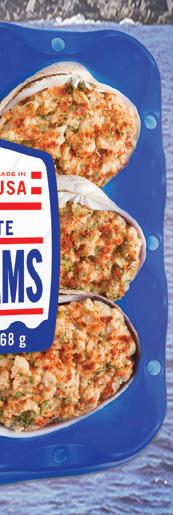







For all these reasons, the crowds continue to come up from New York and down from Boston and from much farther afield, long after the pleasure cruisers in the marina next door have been shrink-wrapped for the winter. The typical season runs from mid-April through New Year’s Eve, and a large on-site party tent and some patio heaters offer a makeshift dining room. (At the time of this writing, Bacci was hoping to be able to reopen the restaurant sometime in May, pending state approval.)
It’s such a perfect little place that it squeezes the heart. There’s a German word, fernweh, that describes a feeling of homesickness for a place you’ve never been. Lobster Landing evokes those long-ago days when the whole coast was lined with little white shacks. May no storm wash it away. May the crowds keep coming.




152 Commerce St., Clinton, CT. 860-669-2005; Facebook






 BY AMY TRAVERSO
BY AMY TRAVERSO
t’s so easy to get ratatouille wrong. The main culprit is undercooked eggplant; the primary accomplice is a thin, watery sauce. You know what I mean. Picture that squeaky chunk of wet eggplant and think, Why is this woman trying to ruin my appetite in her food column ?
It’s because I have a solution, dear reader! And not only does this ratatouille variation solve these problems, it also takes the cooking out of your kitchen and onto the grill, which is a relief this time of year. (Side note: ratatouille is a braised summer vegetable dish from the south of France. How hot is that French kitchen on ratatouille day?)
The solution is to caramelize all the vegetables (except the tomatoes) over the direct heat of a grill before topping them with an herby, garlicky dressing that evokes pesto (or pistou , as the French call it) but with a lemony edge and a dash of honey. I promise you’ll love it. And if you want to turn it into something more substantial, you can always add slices of fresh mozzarella and serve it with a nice baguette. Bon appétit!
1 eggplant (about 1½ pounds)
1½ tablespoons plus ½ teaspoon kosher salt
2 tablespoons plus 3 tablespoons olive oil
2 red bell peppers
1 yellow squash
2 zucchini
½ teaspoon black pepper
2 cups multicolored grape or cherry tomatoes, halved
1/3 cup toasted pine nuts
1 cup firmly packed parsley leaves and thin stems
1 cup firmly packed basil leaves and thin stems
1 large garlic clove, roughly chopped
½ cup extra-virgin olive oil
3 tablespoons fresh lemon juice
3 tablespoons water
1 tablespoon honey
¼ teaspoon kosher salt
First, prepare the eggplant: Remove the stem end, then cut lengthwise into ½-inch-thick slabs and arrange on a baking sheet. Salt all the cut sides with 1½ tablespoons kosher salt and let sit for 15 minutes.
Meanwhile, prepare a gas or charcoal grill for direct, medium-high heat (about 375°).
Rinse the eggplant and pat dry. Brush with 2 tablespoons olive oil.
the poem reads:
Now, prepare the other vegetables: Stem and seed the bell peppers, then quarter lengthwise and put into a large bowl. Slice the squash and zucchini lengthwise into ½-inchthick slabs and add to bowl. Drizzle with 3 tablespoons olive oil, ½ teaspoon kosher salt, and the black pepper; toss to coat.
Grill the vegetables in batches until they are nicely browned and tender, 3 to 4 minutes per side. Let them cool to room temperature while you make the dressing.
Combine all the dressing ingredients in a blender, and blend until smooth.
To assemble the salad, chop the grilled vegetables into bite-size pieces. Toss the tomatoes and grilled vegetables together in a serving bowl, then drizzle with half the dressing and sprinkle with pine nuts. Serve with remaining dressing on the side. Yields 8 servings.
Dear Reader,
THEPOEMREADS:
The drawing you see above is called The Promise. It is completely composed of dots of ink. After writing the poem, I worked with a quill pen and placed thousands of these dots, one at a time, to create this gift in honor of my youngest brother and his wife.
Dear Reader,
Now, I have decided to offer The Promise to those who share and value its sentiment. Each litho is numbered and signed by hand and precisely captures the detail of the drawing. As a wedding, anniversary or Valentine’s gift or simply as a standard for your own home, I believe you will find it most appropriate.
Measuring 14" by 16", it is available either fully-framed in a subtle copper tone with hand-cut double mats of pewter and rust at $145*, or in the mats alone at $105*. Please add $18.95 for insured shipping. Returns/exchanges within 30 days. My best wishes are with you.
The drawing you see above is called “The Promise.” It is completely composed of dots of ink. After writing the poem, I worked with a quill pen and placed thousands of these dots, one at a time, to create this gift in honor of my youngest brother and his wife.
Now, I have decided to offer “The Promise” to those who share and value its sentiment. Each litho is numbered and signed by hand and precisely captures the detail of the drawing. As a wedding, anniversary or Valentine’s gift or simply as a standard for your own home, I believe you will find it most appropriate.

Sextonart Inc. • P.O. Box 581 • Rutherford, CA 94573 (415) 989-1630
Measuring 14" by 16", it is available either fully framed in a subtle copper tone with hand-cut mats of pewter and rust at $110, or in the mats alone at $95. Please add $14.50 for insured shipping and packaging. Your satisfaction is completely guaranteed.

My best wishes are with you.
All major credit cards are welcomed. Please call between 10 a m -5 p m Pacific Standard Time, 7 days a week. Checks are also accepted. Please include a phone number.
*California residents please include 8.0% tax
MASTERCARD and VISA orders welcome. Please send card name, card number, address and expiration date, or phone (415) 989-1630 between noon-8 P M.EST. Checks are also accepted. Please allow 3 weeks for delivery.
Please visit our website at www.robertsexton.com
“Across the years I will walk with you— in deep, green forests; on shores of sand: and when our time on earth is through, in heaven, too, you will have my hand.”
“Across the years I will walk with you— in deep, green forests; on shores of sand: and when our time on earth is through, in heaven, too, you will have my hand,”


GLOUCESTER AND ROCKP ORT ARE
SUMMERTIME TREASURES HIDING IN PLAIN SIGHT.


 BY AMY TRAVERSO • PHOTOGRAPHS BY ADAM DETOUR
BY AMY TRAVERSO • PHOTOGRAPHS BY ADAM DETOUR


Whatever this stay-at-home era may bring, we at least have this certainty: The joy of travel is also in the anticipation. So let’s savor this moment of armchair wandering. And when the day finally comes to leave home and get back on the road, here’s what I’ll do: I’ll take my family to Good Harbor Beach in Gloucester and park at the very back of the lot, where a trail leads to the Annisquam River, which rises and falls with the Atlantic tides. There, we’ll read and body surf until we’re tired, and then we’ll drive over to the Lobster Pool in Rockport to eat fried fish sandwiches and watch the sun drop into Ipswich Bay. Before heading home, we’ll stop for penny candy at Tuck’s.
I hope that soon you can enjoy your own perfect weekend on this hidden coastline, a place so consistently overlooked by vacationers that locals call it, with a little sigh, the Other Cape. Part
of the reason for this is geographical: Cape Ann, of which bustling Gloucester and picturesque Rockport form the eastern margin, is less than an hour’s drive from Boston, making it a bedroom community for some. That whiff of suburbia can be a barrier to tourism, even though Cape Ann has a coastline with all the rocky beauty of Maine— plus a thriving arts community, great lodging and shopping, and a food scene that has attracted top chefs. Let’s hope they all stay. It took me too long to discover this treasure hiding in plain sight. Don’t miss out on another day.
Settle in and order up. The 2016 opening of the Beauport Hotel , an elegant 94-room establishment overlooking Pavilion Beach, was a watershed moment in Gloucester’s reemergence as a resort town. Shingled
and gambrel-roofed, it resembles New England’s grand old seaside hotels, and it stands in a neighborhood known as The Fort, which has long been the center of the fishing industry (the hotel’s rooftop pool, which offers full bar service, is named after the Birdseye plant that once stood here). While there are active commercial fishing docks behind the hotel, it is oriented toward the sea, with a stunning view of Ten Pound Island and the summer cottages along the southwestern shore. Rooms are done in a modern nautical style, and the restaurant serves a nice buffet brunch on the large terrace.
A more intimate though equally stylish option is the Addison Choate Hotel , whose seven rooms have all been recently redone. It’s just a stone’s throw from some of Rockport’s main attractions: Bearskin Neck (more on that later) and the iconic fish shack Motif No. 1.
R eady for dinner? Short & Main has been a foodie magnet in downtown Gloucester since opening in 2013. Owners Nico Monday and Amelia O’Reilly met while working at the famed Chez Panisse and bring a Califresh sensibility to the menu. Try the long-fermented, wood-fired pizzas (the sausage-rapini pie is terrific), the excellent crudo and other local seafood, and the seasonal salads that put local produce in the spotlight.

Eat, stroll, repeat.
Follow the locals to Sugar Magnolia’s in downtown Gloucester, where the pineapple fritters, breakfast sammies,
As I write this from the confines of self-quarantine, Cape Ann feels impossibly distant, though it’s less than 40 miles from where I sit. I call up memories of sunny summer afternoons and find the effort both a stretch and a salve. Perhaps by the time you read this, beach days will once again be possible.
opposite : Opened in 2016, Feather & Wedge puts an emphasis on freshcaught local seafood.
this page : One Ocean One Love typifies the small independent shops and galleries that fill arty Bearskin Neck.

Feeling a bit too full afterward? A perfect antidote is the docentled walking tour by the Cape Ann Museum that follows in the footsteps of artists like Edward Hopper, Fitz Henry Lane, and Winslow Homer. Circle back to the museum to admire its collection of contemporary works, bold-name artists, and stunning depictions of Gloucester’s fishing heyday in photographs, paintings, and artifacts.
Close by the museum, Virgiglio’s Bakery & Deli brings a Little Italy vibe to downtown Gloucester. Pick up a sub (try the North Ender: prosciutto, fresh mozzarella, sun-dried tomatoes, basil) and a cannoli or a flaky sfogliatelle pastry, which could match that of any North End bakery. Stop in for a book at the Bookstore of Gloucester, a top-notch indie, then stroll a few blocks for a picnic in the garden oasis of the Sargent House
, a 1782 Georgian home that once belonged to Judith Sargent Murray, a writer and early women’s rights activist (some works by her descendant John Singer Sargent are on display inside). If you could access the attic here, you’d see across the rooftops and the harbor all the way to Eastern Point, your next stop, which is a short drive away.

Soak up culture and commerce. The peninsula of Eastern Point has maintained an air of exclusivity since the 19th century, when one family owned it all and forbade public access. There’s still a guard at the entrance, but this seems mostly ceremonial, since everyone is invited to tour Beauport , the Sleeper-McCann House , operated by Historic New England. In a region rich in historic homes, this could be considered the crown jewel: a 40-room waterfront mansion designed by Henry Sleeper, the celebrity decorator of his day. He
conceived of Beauport as a series of showrooms, each done in a different style, from early colonial to Arts and Crafts to chinoiserie. It’s like entering a life-size dollhouse, a portal to a more glamorous era. No wonder Isabella Stewart Gardner was a frequent guest.
For an afternoon of wandering, Cape Ann offers two artsy-boutiquey neighborhoods: Bearskin Neck in Rockport and Rocky Neck in Gloucester. Both are worthy options, but with dinner in mind you may want to focus on the Bearskin, which is stuffed with boutiques, galleries, ice cream shops, and tourist brica-brac. Of note: Joe’s Fresh Fish Prints , where owner Joe Higgins practices the Japanese art of gyotaku , and Lula’s Pantry, a home goods








Discover the White Mountains of New Hampshire, where every adventure is an experience of a lifetime! The White Mountains are New England’s most desirable mountain destination. Experience 17 legendary attractions, the northeast’s highest peak-Mt. Washington, over 800,000 acres of magnificent mountain views, tax-free shopping and limitless outdoor recreation.







store with a coastal vibe. For a quick snack, check out Helmut’s Strudel , an Austrian pastry shop.
Enjoy a little night music. If you’re lucky enough to have tickets for a concert at Rockport’s stunning Shalin Liu Performance Center , with its floor-to-ceiling water-view window behind the stage, opt for an early (or late) dinner at Feather & Wedge , named after tools used to cut Rockport’s famous granite. It’s a small, chic sanctuary for seasonal fare. Sit at the bar for the local scene, or go for a table to better focus on that summer pea salad and locally made pasta with lobster and corn. Just be sure to reserve ahead.
Reach the beach.
Grab breakfast pastries and lunch sandwiches at Sandpiper Bakery, maker of croissants, seasonal scones, and ham and Brie on homemade focaccia.
Public beach parking lots fill up early but start to slowly empty out after 2 p.m., so plan accordingly. The best public-access beaches are Good Harbor and Wingaersheek , which both have parking and amenities, stunning views, and soft white sand. Good Harbor’s best feature is the comparatively warm water of the Annisquam River, which borders the southern end and carries lazy rafters down its final run to the sea. On the ocean side, waves here are more dramatic, but families with young kids love the river at low tide. Meanwhile, Wingaersheek has a long, shallow bay filled with smooth rocks that are perfect for climbing. At low tide, the shallow water goes on forever, ideal for wading and gazing out to Annisquam Light in the distance.
Let the sun go down on you. Honestly, the food at the Lobster Pool is only half the draw. This ramshackle restaurant offers solid fish-shack fare;

it’s the kind of place where it’s OK to show up with sandy feet. But what makes it a must-visit is its location on Folly Cove, with a sweeping view of Ipswich Bay. This is the northwest corner of the cape, and if you time it right and sit on the lawn, you’ll enjoy your lobster dinner and onion rings in the rosy light of a spectacular sunset. Regulars bring their own wine and watch the spectacle together, cheering as the last flare sinks into the deep. A perfect finale to a perfect weekend
TRAVEL NOTE: Since many businesses and venues are adjusting their operations in response to COVID-19 health concerns, please contact them directly or check their websites before making travel plans.

accolade.
Set in the heart of Woodstock, Vermont, our resort invites you to relish in an area rich in recreation and abundant in adventures. Here, thoughtful authenticity blends seamlessly with a classic resort experience to evoke a timeless elegance.
866-400-7551
WoodstockInn.com
Forty-five acres, 39 buildings, 22 gardens, over 100,000 items in the collection. A steamboat, carousel, locomotive, special exhibitions, paintings by Impressionist masters and American artists like Wyeth, Homer, and more. Located 10 minutes south of Burlington, VT.

802-895-3346
ShelburneMuseum.org
Sterling Ridge Resort is close to scenic Smugglers’ Notch, and offers private log cabins and homes. A perfect year-round getaway. Close to Wedding Barns, hiking, snow sports and more. Mention Yankee Magazine when you book to receive a sweet treat!

802-644-8265
SterlingRidgeResort.com
This historic inn where a Norman Rockwell painting comes to life offers 125 unique guest rooms, elegant and casual dining, live entertainment nightly, and an outdoor heated pool. Just down the road from Tanglewood, The Mount, and numerous other Berkshire cultural attractions.


413-298-5545
RedLionInn.com
Situated at the very tip of Cape Cod, Land’s End Inn is a unique boutique hotel offering some of the most stunning sea views and a luxury experience. Mention Yankee Magazine when you book and receive two complimentary Land’s End Inn mugs.

508-487-0706
LandsEndInn.com
The Warfield House Inn is a fantastic retreat in the Berkshire Mountains. This lovely location hosts a stunning wedding venue, breathtaking views, and an expansive list of outdoor activities such as white-water rafting, a worldclass zipline tour, a mountain roller coaster, and the best mountain bike park on the East Coast.
413-339-6617
BerkshireEast.org
PLIMOTH PLANTATION
PLYMOUTH, MA
A must-see New England destination that tells the story of Plymouth Colony in the early 1600s and its shared history with the Pilgrims and Native people. Visit the 17th-Century English Village, Wampanoag Homesite, and Plimoth Grist Mill.


508-746-1622
Plimoth.org
Experience the enchanting cottage that inspired Elizabeth Orton Jones’s Little Golden Books version of “Little Red Riding Hood.” Untouched by time, this is a mecca for gardeners, epicureans, and anyone looking for inspiration and relaxation. Have a Pickity day!

603-878-1151
PickityPlace.com
Gifts at 136 offers a large selection of fine crafts and art from Maine, including furniture, paintings, sculpture, jewelry, pottery, glassware, lighting, and more. Gifts at 136 has won multiple awards for its wellcurated collection of accessible art. Open all year.
207-563-1011 • GiftsAt136.com
Experience life on a Vermont dairy farm. Country lodging and farm-fresh meals served family style. Swimming, hiking, then home to feed the calves and milk the cows. Reunions, family, and friends welcome. Explore the heart of Vermont!
802-767-3926
LibertyHillFarm.com
Steps from downtown Bar Harbor, along majestic Frenchman Bay, this iconic property has been welcoming guests since 1887 with genuine hospitality, signature service, and timeless charm. Enjoy the area’s finest waterfront dining, accommodations, and spa services on this stunning eight-acre property.

844-249-3584
BarHarborInn.com
Considered one of the best academic museums in the country, the Colby College Museum of Art offers a vibrant exhibition program. It serves as a cultural resource to the Waterville community and visitors to the state. Always free and open to all!


207-859-5600
Colby.edu/museum
Reconnect with past Editors’ Choice winners and see for yourself why they received Yankee Magazine’s highest accolade.
GILFORD, NH
Enjoy a quarter mile of sandy beach and docks on the shores of Lake Winnipesaukee. Lakeside cottages, apartments, and rooms available. Great location for fishing, hiking, kayaking, boating, and more. Family owned and operated since 1890.


603-293-4321
AmesFarmInn.com
BLACK HERITAGE TRAIL OF NEW HAMSPIRE PORTSMOUTH, NH
“Forgotten. Buried. Denied. No More.” Experience Portsmouth’s rich Black history. Hear stories of Ona Marie Judge’s escape from George Washington. Visit the wharf where Africans were unloaded as cargo. See the memorialized site of a Colonial African burying ground, and more.

603-570-8469
blackheritagetrailnh.org
LYME, NH
A scenic lakeside family resort on Post Pond, near Dartmouth College, offering one- to threebedroom B&B or efficiency cabins. Easy access to lots of outdoor activities, area attractions, sightseeing and antiquing—or just relax at our sandy beach. Our Lodge Restaurant serves delicious, fresh local fare. Pet-friendly!
800-423-2141
LochLymeLodge.com
VILLAGE DISTRICT
HAMPTON, NH
Rediscover Hampton Beach, rated #1 in United States for water quality. FREE activities: Fireworks, Concerts, Sand Competition, Country Fest, Soccer on the Beach, Volleyball Tournaments, Children’s Festival, Talent Show, Circus Show, Fire Show. Check website for DATES.

603-926-8717
HamptonBeach.org
A family-owned hotel featuring two restaurants, fireplaces, indoor pool, and select pet-friendly rooms. Book direct and get free breakfast and tea. Complimentary transportation from Amtrak Downeaster station. Two blocks to L.L. Bean. Best shopping in New England.


800-342-6423
HarraseeketInn.com
AUTO ROAD
GORHAM, NH
Climb this historic 7.6-mile road to the summit of the Northeast’s highest peak— drive yourself, or take a guided tour. This must-do drive is America’s oldest manmade attraction. During the winter, take a tour on the Mt. Washington SnowCoach.

603-466-3988
MtWashingtonAutoRoad.com
Relax in the White Mountains at the majestic Red Jacket Mountain View Resort with spacious accommodations, excellent on-site dining, an indoor water park, and friendly, attentive service. Prefer an oceanfront getaway? Visit Red Jacket Resort’s five properties on Cape Cod.
800-752-2538
RedJacketMountainView.com
MOULTONBOROUGH, NH
Experience this stunning historic estate with unmatched views of Lake Winnipesaukee and the surrounding mountains. Tour the 1914 Arts and Crafts–style mansion, dine on the lake-view terrace, explore the estate’s 28 miles of trails and waterfalls, and more.


603-476-5900
CastleInTheClouds.org
plashing in the surf, wrapping little swimmers in hooded towels, shooing gulls from a snack of fried clams—these all become deposits in a parent’s memory bank that surge in value as kids edge closer to leaving the nest. And while any beach is a worthy destination when the mercury climbs, the following have a mix of amenities that make for truly unforgettable family outings.
With free nightly concerts, weekly fireworks, and mile-long boardwalk lined with food vendors, shops, and amusements, Hampton Beach is a powerful magnet for family fun even before you factor in the actual beach, where sand

and water provide nature’s finest building materials for the imagination. Here, kids catch crests on boogie boards in waters that have repeatedly been ranked among the cleanest in America by the Natural Resources Defense Council. hamptonbeach.org

At this play-all-day park on Long Island Sound, it’s a snap to grant every family member’s wish—even the startled toddler who commands, “No! Pool!” as ocean waves lap tiny toes. Yes, there is an Olympic-size pool as well as a spray park for tots; just steps

from the beach’s half mile of soft sand are amusement rides, water slides, and an ice cream shop. Older kids gravitate toward the nautical-themed mini golf course and Connecticut’s only beachside arcade, while grown-ups can drink in views of Ledge Light from a restaurant deck with a local beer in hand. Summer nights here are sprinkled with beach blanket movies, concerts, classic car cruises, and fireworks. 860-4473031; ocean-beach-park.com
There may be no better place for a youngster’s first foray into the ocean. Pale, powdery sand slopes gradually into the water. A breakwater just offshore means the waves are tame (and a bit warmer than the norm). Lifeguards keep watch; further reducing poten-
These stretches of sand have everything you and the kids need for a perfect summer day.clockwise from far left : Beachcombers can walk along tidal flats that stretch for miles at Cape Cod’s Skaket Beach; zipping down the water slides at Ocean Beach Park in Connecticut; boogie boarding for young surf lovers at New Hampshire’s Hampton Beach. TRAVEL NOTE: When making plans to hit the water this summer, don’t forget to check on beach accessibility and follow social distancing guidelines.
tial stress are restrooms and plentiful parking. There’s a playground to combat boredom, while Gansett Outfitters has sundries you may have forgotten. When hunger calls, Salty’s serves burgers, seafood, and ice cream sandwiches made with Rhode Island’s own Warwick Ice Cream and doughnuts from Allie’s Donuts. riparks.com
The appeal of Short Sands Beach lies in the nostalgic beach-town pleasures just a short stroll away: playing SkeeBall at the Fun-O-Rama arcade, shopping for souvenirs, queuing up for kiddie rides, and visiting the animals at York’s Wild Kingdom. When hunger strikes, grab lunch at the Goldenrod, where antique machines pull, cut, and wrap the saltwater taffy that’s been made here using the same recipe since 1896. Bonus: There’s another mile-plus of beach to explore one mile south, at Long Sands Beach, where sharp-eyed kids can find lucky sand dollars. 207-363-1040; yorkparksandrec.org






On Cape Cod’s sheltered bay side, the water is relatively warm and the surf never gets very high. And when the tide goes out, over a mile of sand is laid bare for young explorers. Plop an air mattress on the flats at low tide, and you can watch your kids find curious creatures in tide pools or race down the beach lofting kites. Walk toward Provincetown, and you’ll spy teens who’ve ridden inner tubes down Little Namskaket Creek waiting for the tide to whoosh them back in. Reach Rock Harbor, and you’ll encounter the lifeboat used in the 1952 rescue depicted in The Finest Hours. Craving more than snack-bar fare? Head to Sir Cricket’s for fresh fried seafood—but be sure to return to see the day’s last sunbeams toss glitter on the shallows. 508-240-3790; town.orleans.ma.us
This visit. Any visit. Stay with us. At Bar Harbor Hospitality Group, we provide warm, genuine Maine hospitality to all our guests by serving passionately and wholeheartedly. Season after season, it is about our guests and their adventures. Stay with us in Downeast Maine to experience Acadia National Park and Bar Harbor. Discover why we live here. | www.barharborhospitalitygroup.com














his year has been a trying one, to say the least. And whether this summer finds us still staying close to home or venturing out into the wider world, we want to share with you some of our region’s many beautiful rambles, scrambles, and uphill climbs that we have honored with Best of New England awards or showcased on NewEngland.com. In years past, these nature experiences have nour-
ished our souls, and we have no doubt they will do so again, when the time is right. These are, in a very real sense, our paths to recovery.
NEW HAMPSHIRE
CRAWFORD PATH, CARROLL: Best Epic Hike. More than two centuries after it was created, the nation’s oldest continuously maintained hiking trail, the Crawford Path, still delivers the rugged but accessible adventure that its founders envisioned. Running 8.2 miles (one way), it concentrates the White Mountains experience: steep ascents, sun-soaked plateaus, boulder-strewn peaks. Challeng-
ing climbs give way to flat stretches where hikers can linger and take in those panoramics before making the push to reach Mount Washington, the Northeast’s highest peak. fs.usda.gov/whitemountain
MOUNT MONADNOCK, JAFFREY: Best Day Hike.
It’s a National Natural Landmark and one of the most-climbed mountains in the world for a reason. Though you can take your pick from any of its beautiful trails, we recommend that first-time Monadnock hikers— or even first-time hikers, which is often the case at this mountain—head up to the top via the White Dot Trail and descend by way of the White Cross Trail (about 4.2 miles up and back). At the bald summit, surrounded by thousands of acres of protected highlands,
left : Established in 1819, New Hampshire’s Crawford Path winds more than eight miles through the southern Presidentials on the way to the summit of Mount Washington.
you can look out toward Boston, nearly 100 miles away. nhstateparks.org
MOUNT WILLARD TRAIL, HART’S LOCATION: Best Beginner Hike. If the thought of mountain climbing makes you sweat long before leaving your car, wipe your brow and give Mount Willard a try. In less than an hour after setting out on this 2.8-mile round-trip hike, you’ll make it to the peak, where stunning views of Crawford Notch stand before you. nhstateparks.org
GREGG TRAIL, GREENFIELD: Best WheelchairAccessible Trail. Hikers of all abilities can look for wild turkeys and patches of wild blueberries along this 1.6-mile path (roundtrip) ascending to the Knoll, with an observation deck overlooking a panorama that includes Mount Monadnock. The Gregg Trail and its neighbor, the 2-mile loop Dutton Brook Trail, are said to be the nation’s longest accessible trails in a mountainside environment. crotchedmountain.org
TRAVEL NOTE: In light of public health concerns, towns and parks may have closed or reduced access to their trails. Hikers should check with them directly before making any travel plans, and always follow social distancing guidelines on the trail.
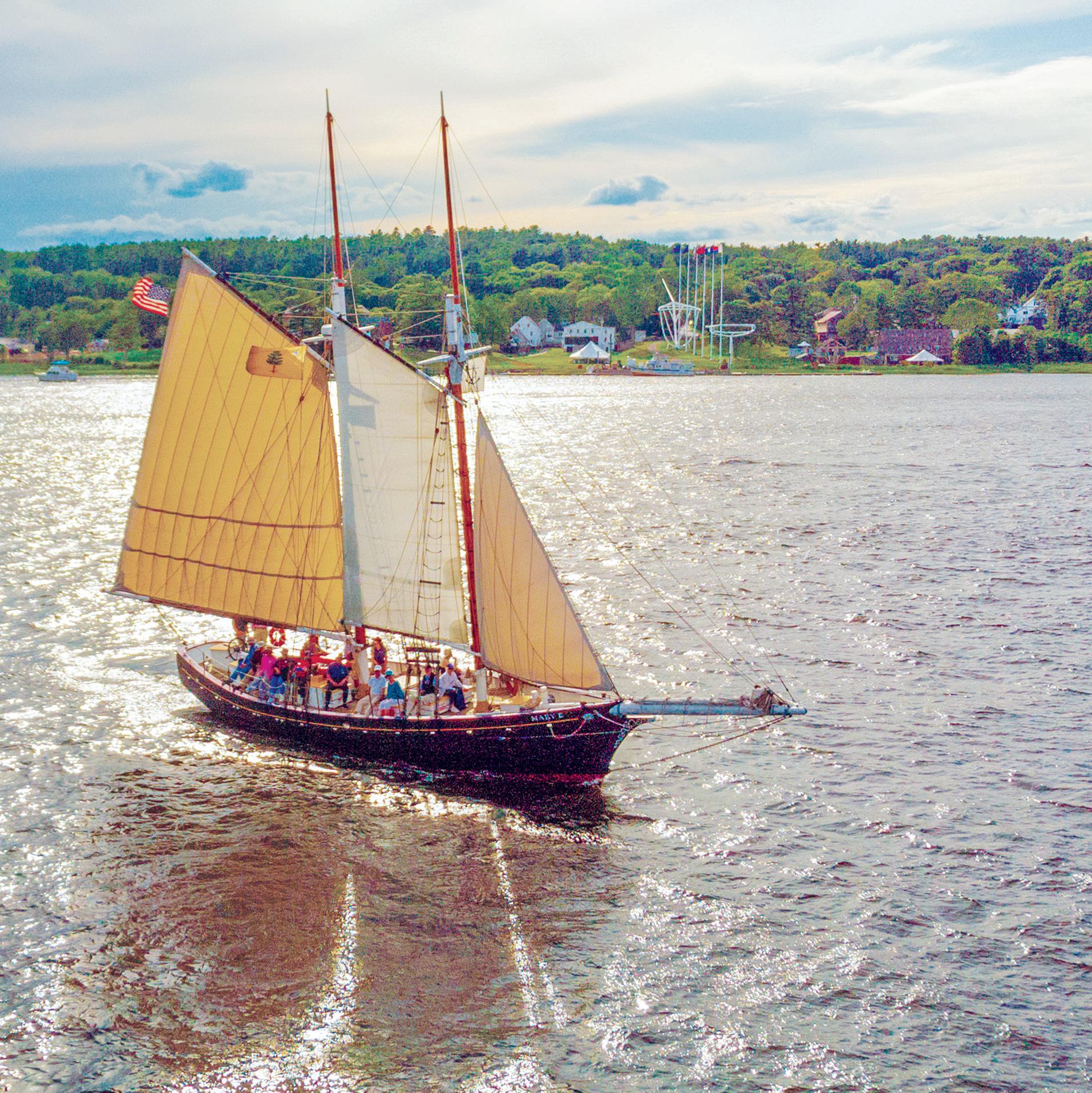


FLUME GORGE TRAIL, LINCOLN: Best Family Hike. One of New Hampshire’s most beloved natural attractions, the Flume Gorge is the main feature of an easy 2-mile walk through piney woods over hilly terrain. The setting is certainly dramatic: 90-foot cliffs, cascading falls, and the cool dampness of a primordial forest. But there’s also something appealingly Swiss Family Robinson–like about the network of cliffhugging boardwalks clinging to the walls of this deep granite beauty at the base of Mount Liberty. nhstateparks.org
MOUNT KEARSARGE, WARNER: Best Short Hike. This 1-mile loop begins in Rollins State Park on an old carriage road that ascends 300 vertical feet in half a mile, and from there it’s a quick scramble to the top of Mount Kearsarge, with its endless views of villages, lakes, and patchwork pastures. nhstateparks.org
BEAR MOUNTAIN TRAIL, SALISBURY: Best Day Hike. If you’re looking for the ultimate perspective for leaf peeping, heading to Connecticut’s highest peak (2,316 feet) is a good bet. This relatively steep 6-mile loop hike, which starts from the Undermountain Trail parking lot, eventually rewards hikers
with one of the prettiest vistas in the state, with mountain views to the north, south, and west, and lake views to the east. The route even follows a section of the legendary Appalachian Trail. ct.gov/deep
TALCOTT MOUNTAIN YELLOW TRAIL, SIMSBURY: Best Family Hike. While Talcott Mountain State Park has other routes to the top, the 2.5-mile Yellow Trail loop is a popular and family-friendly way to reach the summit and its 165-foot Heublein Tower. Prepare to pause often to admire the ever-expanding views of the verdant Farmington Valley; to the southeast, Hartford’s skyline juts up from the landscape, looking regal and remote. Kids will love climbing the tower, built as a summer residence in 1914. ct.gov/deep
SLEEPING GIANT TOWER TRAIL, HAMDEN: Best Easy Hike with Big Views. This trail starts at the picnic area across from Quinnipiac Uni-
versity and is a 1.6-mile hike one way to the summit of Mount Carmel, where you will find a beautiful stone observation tower that offers a fantastic vantage overlooking Long Island Sound and New Haven. A unique feature of this trail is the stone path, so plan your footwear accordingly. The trail is a part of Sleeping Giant State Park, named for the two miles of mountaintop that some say resemble just that: a sleeping giant. ct.gov/deep
HAYSTACK TOWER LOOP TRAIL, NORFOLK: Best Short Hike. The view from the Rapunzelesque three-story stone tower atop Haystack Mountain is worth the half hour or so of exertion it takes to scramble to the summit on this 1.8-mile loop trail. From the parking area, the short, steep hike is doable for most abilities. At 1,716 feet above sea level, the landscape seems to gleam and glow. Write a fairy-tale ending by packing a picnic. ct.gov/deep
JESSIE GERARD TRAIL, BARKHAMSTED: Best Quiet Fall Hike. Located in the 3,000-acreplus Peoples State Forest, the Jessie Gerard Trail is a moderate 2.6-mile loop featuring stone steps, challenging climbs, rocky cliffs, gorges, dense forest, and, ultimately, unforgettable fall foliage photo ops from the Grand Vista overlook. Travel farther north and take in even more incredible views from Chaugham Lookout. ct.gov/deep
MOUNT KATAHDIN, BAXTER STATE PARK: Best Epic Hike. There may be no bigger Maine bucket-list item for hikers than Katahdin and its Knife Edge Trail. Measuring slightly over a mile, the Knife Edge is just one segment of a strenuous summit climb that you can piece together out of the mountain’s network of trails. But oh, is it ever a memorable one: Some spots on this ridge traverse are as narrow as four feet, with 2,000-foot drops on either side. And at the end, the 5,267-foot Baxter Peak, with outof-this-world views. baxterstatepark.org
BOLD COAST TRAIL, CUTLER: Best Down East Hike. Keep it short or go the distance on this easy-to-moderate jaunt, set on Cutler Coast Public Reserved Land and winding through forests and wetlands to the wild and spectacular Bold Coast cliffs. Sightings of whales and porpoises are possible. Options include the relatively easy 2.8-mile out-and-back hike to the coast and 5- and 10-mile loops. maine.gov/dacf
MOUNT AGAMENTICUS, YORK: Best WheelchairAccessible Trail. Most visitors to Maine’s south coast head straight for the beach, and rightly so. But a detour to Mount Agamenticus, just a stone’s throw from the sandy playgrounds of Ogunquit and Wells, will reward you with one of the best “bang for your buck” hikes in the Pine Tree State. Of the trail options here, the universal-access Big A Trail is a 1-mile loop ideal for families, offering a wide path and benches for resting, and there’s a nature center at the top. agamenticus.org

MOXIE FALLS, THE FORKS: Best Waterfall Hike. One of New England’s highest and most dramatic waterfalls, with a single vertical drop of nearly 90 feet in addition to other plunges and pools, Moxie delivers a hefty reward for modest effort. The 1.2-mile (round-trip) trail begins on a wide swath through the woods, and then ascends via boardwalks and steps to the falls. kennebecvalley.org
SHIP HARBOR TRAIL, ACADIA NATIONAL PARK: Best Short Hike. Pick up a trail guide at the park visitors’ center and bring a picnic. This gentle 1.3-mile figure-eight hike passes through varied ecosystems, from moss-laden woods to pink granite ledges, and provides wonderful views of Acadia’s rocky coast. nps.gov/acad
RATTLESNAKE MOUNTAIN, RAYMOND: Best Family Hike. Don’t be deterred by the ominous reptilian name! Rattlesnake Mountain via the Bri-Mar Trail is a moderate 2.4-mile

out-and-back hike that—while steep in some places—is dog-friendly and kid-appropriate. Look for a great shot of Panther Pond just half a mile in. raymondmaine.org

BLACK POINT, NARRAGANSETT: Best Beachside Hike . Although Narragansett is best known for its sandy beaches, this 2.1-mile out-and-back stretch is more Maine than Rhode Island, with layers of rocks to clamber on, fish from, or hike beside. A former Narragansett Indian path, Black Point offers intriguing plants along the way, views of Point Judith Light, and mysterious stone ruins. narragansettri.gov
CLAY HEAD TRAIL, BLOCK ISLAND: Best Island Hike. First, this 3.5-mile out-and-back trail in Clay Head Preserve descends into a marshy area; then it climbs into a sunny meadow, all the while providing a low, rumbling thunder-like soundtrack from the crashing surf below. And then suddenly you’re there: at the edge of a high, sandy bluff, gazing across sparkling water to what in Block Island–speak is called “America,” or mainland Rhode Island. nature.org
LONG POND WOODS TRAIL, HOPKINTON: Best Hike with a View. Scramble over glacierdumped boulders and under mountain laurel on this roughly 4-mile out-and-back path. The expansive vista from high bluffs above Ell and Long ponds is truly breathtaking at this National Natural Landmark and wildlife refuge. And if the scenery looks familiar, it might be because part of the 2012 movie Moonrise Kingdom was filmed here. asri.org
NORMAN BIRD SANCTUARY, MIDDLETOWN: Best Nature Hike. With 300-plus acres of nature preserve and seven miles of trails— including a wheelchair-accessible path down to a viewing platform by the pond— hikers are treated to all types of terrain, from open fields to forests. Come armed with binoculars to spot swallows and sparrows, not to mention eye-popping panoramas of the Sakonnet River and the ocean. normanbirdsanctuary.org

ROME POINT TRAIL, SAUNDERSTOWN: Best Family Hike. This 2.4-mile loop in the John H. Chafee Nature Preserve is perfect for hikers and walkers of all skill levels (and their leashed pups). The trail starts inland and leads out to the bay, and the constant scenery change makes for an exciting quick trip. As a result, this trail—also known as the “seal hike” for its view of seals in the bay—is very popular during the summer, so to beat the crowds, make plans to go in the fall. riparks.com
CAMEL’S HUMP, DUXBURY & HUNTINGTON: Best Epic Hike. The distinctive mass of rock atop this 4,083-foot peak can be seen in the distance across northern Vermont. To stand atop that mighty summit, you’ll need two strong legs, an ample amount of water, and plenty of gorp to make it through your 6-mile
round-trip journey via the Monroe Trail (which is our go-to, but other routes are available). vtstateparks.com



BUTLER LODGE TRAIL, UNDERHILL: Best Quiet Fall Hike. There are many ways to climb Mount Mansfield, Vermont’s highest peak. For hikers who love life above the tree line, one of the lesser-traveled paths offers a straight shot to the ridge. From the trailhead on Stevensville Road in Underhill, Butler Lodge Trail warms up with a half mile through hardwoods before shooting steeply uphill. After 1.8 miles and 1,600 vertical feet, the trail arrives at its namesake structure, where you can rest before heading back down, or take some time to explore the krummholz (gnarled, windblown trees) via the Wampahoofus Trail). vtstateparks.com
SNAKE MOUNTAIN, ADDISON & WEYBRIDGE: Best Easy Hike with Big Views. Vermont’s Green Mountains may be the star attraction, but when you’re short on time and energy, you can’t beat Snake, a 1,287-foot outlier of the Taconic range that rises abruptly from the surrounding terrain to offer the state’s finest panorama of dairy lands, Lake Champlain, and the Adirondacks. Park in the lot on Mountain Road and walk less than a quarter mile to the well-marked trailhead on the left. Follow the Old Carriage Road 1.5 miles to the top, where you’ll find a cement platform from the 1870 Grand View Hotel that once stood here; now it’s a great spot for picnics. vtfishandwildlife.com
MOUNT PISGAH, WESTMORE: Best Hike in the Kingdom. Mount Pisgah rises above the southeastern edge of Lake Willoughby, the loveliest lake in the Northeast Kingdom, not to mention the state. This roughly 4-mile round-trip via the South Trail gives you a falcon’s-eye perspective on Willoughby’s waters, along with views of the Green and White mountains. If you have the stamina, tack on the North Trail or East Trail. vtstateparks.com
STERLING POND TRAIL, JEFFERSONVILLE: Best Quiet Fall Hike. This moderate trail in Smugglers’ Notch State Park is about 2.8 miles out and back, and while steep and rocky in some portions, the path is well maintained and leads to gorgeous views— and Vermont’s highest-elevation trout pond, to boot. Sterling Pond has been described as “idyllic” and is a great escape during the quieter fall months. vtstateparks.com
SKYLINE LOOP, MILTON: Best Hike Near Boston. Great Blue Hill (635 feet), just south of Boston, is the highest peak in the Blue Hills Reservation and also the highest summit south of Maine that’s near the Atlantic Ocean. In just three miles round-trip, hikers can hit several summits in the Blue Hills range, including Great Blue Hill, and visit Eliot Tower and the Blue Hill Observatory. Additionally, the reservation has 125 miles of trails with a range of easy to rugged terrain, so there are plentiful opportunities to add on to or switch up your
hike. (Note: If you have the stamina, the full Skyline Trail runs nine miles from start to finish.) mass.gov/dcr





SOUTH SUGARLOAF TRAIL, SOUTH DEERFIELD: Best Short Hike. Not to be confused with its much bigger cousin in Maine, this Sugarloaf Mountain is, for nature lovers, a literal sweet spot. The 1.4-mile loop trail to the south summit is short yet steep enough to get the endorphins going, and the 652foot summit, crowned with an observation tower, is an unbeatable perch for gazing out over the Connecticut River, the Pelham Hills and Berkshire Hills, and the Pioneer Valley towns of Deerfield, Sunderland, and Amherst. mass.gov/dcr
STONY LEDGE, WILLIAMSTOWN: Best Easy Hike with Big Views. You can sidestep the exertion of summiting Mount Greylock, Massachusetts’s highest peak, while still reaping its visual rewards when you stride up the 1.9-mile-long unpaved Sperry Road to the Stony Ledge outlook. It offers a vertiginous 1,400-foot view into the Hopper, a steep-sided bowl notable for old-growth woods, with a majestic panorama of the Bay State’s highest peaks. mass.gov/dcr
WACHUSETT MOUNTAIN, PRINCETON: Best Choose-Your-Own-Adventure Hike. Dubbed the “Observatory of Massachusetts” by Thoreau, Wachusett Mountain is the loftiest peak within a reasonable traveling distance from Boston. The versatile mountain, which is set on its namesake 3,000-acre state reservation, beckons to hikers of all levels with 17 miles of well-marked trails traversing forests and meadows, streams, and ponds. You can take the 3-mile out-and-back Harrington Trail straight to the 2,006-feet summit, or put together a loop out of any of the dozen or so marked routes. mass.gov/dcr



MONUMENT MOUNTAIN, GREAT BARRINGTON: Best Quiet Fall Hike. A moderate 3-mile loop—up the Hickey Trail and back down the Indian Monument Trail—leads to a natural oasis with great views. It’s a popular route during the warmer weather months, so taking a trip during the fall often provides an escape from the typical traffic. Some areas of the trail are steep, but a few scrambles will afford you a big payoff: foliage colors seen from the summit, rippling across the Housatonic River Valley and the southern Berkshires. thetrustees.org
MIDDLESEX FELLS RESERVATION, STONEHAM: Best Hike for Families. With 2,575 acres spanning five towns, a range of terrain, and a no-excuses travel distance from Boston, Middlesex Fells Reservation is an ideal destination for outdoor activities of all kinds. There are a number of beautiful natural features at the Fells, including Sheepfold Meadow, a 10-acre open field, and Wright’s Tower, which looks out over the Boston Basin, plus ponds and plenty of wooded areas. Budding naturalists will love the easy, mile-long Long Pond Nature Trail, which has a nature pamphlet describing plants, animals, and geology along the way. mass.gov/dcr





EPISODE 1 - DEEP ROOTS: Tour Boston’s Chinatown & make dumplings, visit the Weekapaug Inn Westerly, RI, for natural beauty and culinary treats, and learn about special farmers in Tiverton, RI.

EPISODE 2 - ARTS AND THE SEA: Visit the oldest a capella group in the U.S. In Salem, MA, grand-scale murals. In Portland, ME, meet Barton Seaver, who combines his passion for food with his commitment to sustainability. Take a tour of the PEZ factory.
EPISODE 3 - WALK ON THE WILD SIDE: Take a tour of the Mystic Aquarium in Connecticut. in Gray, Maine, visit a sanctuary for injured and orphaned wildlife. In New Hampshire, Amy Traverso goes crabbing and cooks her catch into a mouthwatering seafood stew.
EPISODE 4 - TREASURES FROM THE EARTH: Amy gets to build a table by hand, using sustainably sourced wood. In Maine, Richard Wiese unearths the state gemstone: tourmaline. Chef Justin Walker and his wife put a modern spin on a traditional Maine bean-hole supper.
EPISODE 5 - TO THE TOP: In Connecticut, Dorie Greenspan whips up a delicious parsnip and cranberry layer cake. In New Hampshire, Richard goes rock climbing. On Martha’s Vineyard, architect Patrick Ahearn takes us on a tour of his favorite preservation projects.



EPISODE 6 - ADVENTUROUS SPIRIT: In New Hampshire, chef David Vargas uses tortillas crafted from locally grown corn, Richard hops on an ATV, and we go hang gliding at sunset. And, on Martha’s Vineyard it’s Grand Illumination Night, featuring homes decorated with paper lanterns.
EPISODE 7 - HANDMADE IN NEW ENGLAND: Visit an acclaimed vineyard in Barnard, VT. At Swans Island Company in Northport, ME, sheep’s wool is hand dyed and woven by hand to create blankets and scarves. In Mystic, CT, hop aboard the newly restored Mayflower II



EPISODE 8 - OCEAN TREASURES: Visit Provincetown, MA, a beloved destination. See the packed schedule at the Music Hall in Portsmouth, NH. In Maine, see how a lobster roll company grew into a sustainable seafood company and get a peek into the factory.


EPISODE 9 - DELICACIES FROM NEW ENGLAND: On Potter Pond in Kingstown, RI, meet the owner of Matunuck Oyster Farm and Bar. Visit the Thompson House Eatery in historic Jackson, NH, a landmark in the community. Then see the copper stills at Wiggly Bridge Distillery in York, ME.
EPISODE 10 - TOURING WITH THE LOCALS: In Provincetown, MA, meet a maritime treasure er. In Portland, ME, tour the iconic B&M Factory, where they make canned brown bread, a unique New England treat. In Providence, RI, learn why this tiny state has so many unique dishes.
EPISODE 11 - A BREATH OF FRESH AIR: Comedian John Hodgman visits his hometown of Brookline, MA. In Bartlett, NH, Richard Wiese ice climbs Cathedral Ledge. Then head to the Andres Institute of Art, where the more than 80 sculptures are designed to withstand the elements.
EPISODE 12 - JOIN THE CLUB: In South Hamilton, MA, visit the Myopia Polo Club. In Freedom, NH, find out how to build a fire and shelter. On Martha’s Vineyard, follow the African American Heritage Trail and take a dip in the ocean with the Inkwell Beach Polar Bears.
EPISODE 13 - HEADING NORTH: Killington Resort hosts Women’s World Cup Skiing. In Walpole, NH, Eric Aho works on his famed Ice Cut paintings. See the monumental murals by José Clemente Orozco at Dartmouth College in Hanover, NH. Visit Twin Farms in Barnard, VT.
Sneak preview in Create Showcase July 17-23

FUNDED BY: BROUGHT TO YOU BY:

 Photo by Mark Fleming
Photo by Mark Fleming
Once discovered, Maine’s Blue Hill Peninsula and

Deer Isle are impossible to forget.

Peninsula and Deer Isle compose one of the largest blank areas on the map of coastal Maine. It’s a wedge of coastline, vaguely reminiscent of a semicolon, that requires about an hour’s drive from either Ellsworth or Bucksport to reach Stonington, at the southern tip. The peninsula and the isle are separated by Eggemoggin Reach, and on a map it looks as if the island is trying to slip away from the peninsula but is being held in place by a single stitch, namely the Deer Isle suspension bridge.

The region is not technically blank, of course. In truth it is filled with narrow roads that swoop and rise, which often makes driving here feel like low-altitude flying. There are also people, though not many. The major towns are Blue Hill (population 2,686), Castine (1,010), and Stonington (1,032).
Yet the region tends to remain mostly blank in the popular imagination. It’s not quite midcoast, and it’s not Down East. Tourists overlook it partly because it’s sandwiched between two of the state’s most popular natural attractions: Penobscot Bay to the west, Mount Desert Island to the east. They scurry from one to the other, hustling along Route 1, following the commands of Siri or Alexa or whoever, scarcely aware of what lies south. In a more sensible world, the Penobscot Narrows Bridge would be trumpeted as the Gateway to the Blue Hill Peninsula and Deer Isle. Instead, it merely marks where you make a right turn along the coast before pressing the accelerator and aiming for Acadia National Park.
On this peninsula and island, with their feathering fogs and pink granite islands, summer hangs easily, like a pair of favorite jeans, frayed around the cuffs and loose at the waist. The best summer, the region seems to suggest, is one you might not even have noticed. Summer is not a verb here. It’s barely a conjunction between spring and fall.
It’s not as if everything is understated, though. You can find the monumental between the cracks. Head to Harriman Point Preserve near Brooklin, or visit the Deer Isle walking trail out to Barred Island, and you will be rewarded with vis-
tas that make you want to linger. The same can be said of the sweet pepper and leek soup with crab at Aragosta, the area’s best restaurant—which also takes some sleuthing, with the reward of something grand—or even the pink peppercorn chocolates made by Blossom Kravitz at Brooklin Candy. It’s the hidden things that define this region.
Bill Henderson, he was sitting on the small, low porch of his bookstore and had just returned from getting his car repaired. “Ellsworth is a nightmare,” he announced, before bemoaning the traffic, the big box stores, the tourists slogging their way to Acadia and back. “Every summer I swear I’ll never go to Ellsworth.”
Ellsworth is just 20 minutes from his summer home outside the village of Blue Hill, but it feels a world away from the rustic life that Henderson has crafted for himself and his family on a wooded ridge across from a meadow. The sign on his shop deems it the “World’s Smallest Bookstore,” and while the claim is difficult to verify, I found little cause to question it after a quick look—the only kind of look you can have, really. The store is the size of a large woodshed, and stocked with a strikingly literary array of volumes he’s rescued from the dump and gleaned from yard sales. A handwritten note on a table near the door reads, “Please leave payments in this can.”
The store also sells a number of Pushcart Prize anthologies, and the reason is simple: Henderson is the founder of Pushcart Press, which since 1972 has been “devoted to writers, small presses, and non-commercial publishing.” Hailed by Publishers Weekly as one of the nation’s most influential publishers, Pushcart honors the year’s best writing from the small presses—fiction, poetry, essays— with inclusion in its annual anthologies.
The raspy late-summer sound of crickets pulsed and
On this peninsula and island, with their feathering fogs and pink granite islands, summer hangs easily, like a pair of favorite jeans, frayed around the cuffs and loose at the waist.

this page , clockwise from top left : Apples grown for cider at the Sow’s Ear Winery; Brooklin Inn co-owner Pi Piraeus fine-tunes a flower arrangement; a quiet corner of Buck’s Harbor in Brooksville; a plate from Stonington’s Acadia House
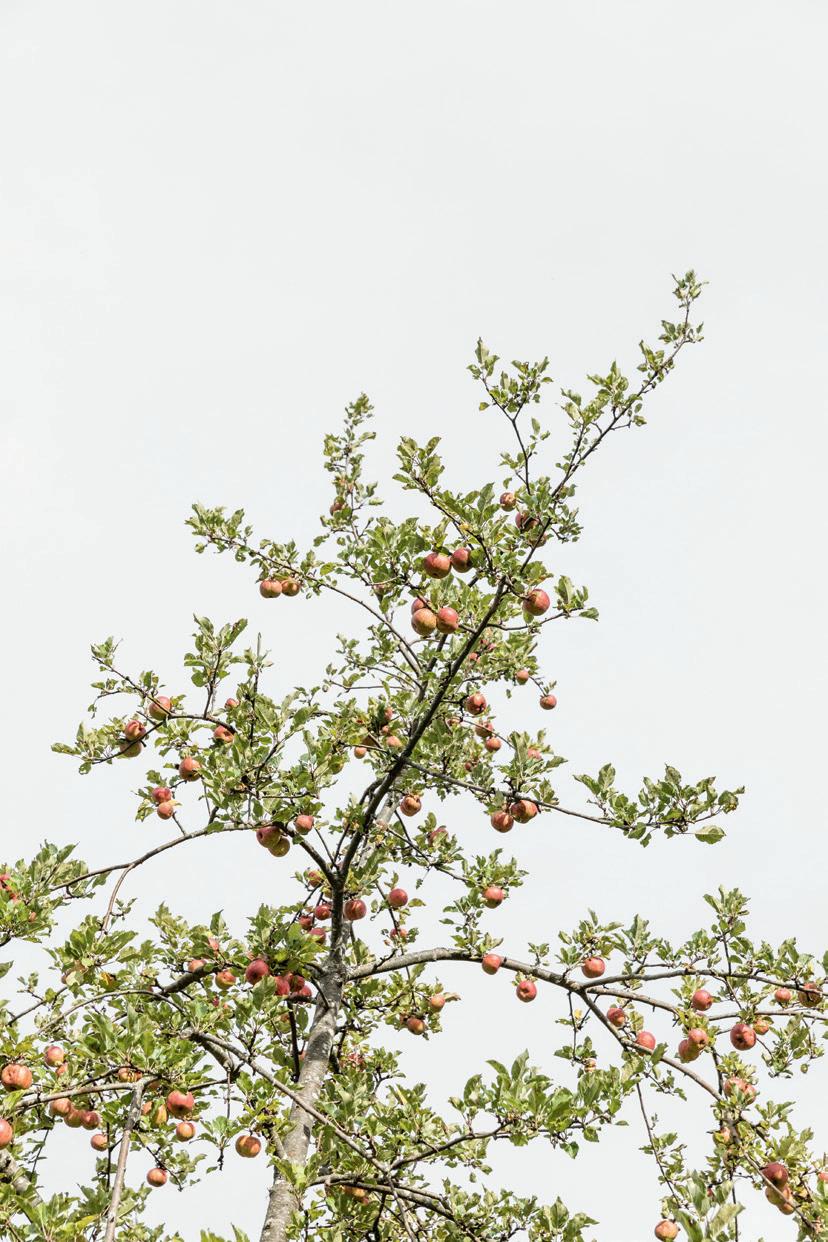

Provisions starring duck morsels and blueberry-truffle jus ; Blue Hill resident Noel Paul Stookey (of Peter, Paul, and Mary fame).



ebbed, and we were interrupted by a passing truck. “A rare truck,” Henderson noted. Moments later, a car went by. “And another damned car,” he said.

Henderson and his family, who live the rest of the year in New York, have been coming to this part of Maine for more than 30 years. In 1995, he bought this land and started building. He began by constructing a not-entirely-useful threestory tower, having brought to this venture little knowledge of carpentry but a known fear of heights. He wanted to challenge himself, and he wanted a view of the distant bay, so he figured it out as he went along. “I built it all with hammer and saw,” he said. “No power tools.” His book Tower: Faith, Vertigo and Amateur Construction chronicles that deep-seated drive to build. (“A strange and fascinating book,” said the Los Angeles Times Book Review.)

Henderson, wearing a knit cap and a jacket the color of fallen autumn leaves, rose to show me around. He’s 79 but moved with a wiry spryness as he pointed out some of the other buildings he’s built, including the family’s main summer cottage, a roundhouse, a studio for his wife, and an eightby-eight-foot cabin for his daughter.
“There’s a whole different feeling up here from the rest of the world, especially when you’re around frantic New Yorkers and everybody’s got an angle and an agenda,” he said. “I don’t find that up here. People stick together. They’re neighborhood people, and they help out.”
The Blue Hill Peninsula has become known for its colony of writers, including the novelists Jonathan Lethem (who deejays occasional fund-raising dance parties in a local barn), Michael Chabon, Edmund White, Ben Marcus, and Heidi Julavits.

In her essay collection titled The Folded Clock , Julavits notes that an earlier generation of writers had washed up in the town of Castine, on the western side of the peninsula, with Robert Lowell, Elizabeth Hardwick, and Jean Stafford among them. This led to Stafford’s writing a short story called “An Influx of Poets.”

“I will never write a story called ‘An Influx of Fiction Writers,’ even though there are many fiction writers in my town,” Julavits writes. “More come every year, but we don’t sit around reading our stories out loud to each other. Mostly we talk about old barns and how to keep them from falling down.”
A writer who once lived in this region and wrote a bit about barns was E.B White. He was a summer person who became a winter person, and he lived at his coastal farm in Brooklin until his death in 1985. He valued his privacy but was happy to share the Maine he knew with his readers. Through his essays for The New Yorker and his books—notably, Charlotte’s Web —he crafted a Maine that is stubborn but endearing, flinty but endowed with moments of grace. White’s writing is lyrical and filled with spare yet elegant turns of phrase, and it has done much to influence the way outsiders view this state.
One could argue that this role now belongs to John Hodgman, a writer and former The Daily Show guest star who may
be best known for playing the stodgy “PC guy” in Apple’s “Get a Mac” ad campaign. Hodgman applied his own take on Maine in his 2017 book, Vacationland , and to a lesser degree in last year’s Medallion Status . He writes adroitly about getting to know his neighbors, and about how he, an avowed Brooklynite, has come to understand Maine. He can be as understated as White but with a more deadpan humor. “These beaches are not for relaxing on,” he told me when extolling the region’s virtues. “They are for existential crises—for sitting on the beach and thinking about death.”

Hodgman first came to Maine at the behest of his wife, who visited family here each summer. Her grandmother was a “from away” who eventually moved here permanently, as did one of her sons. Summer visits led to Hodgman and his wife buying a house on a nearby peninsula, and spending as much time there as possible.
One way a region regenerates is by summer people becom ing year-round people, which seeds another generation, and Hodgman spoke of his hope of moving here year-round one day. Of course, dreaming about being a full-time resident of coastal Maine is a time-honored way to pass a summer while basking in the fleeting warmth of the sun. This dream often fades when one visits the icebound coast in dark months. Yet Hodgman has been dipping his toe into winter here with holiday trips, and the experience hasn’t fully dissuaded him.
“It’s very social,” he said, admitting that this came as a bit of a surprise—he had expected a more solitary exis tence, based on his wife’s memories of doing nothing and seeing no one while at her grandmother’s. “What we didn’t anticipate until we moved here was the number of fascinat ing people—all the interesting dreamers who had gotten to know each other.”
And he has noticed more young people starting to drift in. “A young family moved onto our road about a half mile away, then went from door to door introducing themselves to all their neighbors,” he said. “It was very unnerving to have someone knock on your door in Maine. But they’re a lovely young couple, and I hope they’re thriving.
“One day we want to disappear into the peninsula with our own weird dreams,” he said. “It’s a different planet. It’s a reminder that the monoculture that we think we live in—on the Internet and Twitter and in certain big cities—is really not true. There’s a lot of really intense regionalism in the United States, and that’s fascinating to reckon with.”
areas everywhere, residents on the Blue Hill Peninsula and Deer Isle have been trying to figure out how to keep their
“There’s a whole different feeling up here from the rest of the world…. People stick together. They’re neighborhood people, and they help out.”
clockwise from left : Stacks of fishing gear underscore Stonington’s identity as the state’s lobster capital; dinner is served during pizza night at Tinder Hearth, a bakery in Brooksville; ceramics artist Andile Dyalvane at Haystack Mountain School of Crafts, where he recently led a workshop on South African vessels.
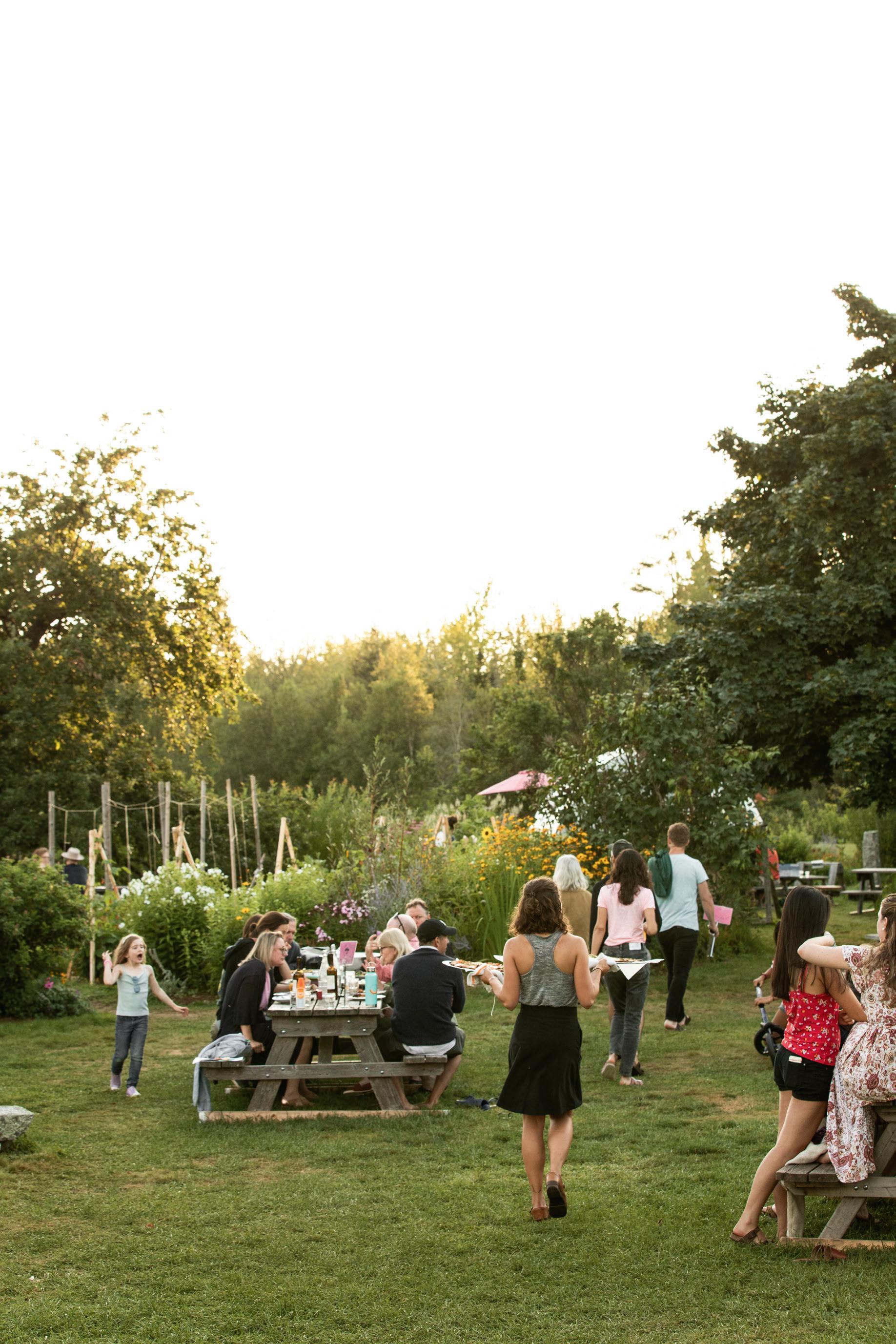



kids from drifting off to job-filled cities after high school. While lobster fishing continues to offer a vocation, other local routes to adulthood have traditionally involved industries that now have largely dried up, like commercial farming and quarry work.

Yet Deer Isle and Blue Hill have been seeing a positive trend of late: a trickle of entrepreneurs, many of whom are homegrown. They are sometimes the offspring of the backto-the-landers who drifted here, seeking simplicity and community, as they followed in the wake of Helen and Scott Nearing. (The Nearings were early back-to-the-land evangelists who built a largely self-sufficient compound in Brooksville in 1952; their influential book Living the Good Life was published two years later.) These local entrepreneurs, in turn, are attracting other folks—many in their 20s and 30s—who have been arriving with an idea of settling down and starting their own businesses.
“My niece lived with us about 20 years ago and there was nothing for her here, so she moved away,” said Peter Beerits, an artist and entrepreneur who lives on Deer Isle. But migration patterns started to slow and then reverse about a decade ago, he said. “I started to notice all these young people here in winter.”
Beerits has been on Deer Isle for 35 years, having first visited with his parents on summer trips. “It was a place where the world was completely different, and that’s what I was looking for,” he said.

In 1984, he founded Nervous Nellie’s Jams and Jellies, initially turning out batches six jars at a time and selling to national accounts through fancy food shows. Business lagged, but then he started catering more to locals and travelers, and sales blossomed. He hired a cook, and then an assistant cook. “But what I really wanted to do was build Nellieville,” he said.
Nellieville is essentially an immersive, village-size artwork that occupies a few acres of woods and clearings around Beerits’s store. It’s Tim Burton meets Wes Anderson: a little bit charming and a little bit puzzling. Multistory castles are filled with knights, and a country grocery store with blues musicians. The human-form sculptures are made of welded scrap—engine parts, lighting fixtures— and set amid rough-hewn architecture. Most of the characters have large and lugubrious faces, as if saggy from life.
Beerits has created a visually complex and memorable world filled with the strange and improbable, such as a conveyor belt disgorging bright gold ducks as if from a duck forge. At the store, I asked his wife, Ann, where he
got his ideas. “Artists are just filled with ideas,” she said, “and have to find a way to let them out.”
A few minutes’ drive away is the Haystack Mountain School of Crafts. It was built in 1961, designed by modernist architect Edward Larrabee Barnes. Like Nellieville, the campus has soft, dreamlike qualities, with shingle-sided workshops, a dining hall, and other buildings built on piers and connected by boardwalks, so that the whole of it seems to hovers a foot or two above mosses, lichens, and ferns. A broad outdoor stairway leads to a platform overlooking Western Cove. The dreamlike effect is enhanced in a fog.
“This place is sort of built for Instagram,” said Paul Sacaridiz, the school’s executive director. “Everything is in a square format.”
His comment arose in a discussion about how the school has adapted to changing times over nearly six decades. In many ways, the world has simply caught up to Haystack—it was among the first of what are now called maker spaces. And thanks to Etsy and other craft platforms, goods made by hand have become more mainstream. “Even The New York Times is saying that pottery is the new Pilates,” Sacaridiz said with a laugh.
Haystack has followed craft where it’s led, and that has ushered the school into the high-tech world. (When Haystack opened, pottery students did all their work by hand
because using molds for ceramics was forbidden.) Sacaridiz walked me to the Fab Lab, which opened about a decade ago. A digital-fabrication laboratory created in partnership with MIT’s Center for Bits and Atoms, it allows students to make, well, just about anything they can imagine. The students of 1961 would have found the equipment here inscrutable: an Epilog Legend 24TaT 35-watt laser cutter and a Sindoh 3DWOX filament printer, to name two. There are even 3-D printers that can replicate themselves by making each of their component parts.
Among Sacaridiz’s goals has been to make the school less insular and more connected to the community. Haystack launched a local internship in digital fabrication this past winter, and has invited area high school students to use its equipment.
Sacaridiz, too, has noticed the rise of younger islanders. “There’s this new entrepreneurship happening, particularly among those in their 30s, and they seem to be attracting others.”
He suggested I visit 44 North Coffee, a roaster owned by two young women who have opened a pair of shops in Stonington, on the southern tip of Deer Isle. “Viewed


“One day we want to disappear into the peninsula with our own weird dreams,” John Hodgman says. “It’s a different planet.”
from the outside, these would seem telltale signs of gentrification,” he said, except that the business is native-born, and the owners are sensitive to making it comfortable for everyone, fishermen as well as tourists.
“From my perspective,” he said, “they are the linchpin, the site from which things are bubbling up and making people pay attention. You should go.”
night when I walked into 44 North, which during the day is a place for cappuccinos and muffins. People were lined up to buy a glass of wine and order a dozen shucked raw oysters or two before settling in at the tables, whose tops are made of island pine and legs of metal salvaged from repair work on the Deer Isle bridge.
Melissa Raftery and Megan Dewey-Wood started 44 North a decade ago. Dewey-Wood grew up on the island, and after making friends with Raftery, a former river rafting guide, discovered they had a shared fondness for gourmet coffee. They started ordering from different craft roasters around the country, and at one point they wondered, How much would a roaster cost?
They launched 44 North on the second floor of the old Deer Isle schoolhouse, and sold their first bag of coffee in 2010. They’ve since expanded with a summer café in Stonington and another in the village of Deer Isle, where they now do all their roasting. They sell coffee at retail and have about four dozen wholesale accounts in the summer, maybe half that in the winter. They also sell online, which makes winter survival more feasible.
Their business is part of a larger shift, as a new generation revisits food production—although now turning from the commodity farming of early island residents to something more artisanal, creating added value. It’s a sensible approach, as Maine has a sound reputation for its fruits, organic produce, and fresh seafood, and that can help open doors.
At Oyster Night at 44 North, Abby Barrows was shucking oysters and greeting customers. She was one of the children that came out of the earlier influx—her father moved here in the late 1960s and bought the local newspaper. Barrows left the island to study science, focusing on ocean ecosystems at the University of Tasmania (“There was a lot of diving and looking at sea horses,” she said). She eventually returned home, bringing her knowledge from afar to her erstwhile backyard.
“I had to leave it to love it,” she said. At first she worked on a lobster boat and found jobs monitoring water quality. Then in 2008, she called a local oyster farmer to inquire about buying oysters. “I don’t have any oysters,” she was told. “Do you want to buy the farm?”
She did, and then began the process of becoming a sea farmer. Starting with about 5,000 oysters from the previous owner, she has since built that up to about 200,000. “And I can move every oyster I grow on the island,” she
said. She has a few wholesale accounts but mostly sells direct to consumers, including here on Oyster Night, as well as the summer night market.
Barrows is pleased that a wave of young islanders is moving in, including those without previous roots on the island. “I have three friends who bought houses in the last year and a half, and none had ties here before,” she said. And while the influx is new in her lifetime, she sees in it an echo of the wave that brought her dad and others looking to flee the cities a generation ago.
She assumes that dramatic changes are on the horizon: As ocean waters warm globally, there’s likely to be an impact on the lobster fishery, and to adapt, fishermen will need to shift into other careers. “The only way to thrive is to borrow, interact, and communicate with everyone,” she said. “One of the reasons for getting into aquaculture is that it’s one of the most sustainable fisheries on the planet, and it’s probably going be a major source of protein for the masses. It can be a model for the fisheries industry here. Fishermen can shift, but still use a lifetime’s worth of skills and knowledge with sustainable fisheries.”
a celebrity lobster appeared in Stonington. Exactly half of it was a mottled black-green, like the ones that local fishermen see every day; the other half was bright orange, as if fresh from the pot. The line between the colors was precise, as if someone had fabricated it as a novelty using a 3-D printer.
The lobster was residing temporarily at the Maine Center for Coastal Fisheries, on a wharf in Stonington, and when I stopped by, docent Leroy Weed Sr. took it out and rested it on his forearm so that a few of us could examine it and snap pictures. The lobster seemed complacent, even a little bored, as if resigned to its fate as an Instagram star.
Lesser celebrities also occupied the tank: a blue lobster and a calico one. “This one is a one-in-two-million lobster,” Weed said, pointing to the blue. And the calico: “This is one in 30 million.” The half-and-half? “One in 50 million.” I cocked an appreciative eyebrow and nodded, marveling that someone somewhere had the job of calculating the odds on freakish lobsters.
In earlier times, the appearance of unusual animals was viewed as a harbinger of one fate or another. And on this day, and at this place, I had to believe this was also a sign— that a new cultural model was at hand, a mix of “from away” and “from here” that would allow the peninsula and island to thrive as we hurtle toward an uncertain future.
As Weed put the lobster back into the tank, a young woman asked if the nonbinary lobster would have babies with its same coloring. “No, miss,” said Weed, “because that one’s a male.”
The next week, he said, all three would be put on a lobster boat, taken a few miles offshore, and released to the waters.
Acadia House Provisions, Stonington: The newest venture for chef Ryan McCaskey, whose Chicago restaurant, Acadia, earned a Michelin star. His Maine outpost is more casual, with dishes like perfectly seared local scallops served with short rib and cauliflower purée, and Maine blueberry streusel with ginger ice cream. acadiahouseprovisions.com
Aragosta, Deer Isle: The island’s hottest ticket, thanks to chef Devin Finigan’s wizardry with locally sourced ingredients in dishes such as wood-fired duck with rhubarb barbecue sauce and polenta fries. aragostamaine.com
Arborvine, Blue Hill: A destination-dining experience in an 1832 farmhouse overseen by brothers and second-generation chefs Tim and Andrew Hikade. Next door in the converted barn is their own Deep Water microbrewery and pub. arborvine.com
TRAVEL NOTE: Since many businesses and venues are adjusting their operations in response to COVID-19 health concerns, please contact them directly or check their websites before making travel plans.
have to call a few days ahead and get a precise pickup time; that accomplished, you dine at tables set in a meadow or in the open barn. tinderhearth.com
44 North Coffee, Deer Isle: Melissa Raftery and Megan Dewey-Wood’s coffee shop not only serves the best java in the area but also serves as a social hub. 44northcoffee.com
Blue Hill Fair, Blue Hill: The setting for Charlotte’s Web (by Brooklin’s own E.B. White), this fair is a Labor Day staple. bluehillfair.com
Castine: When an entire downtown is on the National Register of Historic Places, a walking tour is a must. Free maps available at the historical society. castinehistoricalsociety.org
Good Life Center, Harborside: The homestead of pioneering back-to-the-landers Scott and Helen Nearing is now a learning center where you can attend community events, sign up for workshops on ways to live simply and well, and take in the gorgeous views of Spirit Cove. goodlife.org

fanciful array of buildings and artworks known as Nellieville; sweetening the deal are the small-batch jams for sale in the shop and cozy on-site café. nervousnellies.com
State of Maine, Castine: When in port, the Maine Maritime Academy’s 500-foot training ship (originally a Navy oceanographic research vessel) is open for visitors to tour. mainemaritime.edu
Blue Hill Inn, Blue Hill: A classic, understated feel makes this 11-room historic inn a perfect fit within the intimate nature of Blue Hill. bluehillinn.com

Pentagöet Inn, Castine: Perched on a bluff in the heart of the village, this 19th-century Queen Anne Victorian has plenty of architectural wow factor, not to mention a restaurant and an atmospheric old-world pub. pentagoet.com
Art Galleries, Blue Hill and Deer Isle: You can easily spend a day immersed in the work of the artists and artisans who have been drawn to this region. For inspiration, browse the chamber of commerce listing. bluehillpeninsula.org
Blue Hill Books, Blue Hill: This literary oasis in the heart of Blue Hill is a favorite stop for locals including novelists Jonathan Lethem and Beth Gutcheon. bluehillbooks.com
Compass Rose Bookstore, Castine: A beloved institution, with a café in the back for reading with coffee in hand. compassrosebookscastine.com
El El Frijoles, Sargentville: When the magazine Food& Wine set out to find the best burritos in every state, who knew one of its favorites would be in this village of about 180 people? Well, anyone who’s eaten there. elelfrijoles.com
Tinder Hearth, Brooksville: A bakery and pizza restaurant in a Victorian house with views down to a tree-lined cove. The woodfired pizza is in such demand you
Holbrook Island Sanctuary State Park, Brooksville: A former private island donated to the state in 1971, with most of its original buildings torn down and the land left to grow wild, is now a 1,200-plus acre park and a prime place for coastal bird-watching. friendsofholbrookisland.org
Nervous Nellie’s Jams & Jellies, Deer Isle: In warmer months, sculptor Peter Beerits offers occasional tours of his
Brooklin Inn, Brooklin: Home to one of the best restaurants in the area. The four upstairs rooms are especially popular with boaters, who are welcomed at the dock. thebrooklininn.com
Hiram Blake Camp, Cape Rosier: This prime example of a relaxed family-style rural camp dates back to 1916, with the great-granddaughter of its founders still greeting guests. hiramblake.com
Oakland House, Brooksville: A resort colony that offers eight cottages situated beside woods and water, four newly renovated rooms and suites in the main inn, and simple, hostel-style accommodations in the guest house. oaklandhouse.com
Devta Doolan, Deer Isle: The noted jewelry designer’s first brick-and-mortar shop features not only her work but also that of many other talented artisans. devtadoolan.com
Pushcart Press, Sedgwick: If you catch Pushcart Press founder Bill Henderson at his hobbit hole of a bookshop, prepare to discuss all things reading and writing. pushcartprize.com


Sweet memories of a family’s seaside retreat also bring questions about what the future holds.
BY TIM CLARKlearned to play tennis at Buffalo Bay, a little thumbnail of coarse brown sand on the Connecticut coast about 20 miles east of New Haven. Buffalo Bay was a great place to learn, because its roughly 20 acres contained three courts but only a dozen houses, and one could usually find an empty court for play or practice. You might have to wait for a while until others finished their matches, but it was such an enchanting spot that you didn’t mind—there was usually a cool breeze off Long Island Sound to blow away the mosquitoes and plenty of green grass and mature oak and maple trees for shade.

From gathering the troops to launch the swimming raft ( TOP LEFT) to spending lazy afternoons sailing and canoeing in the bay, summer memories come alive in family photos from Buffalo Bay, where a number of rambling shingle-style “cottages” (shown in a c. 1910 postcard, BELOW RIGHT) still welcome the descendants of the original owners.
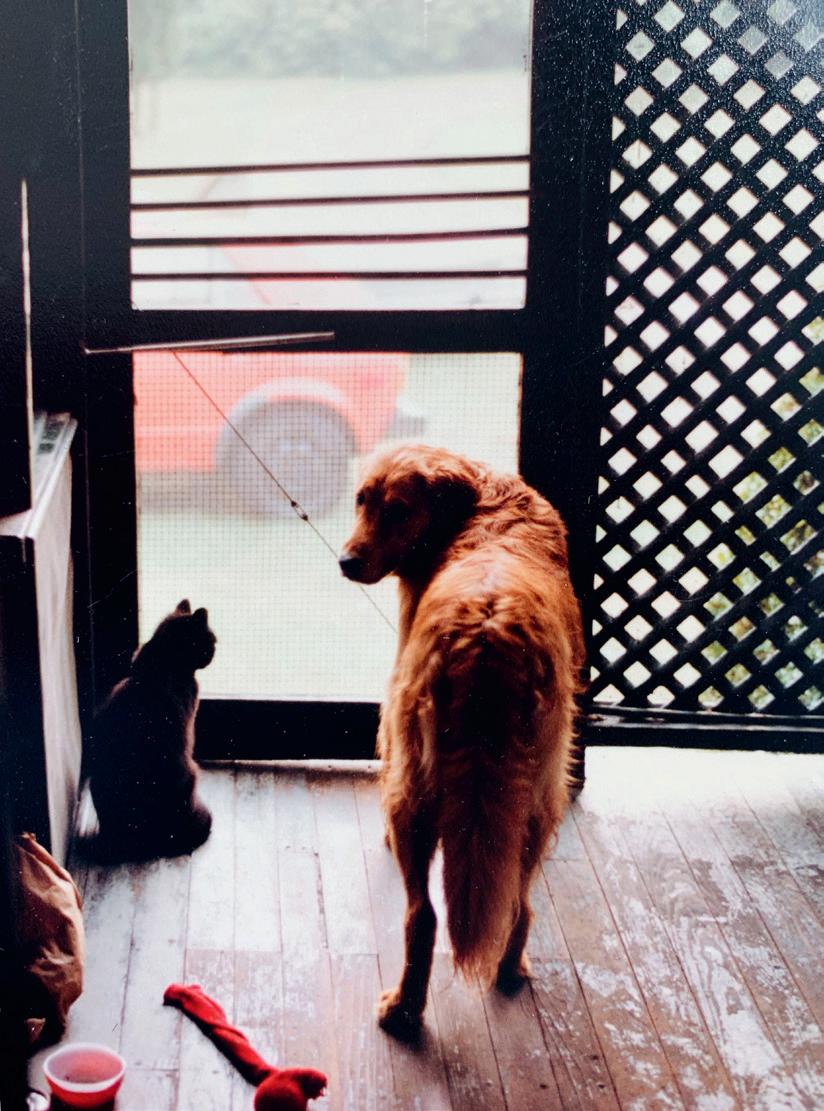







I was 20 years old when I came for the first time, drawn by May, a quiet girl from Minnesota I’d met in college. Buffalo Bay had been bought and developed around 1910 by her ancestors, shrewd Connecticut women who had noticed that wealthy families from all over the Northeast were looking for places to spend the summer on the shore. Some of their earliest tenants were from Buffalo, New York, and that’s how the place got its name.
May’s mother, Dr. Elizabeth Lowry, who owned several of the shingle-style houses on the property, maintained the matriarchal tradition. They were big buildings—a “cottage” could have a dozen bedrooms—but they were strictly for summers: no insulation, no central heat, perhaps a fireplace or two for chilly evenings. When Labor Day came, the tenants went home, and the owners covered the furniture with white sheets and turned off the water.
All the other houses on the bay were owned by May’s relatives, so when she and her brothers and sisters came east from Minneapolis in the summers, they found plenty of cousins with whom to play tennis or field hockey (the unofficial family sport), or to splash in the inoffensive waves that ran up the little arc of beach beneath a stone-and-concrete seawall that guarded the first row of houses.
In those days, Buffalo Bay was a paradise of grass, trees, sand, and water, bounded by the Nuns’ Beach on the east and a jumble of rocks with names like “Turtle” and “Lamb Chop” on the west. Three miles out in the sound was Faulkner’s Island, with its lighthouse ever sweeping the shore.
On the next shot, you might benefit from the same divine intervention. The Buffalo Bay Bounce giveth, just as it taketh away.
In teaching me the rules of tennis, Betty also taught me the rules of a larger game—an ethos. Buffalo Bay had rules, too, unwritten and unspoken, but indisputable. There was no shame in recreation. Recreation was what Buffalo Bay was for: “re-creating” the Garden of Eden. And as in that garden, one could be ejected for breaking the rules.
Betty was endlessly patient, but she would not abide a tantrum. If I swore, or threw a racket, the lesson was over. If I ran around my backhand, backhands were all she would hit me— and she could hit them all day long. I played singles with her into her late 80s and never won a set. Once I ran up a 5–0 lead and relaxed just the tiniest bit. Final score: 8–6, Betty.
When you played, whatever you played, you played the right way. But you played hard. That was also one of the rules. A visiting friend once spent a few days there, and left muttering about the “Buffalo Bay Decathlon”—tennis, softball, field hockey, swimming, sailing, canoeing, fishing off the rocks, crabbing in the East River, hiking, biking, all done at full speed.
Recreation was what Buffalo Bay was for: “re-creating” the Garden of Eden. And as in that garden, one could be ejected for breaking the rules.
It could be exhausting. But Betty lived to be 100, and when she surrendered her driving license (at around 90), she took to riding her bike everywhere, despite being legally blind and mostly deaf. And with the birth of every new grandchild (15) or great-grandchild (17), she would chortle, “I win!”
Cars that used the one-lane dirt road meandering through the lush lawns never drove very fast; the bushes were full of cottontail bunnies; egrets and cormorants stood like sentinels in the shallows. And if a kid suddenly needed a snack or a bathroom, he or she could go into any house and find family.
May helped me learn tennis, but mostly my teacher was her mother. Betty Lowry was a little woman and 41 years my senior, but she’d been playing tennis all her life, and she had high standards. There’s a family story that Katharine Hepburn’s brother, who lived just up the shore in Old Saybrook, was once sweet on Betty and played tennis with her. When I asked her why that romance had not blossomed, she answered tersely, “He had no backhand.”
Betty taught me all about the Buffalo Bay Bounce. The dirt courts that we played on, though faithfully rolled and swept after every match, inevitably lost their perfect flatness. There were hillocks near the end lines and shallow valleys in the service courts that deflected tennis balls in unpredictable directions. When that happened, etiquette limited a player’s reaction to a shrug and the ritual protest: “Buffalo Bay Bounce!”
You shrugged because it was chance, or God’s grace, that sent that shot caroming crazily away from your racket.
I won, too. We played doubles with her friends, all of them decades older than I and infinitely kind. My strokes were rarely worthy of praise, but they went out of their way to encourage me when I raced back or forward or from side to side to try to return a shot I had no business even trying for. If I reached one, I’d pop up a feeble return that one of them would swat away effortlessly, then pipe up, “Good get!”
It was a perfect metaphor. Neither of my working-class parents went to college, and while winning a scholarship to Harvard opened the door to social and professional advancement, in truth, I hit the lottery when I married May. Good get, indeed.
For many of the same reasons it was a wonderful place to vacation, Buffalo Bay was—and still is—a perfect place to get married. It was there, on my first visit, that I told May I loved her. She replied with a single word referring to bovine excrement.
She was right. As usual, I was getting way ahead of myself. She knew it was far too early for such declarations. It would be another two years before I asked her to marry me, and she said yes. We planned to do it at Buffalo Bay, but it was a cold, wet, dismal day, so we took our vows at Betty’s farmhouse a few miles inland.
We celebrated our 25th wedding anniversary in 1998 by hosting the wedding of our daughter, Liza, and her intended, Jonathan, at Buffalo Bay, where both of her brothers, Dan and Joel, would also be wed in years to come. This time, it was a lovely day in June, and we’d prudently rented a big tent with a dance floor for the party. Jonathan’s father, a minister, led the service. Dan and Joel were among the groomsmen, and the ceremony took place under a maple tree with a view of the sound. I recited “A Little Tooth,” by Thomas Lux, for my six-foot daughter:
Your baby grows a tooth, then two, and four, and five, then she wants some meat directly from the bone. It’s all over: she’ll learn some words, she’ll fall in love with cretins, dolts, a sweet talker on his way to jail. And you, your wife, get old, flyblown, and rue nothing. You did, you loved, your feet are sore. It’s dusk. Your daughter’s tall.
It’s dusk, 20 years later. I’m not the lovesick swain of 1970 but the grandfather everyone calls “Grumpy.” We are sitting around the table in our own house in Buffalo Bay: me and May (“Grammy”); Liza and Jonathan and their three children; Dan and his wife, Holly, and their two little girls; Joel and his wife, Crichton; various cousins. We rue nothing. I am asking them questions about Buffalo Bay and what it means to them. They know a different Buffalo Bay than I do. I have never been a kid here.

So I don’t know, as Joel does, the urgency of getting in another few minutes of play as the light fades every evening. Or the sense of innocence, as Crichton explains: Eden before the Fall. The colors in the late afternoons, Liza recalls, the way the light turns the summer-baked grass golden.
It’s not perfect. I ask them what they don’t like about Buffalo Bay, and they shout out a long list as if they once again were children: “Cold water! Jellyfish! Bugs! Poison ivy! Stepping on nails! Parents who call you to come in before you’re ready to go to bed! The Buffalo Bay Bounce!”
Then I ask them what they associate with the word dusk, and that’s harder. But Crichton nails it.
“What we’re doing right now,” she says. “Sitting around the table after dinner, telling stories, laughing. Grammy is clearing the table. Kids are going in and out, banging the screen door and letting in a million mosquitoes. Moms and dads are putting the babies to bed and shushing us when we get too loud. And Grumpy is doing the dishes and smiling.”
How long can this blessing last? The upkeep on these seaside houses puts enormous financial stress on their owners— we rent ours out 50 weeks each year just to pay the taxes.
Sea Cliff, the house from which Betty watched the Hurricane of 1938 claw away a sizable chunk of land, is out of the family now; one of the smaller family cottages was sold a few years ago, and the new owners have torn it down and replaced it with a much larger place. All week, during our last visit, we played and swam to the background noise of clanging, grinding, and crashing as another house in the front row was demolished to make way for something newer and grander.
There is heartbreaking conflict between cousins about the future ownership and use of three other family houses. When she gave these cottages to her children, Betty worried they might be poisoned gifts, too big to maintain, too small to share with growing multigenerational families.
When my youngest granddaughter is tall, what will have become of that little village of salt-weathered cottages overlooking Buffalo Bay? Will it be a gated fortress for millionaires only? Will rising seas drown Turtle Rock and Lamb Chop Rock, or even overtop the seawall, as they did briefly during Superstorm Sandy?
Or will it endure, endlessly changing but ever the same? The seas might not rise as high as we fear; the family might find a way to work it all out among themselves. Twenty years from now, we might be sitting around the dinner table in a pool of light and laughter as darkness falls.
It depends on us. It depends on how we play the Buffalo Bay Bounce, the undeserved, unpredictable, uncontrollable act of God or fate that gave us this green and lovely gift a hundred years ago, and can take it away, too.
 Shown in his home workshop, author and woodworking instructor Peter Korn is the focus of a mini documentary released online last fall, A Life’s Work: The Philosophy of a Craftsman
WE ASK PETER KORN , FURNITURE MAKER AND FOUNDER OF THE CENTER FOR FURNITURE CRAFTSMANSHIP:
Shown in his home workshop, author and woodworking instructor Peter Korn is the focus of a mini documentary released online last fall, A Life’s Work: The Philosophy of a Craftsman
WE ASK PETER KORN , FURNITURE MAKER AND FOUNDER OF THE CENTER FOR FURNITURE CRAFTSMANSHIP:
The importance of craft is a subject that Peter Korn has spent a considerable amount of time thinking about—first as a furniture maker on Nantucket in the early 1970s, and later as the founder and executive director of the Center for Furniture Craftsmanship in Rockport, Maine. The author of Why We Make Things and Why It Matters, Korn believes that using our hands to turn natural materials like wood and clay into meaningful objects is a vital part of the human experience. “The creative impulse is ineradicable,” he says. We caught up with Korn, now 69, at his campus office to talk shop.

uman beings have been evolving for a long time, and for most of it the focus has been fashioning things from natural materials to create objects. I mean, the reward for building a better spear was that chances were you were going to survive longer. It’s biological as opposed to cultural. That’s true even as we live in a more digital world. You see the fallout all the time: People get detached; there’s a gnawing, hollow center that they can’t put their finger on.... We simply didn’t evolve to experience the world through devices.”
“Going into a creative space, you become a different person. I’m not saying it’s like Star Trek , where you go into the machine and come out and you look different. But you are going to feel different, and your experience of yourself and the world around you is going to be improved in some way.”
“What you get out of craft or the creative process isn’t so much what you end up with—it’s being engaged with the process as it’s happening. That’s the fulfilling part. When you’re knitting a sweater or making a piece of furniture, you’re fully engaged in something that’s as good as life gets. When you’re skilled at using tools and working with nice materials, it feels good in a multisensory way. You’re listening to the tools. You’re feeling the impact of the mallet or the chisel. You lose yourself. That’s just a sheer physiological pleasure. The normal
worries about life—bills, the kids, your work—fade into the background. I think of it as a chance to inhabit your highest self.”
“I don’t think it’s necessary to do what you love for money to get full value out of it. I meet people all the time who think that if they sold their furniture, it would validate them and make them real somehow. Like that’s the only way they could be considered actual furniture makers. But if they’re making furniture, they are real furniture makers. And getting paid for what you do isn’t always more pleasurable. I know that from experience.”
“What I think really matters is the process of coming up with an idea and making it manifest in the world. Not any idea—I’m not suggesting that coming up with a better idea to make turtles extinct counts—but an idea that you will truly find meaningful. To me, craft is a good way to do that, because when you’re working with real materials you can see what you’re doing and you can measure the success of what you’re trying. There are tangible results you can share. There’s tremendous satisfaction in that.”
“I have a lot of respect for the people who come here as students. They’re willing to start at a basic level of something and take the chance that they may not have the aptitude for what they’re trying to do. They’re risking time, money, and ego. And then there’s the risk they take of making a readjustment to their understanding
of themselves in the world: how they see themselves and the story they have of who they are. That’s not easy, and not everyone is willing to do that. But the rewards can be astonishing. A young man from California came here a few years ago. He was a cameraman in the film business. Maybe there was something in his life that he wasn’t finding satisfying. Well, in the few years since then, he’s quit his career and become a professional wood turner. He now travels around the country and talks to woodworking groups. He found something in himself and about himself, and he has a whole different way of life now.”
“When you’re starting on the creative process, you can’t know the result before you get there, or it wouldn’t be a creative process. It’s a process of discovery. Every piece of furniture I make is a snapshot of my ideas at a given time and a springboard for making it better the next time. But you have to do it. You can’t just sit around and think about what you want to do. Ideas just disappear so fast. Since my book came out, I’ve had people come up to me and say things like ‘I was a weaver when I was younger, but I don’t know how to get back into it. What should I do?’ The answer is really simple: Get some yarn and start weaving. You just need to start doing it.”


Maine’s highest mountain in winter became trapped on a tiny ledge by a fierce, unexpected blizzard. Though temperatures below zero made it impossible to move, all through the night they shouted hundreds of times,
New England does not hold the patent on resilient people who fight through the hardest of circumstances and emerge with their spirit intact, even if they have suffered pain or loss. But perhaps because our states are small, in this most compact region in the nation, it seems as if when we read about those of us who have endured, we find solace and hope for ourselves as well. We feel we know them. We know where they come from. Maybe they are no different from us; their storms were simply stronger. Because they made it, we believe we can.
In the following pages, you will meet a young boy who became separated from his family while hiking Mount Katahdin and who refused to accept any outcome but one, that he would reach safety, even as he subsisted on nothing but wild berries and water for nine days in the wilderness. In another tale, a sailor who capsized in an Atlantic storm improvises a life aboard a tiny rubber raft, bobbing helplessly in a vast sea for 76 days.
Years from now, there will be stories told about how we made it through this global
The profiles in the following pages are excerpts of classic Yankee stories, which you can read in their entirety at: newengland.com/ resilience
pandemic, this event that tests everyone, young and old, rich and poor, in small towns and big cities. We will read about hopes dashed and lives lost—but also about heroes who showed up day after day in mask and gown to care for others, heroes who volunteered to receive experimental treatments or vaccines. We will read about how we cared for each other, for total strangers, just by staying apart.
I remember sitting in the living room of Christa McAuliffe’s mother, Grace Corrigan, as she described to me how she had looked skyward in her proudest moment, as her daughter took off in a rocket to become the first teacher in space, and then how she responded to the deepest loss imaginable. She simply refused to break. We all face challenges that test our will to carry on, or our ability to wait out the storm, or to reach that distant shore, or to slash our way through brambles until we see a cabin with a light in the window. But these stories tell us that others have done this. And we can too.
Mel Allen
Of the thousands of stories Yankee has published over the years, the most compelling are the ones about people on a quest complicated by impossible obstacles. And through perseverance—and, in no small measure, courage—they find a way to succeed. I myself have always been drawn to these stories. One of my first articles for Yankee recounted how six young men who had trekked through snow and ice to climb
“Endure! Endure!”
Adapted from “Christa McAuliffe’s Messenger”
by Mel Allen, January/February 2011The last time most people saw Grace Corrigan, she was looking skyward, her husband, Ed, beside her, in the bitter cold of a Florida morning, January 28, 1986. When the space shuttle Challenger roared off the launch pad with six astronauts and their daughter Christa McAuliffe—a Concord, New Hampshire, high school teacher and the first private citizen selected to experience space flight— aboard, Grace was gripped with fear and pride and hope. All of those emotions tumbled out on her face in the cold, her cheeks brushed by her white fur coat, as she strained to follow the rocket. Then Mission Control announced, “Go at throttle up”—and, a heartbeat later, the sky erupted.
And now I sit facing Grace Corrigan, with Christa’s official NASA portrait on the wall behind me. “It just doesn’t seem possible that it’s 25 years. But it is,” Grace says. We’re in the living room of the home where she and her husband raised five children, in a family neighborhood in Framingham, Massachusetts. Through the picture windows her lawn bustles with birds and squirrels. I see a wall covered with photographs, so many it’s as though family albums have emptied onto the wall: Christa as a baby, as a child, in Girl Scouts, in high school, in college; Christa the young wife, the mother, the teacher; Christa in astronaut garb, the woman who swept a country off its feet.
And there’s a photo of Grace herself, giving a commencement speech at what is now Framingham State University, the school from which both mother and daughter had graduated. “The commencement speech Christa was supposed to give,” Grace says.
She’s done that so many times, speaking to thousands of teachers and children, almost within weeks of the day her daughter disappeared from her sight; writing A Journal for Christa ; answering reporters’ questions on anniversaries; answering reporters’ questions when the crew of the space shuttle Columbia died in 2003 (“I’m not doing very well,” she said then) and when Barbara
Morgan (Christa’s alternate for the Challenger voyage) completed her successful shuttle mission in 2007.
On this day, for example, Grace has just come home from Huntsville, Alabama, home of Space Camp, just down the road from where Christa had spent part of her training. “I haven’t even unpacked,” she says.
She returns every year to Space Camp for the special week when “Teachers of the Year” from across the country and around the world converge to explore the mysteries of space travel. “I tell them that Christa was a teacher,” she says. “That was the most important job for her. When she came back, she was going to go back to teaching. This was the thrill of a lifetime for her, but she felt it was going to focus on education and that it would get the kids excited.”
I tell her I find it remarkable that she can do this for all these years; I say I doubt I could. She laughs gently. “You know how I do it? I know Christa would say, ‘Hey, Ma, I’m not here. It’s a good message. What did I give my life for? You know, I should be there doing it. I’m not. You can do it.’” Christa’s mother smiles. “If I can help, just by carrying her message, that’s what she was striving for.” She looks at me with an expression that says, It’s clear why I do this.
Before I say good-bye, Grace tells me a story that she thinks will help me understand. “The ones I remember most are the ones where the kids are really deprived,” she says. “There was a school in New Jersey. It’s a tough, tough school. They were a little scared [about] how I would be received. And yet”—here she stops, and her eyes shine—“they were the most wonderful audience. The auditorium was packed. The kids didn’t let out a peep. The teachers had taken my book, and each grade had taken a part and done projects. I remember this part so vividly. I was talking about questions children had asked me, and in that big auditorium it was so quiet I heard a little voice: ‘She’s talking about my question!’
“When I drove away, I said, ‘Thank you, Christa, thank you.’”
☛ Epilogue: Grace Corrigan passed away at age 94 on November 8, 2018, survived by her children Christopher, Stephen, Elizabeth, and Lisa, as well as nine grandchildren and five great-grandchildren.

My mother brought me and my brother [David] up (in Maine) because our father deserted the family when I was little. Home was always rented. Our outhouse was painted blue, and that’s where we contemplated the sins of life. Our well was always going dry. I’d have to lug water from a spring in another field, and even now I’m nervous about our wells.
“My mother worked the midnight shift at a bakery. I’d come home from school and have to tiptoe around so as not to wake her. Our desserts would be broken cookies from the bakery. She was a very hardheaded person when it came to success. She knew what it was like to be on her own without an education, and she was determined that David and I would go to college. ‘You’re not going to punch a time clock all your life,’ she told us. She always told us that dreams and ambitions can cause bitterness if they’re not realized, and she encouraged me to submit my writings. We both got scholarships to the University of Maine. When we were there, she’d send us $5 nearly every week for spending money. After she died, I found she had frequently gone without meals to send that money we’d so casually accepted.
“When I started Carrie I had finished my first year of teaching. When I finished it I sent it off to Bill Thompson at Doubleday, whom I’d talked to on the phone when I was in college. My wife, Tabby, and I were having a really tough time. We had our daughter, Naomi, and our son, Owen. Our phone was taken out because we couldn’t afford it. Our car was a real clunker. When the telegram came saying [Carrie] was accepted with a $2,500 advance, Tabby had to call me at school from across the street.
“Later my agent told me the paperback rights were bought for $400,000. I said, ‘You mean $40,000.’ He said, ‘No, I mean $400,000.’ I realized that meant $200,000 for me and I wouldn’t have to teach anymore. My mother was dying then, but she knew everything was going to be all right.”
☛ Epilogue: Stephen King’s books have sold over 350 million copies and inspired a number of movies and television series.

Adapted from “The Education of Laura Bridgman” by P. Bradley Nutting, October 1987
At the age of 2, Laura Bridgman—who had been born on a farmstead near Hanover, New Hampshire, in 1829—suffered scarlet fever and was plunged into a living tomb of total darkness and silence. All she had left was a sense of touch. Public opinion everywhere agreed such persons were incapable of learning. Yet Laura ultimately surmounted her handicaps to become the first deaf-blind-mute ever to read and write—a world-famous figure and a heroine to her generation. With the help of teachers at the newly founded Perkins School for the Blind in Boston, she prepared the way for others to follow. Laura became so well known that girls on both sides of the Atlantic tied ribbon over their dolls’ eyes, imitating the green sash that always covered her own.
Laura passed on an important legacy of her own. At Perkins, she was to share rooms with a half-blind, hottempered young woman named Anne Sullivan. In 1880, at age 14, Anne, the daughter of poverty-stricken Irish immigrants, had talked her way out of the poorhouse and into Perkins in desperate pursuit of a decent education. Anne came to know Laura well and learned the manual alphabet so that she might spell out all the latest gossip for her older roommate. This skill would prove more useful than Anne ever imagined.
In 1886 word reached Perkins that a little girl in Alabama who had lost both sight and hearing needed a teacher. Because of her experience with Laura, Anne was keenly aware the mission was no longer impossible; she accepted the assignment. As a symbolic passing of the mantle to the next generation, Laura Bridgman sewed the clothes for the doll Anne Sullivan took south to the new student. The child’s name was Helen Keller.
☛ Epilogue: Laura Bridgman would spend much of her life at the Perkins School for the Blind, where she died at age 59 in 1889. She is buried in a cemetery in Hanover, New Hampshire, not far from where she was born.

Adapted from “The Two Worlds of Bill De La Rosa”
by Mel Allen,September/October 2016
Iwas born in a small border town known as Nogales, Arizona, but raised in Nogales, Mexico. When I was 7 years old, my family risked moving permanently to Tucson, Arizona, in search of a better future. We left everything we owned in the small motel room where I spent my childhood. When we arrived in Tucson, we had no money, no place to go, no place to call home. We slept wherever we felt safe—in our car, in alleyways, within trailer parks…. My mother [Gloria] earned a living cleaning rooms at our local Motel 6. Sometimes I would tag along and help her clean, so she could come home a little bit earlier.… In October 2009, my mother was deported from the United States to Mexico, and she was barred from returning to her home and family for 10 years.” —From Bill De La Rosa’s commencement speech at Maine’s Bowdoin College, May 28, 2016
For years Bill De La Rosa’s story stayed mostly private; few of his high school classmates, few of his Bowdoin classmates, knew what was driving him. In a heartbeat, Bill had become mother, father, cook, housekeeper, brother, nurse, tireless immigration law researcher. Bill’s older brother, Jim, graduated from high school and joined the U.S. Marines. I asked Bill how he’d managed to become his high school’s valedictorian, earn scholarships, be recruited by the best colleges—all while caring for his father and two younger siblings. Bill grew silent.
“I knew I had to stay hopeful, so we all had hope, so there’s hope also for my mom. If I don’t have hope, then she doesn’t either. The way I can give her hope is by showing her how I am in school. And when semester grades came out I’d show her and say, ‘Look, Mom.’
“I didn’t want anyone to feel sorry for me, so I just started wearing different masks. I became a different person in front of my friends, in front of teachers, in front of my dad and [my sister] Naomi. In front of my mom. In middle school, every day before class, we all had to recite what teachers called ‘The Definite Dozen.’ There were 12 rules. And I always remembered number 12. It was the last rule, and every day we had to say it
out loud. Only then we could take our seats. Number 12 was ‘Be relentless. And never give up.’ That was always in the back of my mind: ‘Be relentless. Never give up.’”
On Saturday, October 17, 2015, he was the only student asked to speak at the inauguration of Bowdoin president Clayton Rose. Later, Bill would tell Teresa Toro, his high school guidance counselor, who’d helped steer him to college, “I couldn’t believe it. I marched with everyone in full garb across the campus. Bagpipes played. I kept thinking, Here’s this little boy crossing the border to a school and he doesn’t speak English, who lived in Motel San Luis, and here I am speaking at something that only happened 16 times in the history of Bowdoin. How does that happen? It must happen for a reason.”

At Bill’s commencement the following spring, a tall man in a suit stopped at his table after the ceremony. He’d listened to Bill’s speech, and now he looked at his family. “Bill will change the world,” he said. “Bill will change the world.”
☛ Epilogue: After earning master’s degrees in migration studies and criminology and criminal justice from Oxford University, Bill De La Rosa recently received a full scholarship from Oxford to pursue a doctorate in law and philosophy. His research on the plight of migrants will take place near his family in Arizona. His mother has served her 10 years’ deportation and hopes to return to the U.S. soon.
Adapted from “Lost at Sea” by Steven Callahan, January 1986. Reprinted from Adrift: 76 Days Lost at Sea
On January 29, 1982, Steven Callahan, a boatbuilder and sailor from Maine, left the Canary Islands in his 22-foot sloop Napoleon Solo, bound for Antigua. Six days later, gale-driven waves swamped his boat. Before it sank, Callahan grabbed whatever he could reach and flung himself into a six-foot rubber raft. This became his oceanborne home for 76 days.
MARCH 14. I have managed to last 40 days. I’ve lasted longer than I had dreamed possible in the beginning. I’m over halfway to the Caribbean. Each day, each

hardship, each moment of suffering has brought me closer to salvation. The probability of rescue, as well as of failure, continually increases. I feel like there are two poker players throwing chips into a pile. One player is rescue and the other is death. The stakes keep getting higher and higher. Somebody is going to win soon.
MARCH 28. I feel as though I’ve been twice to hell and back. I will never last another one. I am close now. I can feel it. For days the Atlantic has been barren, but now I see a huge clump of sargassum weed riding the waves.… There are things crawling, and fishing line tangled up in it. Another bundle bobs up ahead, I grab the second, then a third, then a fourth. The ocean is thick with the weed. I pick through the vegetation for food—tiny shrimp, fish, slugs, and clicking crabs.… I’m convinced I have reached the shallower waters of the continental shelf.
APRIL 20. The evening skies of my 75th day are smudged with clouds migrating westward. A drizzle falls, barely more than a fog, but any amount of saltless moisture causes me to jump into action. For two hours, I swing my plastic buckets through the air, collecting a pint and a half.…
DAWN OF THE 76TH DAY ARRIVES. I can’t believe the rich panorama that meets my eyes. To the south a mountainous island, lush as Eden, juts out to sea. To the north is another. Directly ahead is a flat-topped isle…. Close as I am, I’m not safe yet. A landing is bound to be treacherous…. One way or another, this voyage will end today. I hear something new. An engine! I leap up. Coming from the island, a white, sharp bow pitches forward against a wave, and then crashes down.… Three incredulous dark faces peer toward me…. It’s been almost three months since I’ve heard another human voice…. The present, past, and the future seem to fit together in some inexplicable way. I know that my struggle is over. I have never felt so humble nor so peaceful, free and at ease….
☛ Epilogue: Steven Callahan still lives in Maine, where he continues to design boats, including a life raft that could help future shipwrecked sailors survive. He served as a consultant on the 2012 movie Life of Pi, which recounts a boy’s ordeal of survival after a shipwreck.
Adapted from “Wil Smith’s Fast Break” by Mel Allen, December 2000
Wil Smith was unique at Bowdoin—the school’s first single father, a Navy veteran 10 years older than his classmates. He was the product of an inner-city high school attending a college in Brunswick, Maine, where more than half the students arrived from prep schools. He was one of fewer than 40 African-Americans in a student body of 1,600. He was, in the words of Dean Craig McEwen, “Bowdoin’s most remarkable student in memory.”

At the time he applied to Bowdoin, Wil was at a professional and personal crossroads. He had served seven years in the Navy and was due to re-enlist. But the Navy meant six months overseas every year, and by then he was a father to a baby girl, Olivia. He’d met Olivia’s mother in Portland after returning from overseas duty. She gave birth in May of 1995. The relationship broke up and the baby lived with the mother, but Wil got Olivia every Thursday and kept her until Monday. “No matter how untimely, Olivia didn’t ask to be here,” Wil says. “I can’t imagine a life without her.”
He sent a hastily written application to Bowdoin, and Bowdoin took a chance. His last day of active duty was April 25, 1996, the same day Olivia’s mother gave Wil full custody of his 11-month-old daughter because she didn’t feel she could raise her.
When he started college in September 1996, Olivia was 15 months old, and he had no choice but to bring her to class with him. The professors soon learned that when Olivia was sick, Wil would not be able to come. The money he saved from the Navy went faster than he could have imagined. Sometimes he didn’t eat for two or three days so he could feed Olivia. Then basketball season started.
“Coach didn’t know,” Wil says, “but I lost 17 pounds. I couldn’t sleep. I got an F in a course—LatinAmerican Studies—that required you to read about 20 books. I didn’t have money for the books, and I didn’t know they were on reserve in the library. I said to myself, I can’t make it. This is just too hard .” He told his adviser simply, “Things are hard for me right now.”
The adviser called Betty Trout-Kelly, the assistant to the president of Multicultural Affairs and Affirmative Action for Bowdoin.
On a Sunday afternoon late in Wil’s first semester, Trout-Kelly sat him down and told him, “I know you feel you shouldn’t need this support system, but if you don’t take the help we can offer, it will be your fault. And if you don’t accept it, you won’t make it.”
For the first time Wil told her about his struggles. “The struggle to survive was so great,” says Trout-Kelly, “that he couldn’t be a student.” She called meetings—the development office, the dean of student affairs, and the president of the board came. Trout-Kelly and Dean Tim Foster telephoned Wil after the meetings. A fund from an anonymous donor would give $25,000 for Olivia’s day care. Wil would be able to move to campus housing and eat regularly with his daughter at the school. TroutKelly said to Wil, “I know you can do well at Bowdoin. You’ll have an opportunity to prove yourself.”
Wil replied, “Thank you. I’ll prove myself worthy.”
Wil calls his daughter “my complex joy.” He says, “All those nights when I was so tired, I was ready to quit on papers. But then I looked in on Olivia sleeping, and I turned right around and went back to my paper. She put life in perspective for me. When she was 2, I was walking her to school. It was cold, and I was holding her hand. My mind was in turmoil. I had midterms; my car had broken down; we had no money. Olivia was talking about leaves and trees. I didn’t even realize she had let go of my hand. I had taken another 10 steps without her when suddenly I turned. She said, ‘Dad, talk to me.’ She was saying in her own way, ‘Look, none of this other stuff matters.’ All she cared about was that we were there. She was glad the car had broken down. That meant we could walk to school together.”
On May 27, 2000, beneath a sparkling blue sky, Bowdoin held its graduation. Slowly Robert H. Edwards, Bowdoin’s president, read off the names of its more than 300 graduates. When he said, “Wil and Olivia Smith,” Wil carried Olivia in her shining blue dress to the stage. There was a great roar, and everyone— students, faculty, and parents—stood and cheered.
☛ Epilogue: Wil Smith’s story received national attention, with Wil and Olivia appearing on Oprah and The Today Show. After earning a degree from the University of Maine School of Law, Wil returned to Bowdoin to become the associate dean of multicultural student programs. In 2012, not long after he was diagnosed with colon cancer, he and Olivia shared their remarkable story once again, on NPR’s Story Corps. He passed away three years later at the age of 46.
Adapted from “Fire on the Farm” by Mel Allen, March/April 2007
August 27, 2004. Early evening, about 6 p.m. There was still the last wagon of hay to get in, and the cleanup after milking. The farm is called Spooky View, named for the cemetery that abuts its land, and it’s one of only three dairy farms remaining in Epsom, New Hampshire, a small town east of Concord.
Inside the barn, Keith Bachelder has just finished milking his 35 cows and feeding an equal number of heifers. Keith owns the cows, having bought them from his parents seven years earlier, but everyone helps out— dad, mom, sister, brother, friends. It’s how small family farms have always made do. Outside, his father, Charles, along with cousins and friends, is throwing the last bales onto the hay elevator that trundles to the second-story loft. Charles and his wife, Ruth, bought this farm in the early 1970s when Keith was a baby. Charles is well into his 60s, and he’s spent nearly every day of his life on farms.
On this summer evening Keith has just finished milking and Charles is throwing the last bale onto the elevator, which is overheating, though nobody knows it. He looks up and sees the flames. “Fire!” he yells, and then everyone starts running for the animals.
The barn seems to fill with people pulling and tugging at the cows until all but one were out. Firemen from 13 towns come screaming up Center Hill Road, but the flames feed on that hay and tear through the woodwork until there is nothing left but mounds of ashes.
The finances of a small farm are always precarious, and Ruth and Charles and Keith had not increased their insurance over the years to keep up with what it would cost to rebuild. The animals were safe, but Spooky View Farm seemed destined to become one more small-print item in the papers announcing one more auction.
Then the story took a twist. Epsom’s fire chief, Stewart Yeaton, is also a dairy farmer, and he told the Bachelders the cows would go to his barn a few miles away, and, in the dark, the air thick with smoke, everyone around who had a livestock trailer drove to the pasture and loaded up the animals. Before dawn, Keith and Charles drove over to the Yeaton farm and milked their cows.

Here’s what happened next: Farmers from Pembroke, Bedford, and Contoocook delivered hay. All the local stores sprouted donation cans and people filled them up. Keith continued to wake at 4 each morning to drive to the Yeatons’ to do the milking and to soothe his cows while emerging from his own shock. “I didn’t know I was going to rebuild,” Keith says. But it was as though everyone willed him to. People brought supplies, lent their expertise and muscle. A local company brought a crane and put up rafters. A neighbor came by with a loader and another with gravel to level the land. “People just came to help from everywhere,” Ruth says. Slowly the new barn took shape on the land.
For a year and a half, the family missed their cows, as if they, too, were family. On February 11, 2006, the first truckload of cows left the Yeaton farm to come home to their new barn. “We were so happy,” Ruth says. “We opened the gate and they came running.” They put a sign out front: “Cows Are Home.”
☛ Epilogue: The Bachelder family still owns Spooky View Farm, which remains a working dairy farm.
his jeep. It took him four hours. Managing somehow to operate the gas and clutch pedals with only one foot, he drove himself out of the woods and found help. Eight weeks later he was back at work, driving a bulldozer.
“I was in the hospital for about seven weeks. And for a long time they didn’t know whether I was going to live or not. The doctor said the only chance I had—and it was slim—was for him to amputate the rest of my leg above the knee. I said, ‘Listen here, doc. I done all the cutting on that leg that’s going to be done. I got it trimmed up just the way I want it. Now you leave it alone.’ Am I planning on retiring soon? Never. The old Reaper’s going to be the one who retires Barney Roberg, and he’s going to have a tough enough job doing that.”
☛ Epilogue: Barney Roberg did indeed live a good long life, passing away at age 85 in 2001.
Adapted from “Survivors” by Jim Collins, May 1992
BARNEY ROBERG
‘If You Give Up, You’re a Dead Man’
Adapted from “Barney Roberg’s Impossible Choice” by L. Michael McCartney, May 1980, and “Survivors” by Jim Collins, May 1992
In the fall of 1956, logger Barney Roberg was working alone in the woods near Patten, Maine, seven miles from the nearest help. The enormous white pine he was cutting kicked back the stump and pinned him, bleeding, to another tree. It was impossible to use his chainsaw to cut the tree in such a way to free himself. “Nobody knew exactly where I was, and I knew nobody’d even miss me until nightfall,” he recalled, “so it was pretty clear right from the start that I’d bleed to death if I just waited for help. I just kept telling myself, ‘Barney, you can’t give up. If you give up, you’re a dead man, no two ways about it.’ I had to stop and think a long time about what to do next.”
What he did next was cut his leg off. Then he tied a tourniquet around his stump and crawled two miles to
Back in the summer of 1939, Donn Fendler, age 12, became separated from his family while hiking on Mount Katahdin. For nine days he walked through some of Maine’s most rugged country before being rescued—naked and emaciated—near a sporting camp some 30 miles distant on the East Branch of the Penobscot River. As he recalled: “Three things helped get me through it: First I prayed a lot, made a lot of bargains, like promising to wash the dishes. The second thing was my Boy Scout training, like following water downstream to a bigger stream. I lived on water and berries. And the third thing I guess you’d call a will to live.”

His story became a book, Lost on a Mountain in Maine, read by generations of Maine children. “I get hundreds of letters every year from kids—hardly a day passes when I don’t get one—and I answer every one. They say I’m kind of a legend in Maine, but I don’t feel like one. I don’t consider myself a hero or anything like that. I was just plain lucky.” On the 75th anniversary of his ordeal he told the Bangor Daily News that it took him a while to understand why his story resonated so much

with Mainers. “Finally it dawned on me: Maine people are rugged people. They’re resourceful. They’re resilient. They’re outdoors people. People in Maine could relate to exactly what I was going through.”
☛ Epilogue: Donn Fendler went on to serve in World War II and Vietnam before retiring in 1978 as an Army lieutenant colonel. Maine declared July 25, 2014, “Donn Fendler Day” to commemorate the 75th anniversary of his adventure. His death in 2016 at age 90 was front-page news across the state.
Adapted from “Still Life”
byMel Allen, January 2008
In 1997 Brendan Loughlin is 57. Everything he owns fits into two canvas sacks, and he stuffs them into his daughter’s car, where at times he is forced to sleep. He moves into the basement of a friend’s home, until he finds sporadic house-sitting jobs. When he sleeps, he dreams of painting.
He works part-time at a paint store in Madison, Connecticut, and also at the Guilford Handcraft Center, registering students for classes. At night, after locking up, he secretly sleeps on the floor, slipping out before sunrise. He remains certain that he “was meant to paint.” In 1998 he moves into a one-room apartment in Guilford, telling the landlord that he’s an artist with no money, no security deposit, and no credit. The landlord takes a chance and rents him the room.
In the spring of 1999, to clear his head, he takes a bus to St. John, New Brunswick, and finds a cheap furnished room—“the kind bachelors rent for a month,” he says. He brings with him a drawing pad and pencils. “I was lying in bed,” he remembers, “sketching with a pencil, when I saw my future.” He buys chalk pastels and B-I-N, a shellac-based primer-sealer that he’d used when spray-painting cabinets. He mixes the pastels with the shellac and loves the texture, the explosion of color, how he can paint layer upon layer, the picture drying within moments. The pastels and B-I-N cost a fraction of what oils do. He trembles with excitement: “I was all
by myself, nobody to talk to about it. I said, ‘I’m going to take this back. This is how I will paint.’”
In the days following 9/11, Guilford’s town green fills with American flags. Brendan thinks, We need to have balance, need to show joy, too—that we still believe. He hauls a slab of plywood, big as a refrigerator, in front of a florist shop at the edge of the green and paints sunflowers— vibrant, luxuriant sunflowers—and people drive by, honking and waving. MaryLou Fischer, who owns one of Guilford’s leading galleries, is moved by how people react to Brendan’s work, and she wants to see more. Soon the gallery’s walls are covered with Loughlins, and the people come in and buy them, one after the other.
Brendan becomes Guilford’s artistic Johnny Appleseed. Along the streets of Guilford, on shop doors and gates and fences bordering the green, Brendan plants landscapes that sprout everywhere—sky, ocean, great ripples of flowers, as if he’s thanking the town that embraced him.
So many people who own his paintings, who study with him, knew him when he lived on sardines from the food bank, when he curled up in his daughter’s car on frosty nights, when he was everyone’s eccentric local artist. He shows them every day that you can make your life a breathing canvas, and sometimes if the will is strong, you can wake up one day, paint a sunflower bursting with hope, and start over.
☛ Epilogue: Brendan Loughlin is still painting and teaching in Westbrook, Connecticut. In 2012, local author Jo Montgomery published a biography about him titled Loughlin: One Man’s Journey to Redemption

Through Art

Adapted from “Tropical Storm Irene Will Never Be Forgotten” by Ian Aldrich, July/August 2016
On August 27, 2011, Tropical Storm Irene slammed into America’s eastern seaboard, bringing with it winds that reached 85 mph and torrential rains that dumped as much as 11 inches of water on parts of the Northeast.
Across Vermont, Irene was especially catastrophic: six deaths, more than 500 miles of roads damaged or destroyed, many towns made inaccessible for days. Of the countless unsung heroes to emerge in the state during and after Irene, town employees played some of the most crucial roles in the recovery work. Perhaps none more so than Susan Haughwout, the longtime town clerk for Wilmington, which, because it’s bisected by the Deerfield River, became one of Vermont’s hardest-hit communities.
“That night before the storm I couldn’t sleep,” she later recalled. “I was nervous. I tried to doze, but I had the Weather Channel on the whole time. I was pretty panicked. Finally, at around 5 a.m. I got out of bed. I told my husband, ‘I have to go down to the office and start moving books so they won’t be damaged by floodwaters.’ I stopped in at the fire department. I spoke to one of the men: ‘Do you think I ought to prepare for something worse than the ’38 flooding?’ He looked at me and said, ‘Yes.’”
For nearly two hours, in the midst of heavy rains and rising waters, Haughwout and a small crew of volunteers schlepped documents from the town hall’s first-floor vault to the building’s second floor, piling up office chairs with boxes and then rolling them onto an elevator. Not everything was saved, of course, but by her own estimate, Haughwout and her team saved some 95 percent of the town’s records.
“As we worked, I’d go outside to check the river,” she said. “A couple of times I came back inside and told the group, ‘It’s getting really bad. We’d better go.’ And they just said, ‘No, we’re not done yet.’ At one point I went out and saw that the water had breached the bridge and all this stuff was pouring over it—dumpsters, propane tanks, logs—just flying past.”
The crew worked right up until they couldn’t. To have done anything less or, worse, nothing at all, would have been detrimental to the town, said Haughwout, who was forced to abandon her car in order to escape to safety. “The buying and selling and financing of real estate would have come to a halt. If you can’t provide title, you can’t do business. You gotta have it. These are critical documents for the economy of any Vermont town.”
☛ Epilogue: On May 1, Susan Haughwout, a 2014 recipient of the Vermont Municipal Clerks and Treasurers Association’s Town Clerk of the Year award, retired as Wilmington’s town clerk after 25 years.
Adapted from “Keeper of the Lighthouse Keeper” by Mel Allen, August 1982
Connie Small was 19 when her husband, Elson, became the lighthouse keeper at Maine’s Lubec Channel Lighthouse in 1920. The first time she saw her new home, surrounded by seemingly infinite ocean, her heart sank. She would first have to climb a tall iron ladder, and heights frightened her. She said, “I can’t climb up there.” Elson said, “You can, I’ll be right behind you. Just look up, never look down.” She would always say she followed those words for the rest of her life.

For the next 28 years, she lived in some of the most remote lighthouse stations in the country. After Lubec she lived on Avery’s Rock, three miles out in Machias Bay. There was only a half-acre of boulders and a wooden plank leading from the house to the boat slip. No phone, no electricity. She saw only Elson, and at night, while she knitted socks or sewed quilts or clothes, she’d twist the radio dial hoping to hear another voice, however faint.
She told me about the time she blistered the skin off her hands when Elson was out on the sea and the bell broke down during a storm. “I untied the ropes we used to ring the bell by hand when we saluted the lighthouse tender. I pulled all night. I knew Elson was out there.” Once, while winching the boat onto the slip she caught her arm under the clamper, crushing it beneath the cogs. “I walked the floor all night,” she told me. “Next day Elson got me to shore. I had to take the mail team nine miles to Machias while Elson returned to the light.”
When I saw Connie Small, she was living in a tiny apartment in Kittery, Maine. Elson had died. She still rose at sunrise. When fog rolled in, she would wake with a start. “There’s always the feeling that we have to get the bell going,” she said. “That there’s someone out there who needs the bell.”
☛ Epilogue: Connie Small wrote a best-selling memoir, The Lighthouse Keeper’s Wife , and gave nearly 600 lectures on lighthouse life before she died in 2005 at the age of 103.
At the same time more seagulls are showing up in coastal cities, their overall population is shrinking. What is going on with New England’s rascal bird?
 BY SARA ANNE DONNELLY
PHOTOGRAPHS BY TRISTAN SPINSKI
BY SARA ANNE DONNELLY
PHOTOGRAPHS BY TRISTAN SPINSKI
Student intern René Borrero, cradling a great black-backed gull chick, ducks down as an adult gull swoops in during a datagathering expedition on Maine’s Appledore Island. Behind Borrero is Sarah Courchesne, codirector of the island’s gull research program; both are wearing helmets as protection against dive-bombing birds.

ast summer, there were 96 herring gull chicks living on the flat roofs of the Portland Museum of Art. Hatched in nests of grass, mussel shells, and plastic trash, the chicks spent their days wandering the gravel expanse under the blazing sun or curled up in fluffy brown speckled balls in the scrub brush growing around the cupolas and waist-high border walls of their urban world. Surrounding them were adults by the dozens, perched on the roofs’ highest points, scanning the sky for predators such as bald eagles (rarely a concern here in the city) or ushering chicks out of the blazing, heat-stroke-inducing sun (often a concern here in the city).
From the sidewalk five stories below, the adult herring gulls, with their distinctive bright white bodies and blacktipped gray wings, their chests puffed out, their heads held high, formed a striking phalanx atop the decorative halfmoons of the PMA’s facade. Sometimes, the gulls spread their wings and swooped down, laughing their highpitched haw haw haw as they scanned the ground for scraps of food. They perched atop lampposts. And, yes, they occasionally pooped on things. And people. In short, as gulls do, they acted like they owned the place.
Last June, University of New England ornithologist Noah Perlut opened the hatch to the museum’s largest roof and climbed up with two undergraduate assistants. Immediately, gulls lifted up in a low-swirling cloud of frantic flapping and screeching like a scene from Hitchcock’s The Birds. Perlut’s students cowered, eyes wide, each holding a crooked arm overhead for protection. But Perlut only smiled, unperturbed. He’d been studying Portland’s rooftop gulls for eight years. He knew the drill.

“You can go ahead and grab chicks!” Perlut yelled to his students before plopping down onto the gravel with a large cardboard box he’d brought to hold chicks waiting to be banded. Perlut, a tanned father of three with a surferdude chill about him, unzipped his frayed gray-and-green backpack and pulled out a notebook, pen, and Ziploc baggie of bands in UNE’s unique orange-and-black color combination, which helps amateur bird-watchers as far away as Texas identify these banded birds as his. Perlut’s gull study and many others rely on these amateur sightings to track birds via the federal website reportband.gov.
Gulls are migratory birds and usually nest on islands, but since at least the 1970s some herring gulls have chosen
to rear their young on Portland rooftops. In 2011, the first year of his study, Perlut banded nine chicks on a single office building downtown. By the summer of 2019, he and his students were banding 148 chicks on 14 commercial rooftops in the center city, including the PMA. Perlut estimates there are around 300 chicks born on city rooftops every season in Portland, including in nests on houses, but he can’t say whether that’s a change from years past because counting birds isn’t what he’s after. He’s interested in why they’re here and how long they’ll stay. “Part of this is for the love of understanding the animals that we’re so in contact with every day,” he says. “They just have a bag full of mysterious behaviors that we see here on the street and we think it’s that simple, when their lives are in reality much more complicated.”
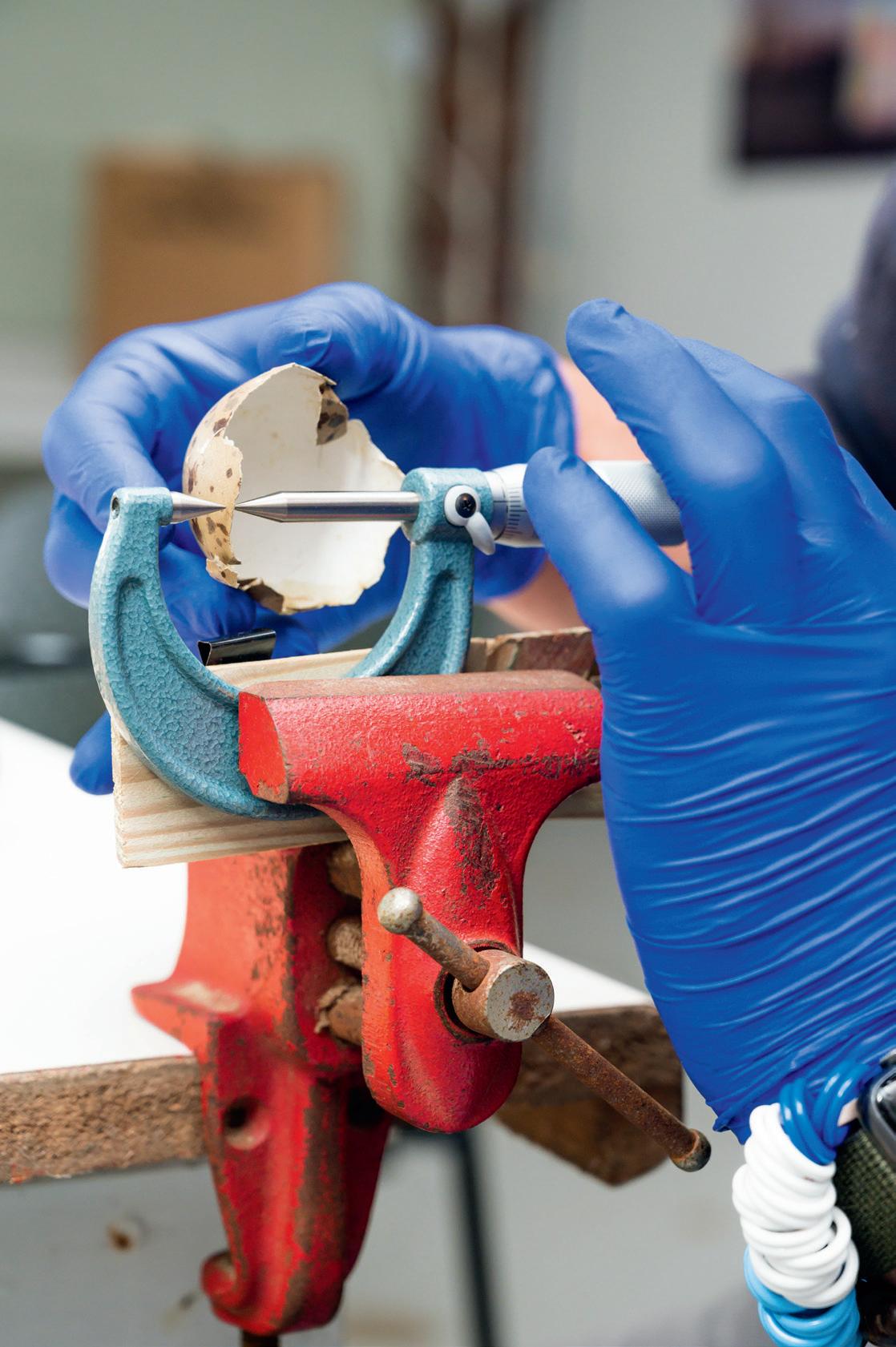

Portland may want to brace for an influx, if trends elsewhere are any indication. In coastal towns and cities in the United Kingdom, including London, the urban herring gull population has quadrupled since 2000 and has even spawned a genetically distinct subspecies. There are reports of gulls staggering drunk out of brewery vats, dive-bombing grannies and small children, and pecking a pet chihuahua
to death. In Rome, Italy, yellow-legged gulls have lately terrorized tourists at the Forum, screeching and circling by the tens of thousands at sundown. Closer to home, the Jersey Shore town of Ocean City recently became the first on the East Coast to deploy trained falcons, hawks, and owls to scare away “increasingly aggressive” gulls that, according to town officials, had become “dependent on an unnatural supply of food stolen from people on the boardwalk and beach.”
Here in New England, flocks of gulls in the street of Boston last winter mucked up the testing of self-driving cars, which identified the birds as a single, large roadblock for which they needed to wait indefinitely, while in York, Maine, a photograph of a tourist’s first-ever lobster roll being stolen by gull beak right out of her hand recently went viral.
And in Gloucester, Massachusetts, where the distance between the harbor and the downtown is only a couple of blocks, musician Bradley Royds recently made himself a lightning rod for the local love-’em-or-hate-’em gull debate by obtaining federal permits to remove nests from the roof of his downtown studio, where he’d noticed a loud and pernicious increase of the birds over the past five years. Gulls were ripping open trash bags, dive-bombing residents, and screeching from their city nests at all hours. What’s more, Royds says, gulls can carry disease. (They can carry E. coli bacteria, which can be transmitted to humans through the birds’ poop.) “This is an ecological and humanitarian effort to do the right thing for our town,” Royds says. “Otherwise they will move in and take over, and they have absolutely zero respect for humans. Or themselves, really. Vicious, vicious little creatures.”

It’s this tension between the world of animals and the world of people that fascinates Perlut. Last summer, he was involved in more than half a dozen research projects, each on a different species, each from a different part of the globe, some long-term gigs, some one-offs, all linked by Perlut’s central concern of how wild animals adapt to life alongside humans. He got into gulls on a whim after watching the birds nest outside his wife’s office window in down-
town Portland. He wondered: Will gulls that fail to procreate successfully in the city try again the next year? Are chicks born on these rooftops forever city birds that will mate and rear their own young here? “These are animals that are all around us, and sometimes we know it and sometimes we don’t,” he says. “The gulls in Portland are a great example of that, where they have this secret life that’s incredibly complex.”
That secret life is proving to be a problem lately, as scientists in New England scramble to explain the birds’ unprecedented decline. Both the herring gull and the great black-backed gull, the birds we New Englanders are most likely to call a “seagull”—a colloquial term that isn’t specific to any species—have declined in the Gulf of Maine at a rate of roughly 40 percent over the past decade. Over their two centuries of history in coastal New England, gulls have declined previously because of natural predation, environmental stressors, and a robust featherpoaching effort to supply the Victorian hat industry. They’ve always rebounded quickly, but not so lately. The population just keeps thinning.
Perlut found out about the decline from a scientist buddy a couple of years into his study, and suddenly his quirky little impulse project became part of a big important picture. Could Portland and other communities on
the Gulf of Maine be a refuge for gulls struggling to survive in the wild, as cities and towns elsewhere in the world appear to be?

That morning on the museum roof, one of Perlut’s students handed him a tawny weeks-old chick that had molted most of its fluff for young feathers. He turned the bird gently onto its back, rested it in his lap, and clamped a band loosely around its leg. “The dangers are equally present on an island versus a city—they’re just different dangers,” Perlut said, as the bird’s round black eyes blinked up at me. “On the rooftops, birds can fall off and die; birds can get heat stress and die; birds can be eaten by somebody else, including other gulls or predators, and die. On an island, gulls can be eaten by other gulls, particularly by other species of gulls, and there is also a much stronger potential for things like flooding, which could kill them, especially if they’re hatched closer to the shoreline. So there’s just different peril. And that’s really what our work has identified, that the perils are sort of equal in terms of the volume of them, but they affect the birds’ lives in different ways.”
Perlut stood the bird up on the gravel, and it rushed for the shelter of the border wall. Under the screeching chaos of the still-swarming adults, the juvenile jumped up onto the wall, panicked, and leaped off the building.
The students rushed to look over the edge. Below, a man and woman on the sidewalk outside a Starbucks crouched over the bird. “Hey!” the students shouted at the couple, waving their arms. “Yo!”
“Is he all right?” Perlut asked, fishing around in the cardboard box for another bird to band.
“It looks like he’s still alive,” one of the students said. “He’s hurt, though.”
About half an hour later, the gull was returned to the rooftop in a box. Its developing wings had saved its life, but it had a limp that Perlut said might be a sprained joint. The students opened the hatch and climbed down off the roof while Perlut lingered to check on the gull. He watched it stagger away. It stumbled and collapsed briefly in the brush near a nest, which made one of the adults still screeching overhead dive for it. The bird scrambled up and
In addition to a small metal band from the federal Bird Banding Laboratory program, this gull tagged as part of University of New England professor Noah Perlut’s studies has a plastic ID band stamped with letters big enough to be read from a short distance with binoculars.

limped on. Perlut walked after it, checking to make sure it wasn’t fatally injured.
He returned, his normally jovial face tense. It’s not easy sometimes, watching what these birds go through. “As a scientist,” he said, “unless they’re really hurt, we have to let, sort of, natural courses.” He looked back at the young bird one last time while the swarming parents overhead continued to scream. It was getting late, and he had a lot more roofs to visit. He grabbed his backpack and disappeared down the ladder.
On the ocean, gulls are good luck. Gulls are strong, brave, commanding. They are harbingers of land, of fish just below the surface, of a coming storm. Legend has it they hold the souls of drowned sailors and fishermen, so killing one is bad luck. In Henry Wadsworth Longfellow’s epic 1855 poem, “The Song of Hiawatha,” when his hero is swallowed by a sturgeon, it’s the seagulls he calls to claw him out of the fish’s belly.
“Set me free from this dark prison, And henceforward and forever Men shall speak of your achievements, Calling you Kayoshk, the sea-gulls...the Noble Scratchers! ”
Preeminent Dutch ornithologist Niko Tinbergen spent decades studying the European herring gull, a close cousin of the New England version, ultimately winning the Nobel Prize in 1973 in part for his gull research. From a blind that was little more than an overturned box tethered to the turf on the rocky shore, the bespectacled Tinbergen crouched over his notebook, peering at the birds to divine, as he wrote, “the secrets of community life.”

Turns out, gulls most of the time just like to chill. “One must persevere,” Tinbergen noted, “and never be discouraged when many hours go by without much of interest happening.” When they do, well, do something, it’s often kind of awkward. Tinbergen observed that the birds aren’t particularly great fliers, and their swimming and walking abilities are only so-so. To watch a gull dive for a fish, as he described it in his seminal 1953 account, The Herring Gull’s World , is like watching a ping-pong ball bobbing on
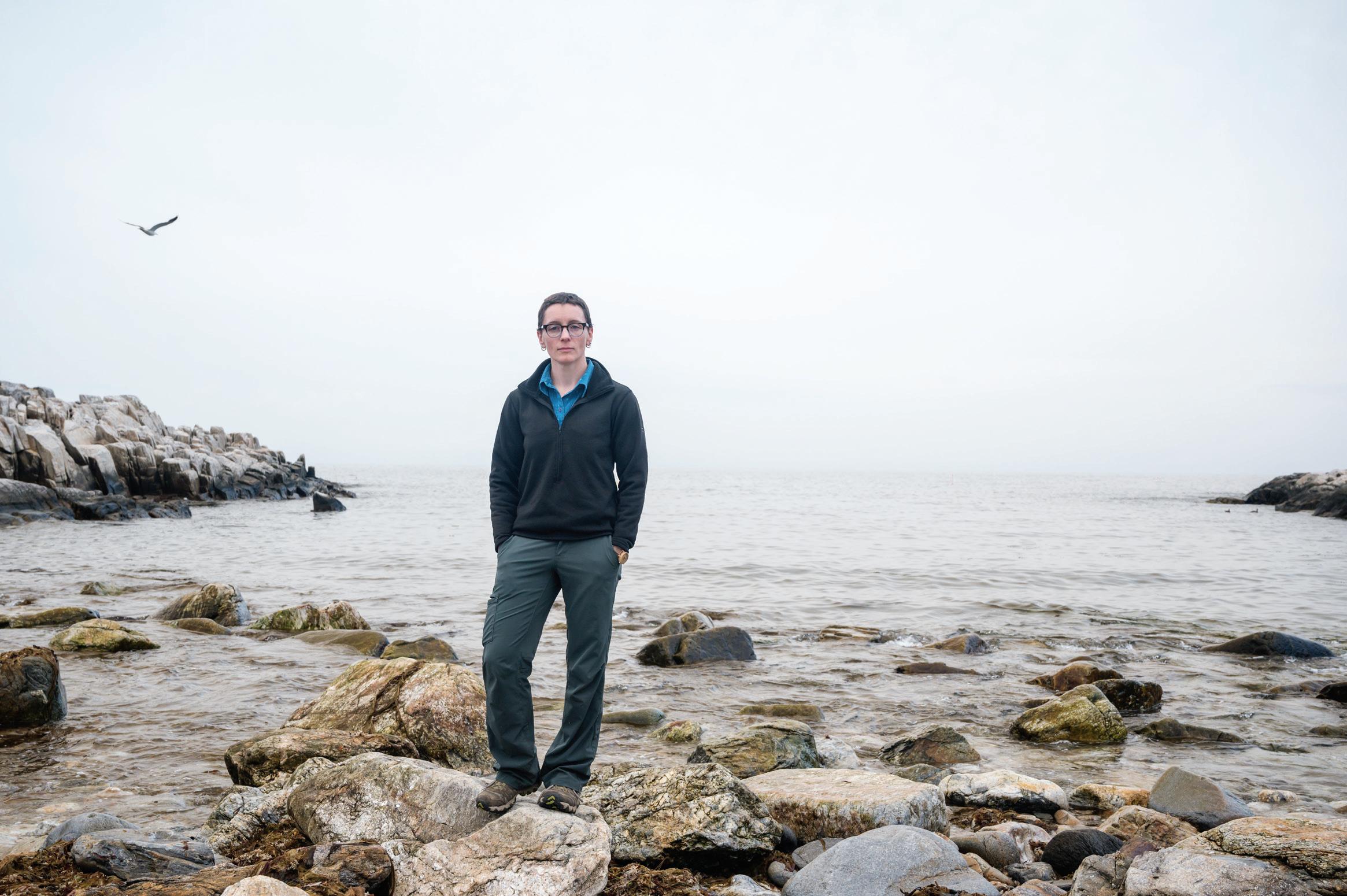
the surface of the ocean: “The whole performance lacks the expertness that characterizes the analogous ... diving of terns.” If they wow at anything, Tinbergen decided, it’s being a little bit good at all things. Gulls are consummate generalists. They reminded him of another consummate generalist: human beings. “The student of behavior is struck by the deeper similarity between man and animals,” he wrote. “It is as if the animals are continuously holding a mirror in front of the observer, and it must be said that the reflection, if properly understood, is often rather embarrassing.”
On Great Duck Island, off the coast of Maine’s Acadia National Park, College of the Atlantic professor John Anderson has spent more than 20 years observing the birds. Like Tinbergen, he finds he can relate to them—their individualism, their tenacity, their penchant for literally shooting the breeze. He likes to climb to the top of the Great Duck Island Lighthouse and watch the birds circling idly in flight. “I think that gulls show every apparent indication of what we call joy,” he says. “They’re having fun. I mean, if you could jump off a high place and soar, wouldn’t you?”
A few years back, Anderson noticed a persistent and widespread decline in New England’s gull populations that he couldn’t pin to any specific stressor. It’s a trend that’s in keeping with broader threats to birds in North America. Last year, the journal Science published a study that found that the total bird population in the United States and Canada has gone down by 29 percent—roughly 3 billion birds—since the 1970s. And while critics assert that a decline in gulls in particular is merely a correction for a population artificially ballooned by landfills that were open from the 1970s to 1990s, Anderson says that while the decline actually began around the same time that open landfills in Maine were being capped, it really accelerated after they had been closed for some years.
“I don’t think it’s a simple cause and effect,” he says. Instead, the continuing species-wide decline of these generalist birds is “to me very scary, because it suggests that multiple things are happening in the environment. We’re looking at a perfect storm of increased predation, declining food sources, changes in fishery patterns, and none of it is good for gulls.”
None of it is good for people, either, Anderson argues. If these highly adaptable birds—there are 36 species in the gull family Laridae , inhabiting every part of the globe, including Antarctica, nesting in all kinds of landscapes, and eating all kinds of food—if these birds can’t make the Gulf of Maine work for them, what does that mean for us humans?
In 2013, alarmed by the persistent decline in gull numbers and its implications for the Gulf of Maine at large, Anderson created the Gull Working Group, a loose affiliation of gull biologists who share findings to try to solve the mystery of the birds’ decline. (Noah Perlut is a member.) The researchers have found that many of the most common species of gulls in the North Atlantic are in
decline, including gulls in Finland, the British Isles, and Eastern Canada. Climate is a probable common factor, although current evidence doesn’t point to its being the primary cause.
“Particularly here in the United States, a lot of the emphasis in the 20th century was on gulls as pests, and the potential impact of gulls on other species, and gull management,” says Anderson. “I think now we’re moving into a very different place, where there are more and more of us who are sort of rethinking gulls. And we’re now confronting this business of major declines and having to work out what that might mean in the broader sense.”
New England’s herring gulls might be amenable to city life, but the region’s second most common gull, the great black-backed, might not be. Great black-backeds are the largest gulls in the world, with a six-foot wingspan, an ornery temperament, and a reliance on marine-based food sources. That worries Sarah Courchesne, an associate professor of natural sciences at Northern Essex Community College in Haverhill, Massachusetts, and codirector of the gull research program on Appledore Island, off the New Hampshire coast. Courchesne has seen the number of great black-backed breeding pairs on Appledore decline by roughly 60 percent since the early 2000s. Because black-backeds aren’t as flexible as herring gulls in their feeding habits, a drop like this could mean they “just kind of disappear from our landscape,” Courchesne says.
I met Courchesne at the height of summer breeding season on Appledore Island. She was there to check in with her summer interns, one of whom was researching whether great black-backed gulls are developing an adaptation to better accommodate life among humans. As we walked the island’s trails that morning, we passed a volatile tapestry of nests, each of which was manned by at least one very protective parent, and dozens of herring gulls and great blackbacked gulls keeping watch from the roofs of the island’s dormitories and research buildings. Being dive-bombed by one of these birds triggers a primitive, hit-the-dirt panic. To this end, it’s wise to wear a helmet around Appledore’s gulls. Outside the mess hall, a good Samaritan had laid a pile of sticks for anyone who’d forgotten their helmet that day. (Gulls protecting offspring tend to dive for the highest point, and it’s better a stick held aloft be that point than your head.) A few summers before, an intern had braved the island without helmet or stick only to be concussed by a diving great black-backed gull and emergency-ferried back to the mainland.
Courchesne is forgiving, though. “Some of them are really quite gentle,” she says. “Some of them you can almost pick up by hand when they’re sitting on their nest. And others are incredibly defensive of their offspring.

in 2020 or 2021!
• Maintenance-free living in a convenient country setting

• Solar-powered, energy-e cient cottages with 4-season sunrooms

• Hiking, biking, and free Golf FORE Life at three local courses

• Choose your oor plan, decor nishes, and completion time frame

• Peace of mind with private access to continuum of care



• Just minutes from the ocean, Portland and the main OceanView campus
MAINE
Cumberland Crossing by OceanView
277 Tuttle Road
Cumberland, Maine
207-781-4460
cumberlandcrossingrc.com
Penobscot Shores
10 Shoreland Drive
Belfast, Maine
207-338-2332
penobscotshores.com

Quarry Hill
30 Community Drive
Camden, Maine
207-301-6116
quarryhill.org
Thornton Oaks
25 Thornton Way
Brunswick, Maine
800-729-8033
thorntonoaks.com
VERMONT
EastView at Middlebury
100 EastView Terrace
Middlebury, Vermont
802-989-7501
eastviewmiddlebury.com




















That just strikes me as very human.”
The summer I visited, it was sophomore Brielle Michener’s job to provoke great black-backed parents. Continuing a gull-triggering experiment that had started the previous year, Michener, a farm girl from Massachusetts, would put on a bright blue poncho to become the same generic blob of color as last summer’s intern, squish a round black bike helmet over her blonde curls, and stand very close to a nest with eggs or hatched chicks to see how the parent reacts. Short answer: They didn’t like it. In fact, the birds got so angry Michener had to modify the way she logged their response. At the bottom of the typed scale she had tucked into her notebook that day, with “0” being no reaction at all and “7” being charging at her, she showed me where she’d scrawled an “8” in black pen, for times when the gulls flew at her head or bit her ankles.





Thankfully, contact like that was rare. More often, when Michener
approached a nest in the brush, the bobbing head of a black-backed parent would lift up sharply, and the bird would let out a repetitive, guttural ah-ah or ow-ow that continued loudly until she backed away. Though it was probably meant to sound scary, it sounded scared, Michener thought, and she once asked Courchesne what to make of it. Courchesne had told her that over the years, she’d seen these big, intimidating gulls get as panicked by approaching humans as they did flyovers from predators like bald eagles. “People might think they’re being a nuisance acting like this,” Michener explained to me, “but they’re really terrified.”
Michener’s research was directed by Kristen Covino, an assistant professor of biology at Loyola Marymount University in Los Angeles, as part of a broad study of hormones in great black-backeds. Michener had discovered that many of the island’s most aggressive gulls had paired up with other highly aggressive gulls rather
Dissatisfied with your current trustee? Receive the service and returns you deserve. Call Adam at Princeton at (561) 800-0041.
Adam Falcon, CFA

Adam Falcon, CFA, has deep roots in New England. He grew up in Hancock, NH, attended grade school and high school in NH, and later graduated from Bowdoin College in Maine. Professionally, he has served as CIO for a multi-billion dollar single family office, has worked in bank trust divisions, and has co-founded Princeton Asset Management, LLC, which specializes in providing asset management to trust assets.

If you want better service, the opportunity of superior returns, or are an irrevocable trust beneficiary, Princeton can help you. Princeton has a deep knowledge of fiduciary duties and award-winning returns. Learn how Princeton can manage your trust assets superior to how they are now.
Call Adam today at (561) 800-0041
www.princetonam.com




than choosing a mellower partner who might blunt their sharp edges. The result, Courchesne says, will likely be extra-aggressive offspring.
“Is there a benefit to pairing off with another aggressive bird and making offspring that tend to be more aggressive?” she says. “It might actually be maladaptive to be too reactive to humans. We just don’t know.” Courchesne says so little is known about these birds, she’s not even sure aggressive pairings are unusual. “But my hope for them,” she says, “if I’m trying to find an angle where I don’t get completely pessimistic about their prospects for continuing to exist, is that they are individually, behaviorally plastic enough that a specific bird could deal with these challenges and change its behavior and find a way to make its way through the world. That’s my hope with these gulls.”
Afew days before joining Noah Perlut on the roof of the Portland Museum of Art, I met him next door at the Children’s Museum & Theatre of Maine. The museum had contacted him about a herring gull nesting behind the wooden-pirate-ship play area. Unlike the PMA, the children’s museum had only this one nest, and that was a fluke. “Occasionally the babies will fall down [from the PMA] once they’re learning to fly and they’ll end up in the backyard,” says Tara Fletcher, the museum’s exhibits and visitor services assistant. “And we’ll just kind of shoo them out and they meet up with their parents in the parking lot.” The children’s museum had asked the PMA for the name of its bird guy, and one morning before the museum opened, Perlut showed up to band the gull.
It had rained the night before, and the only sound was the shoosh of traffic on Free Street, on the other side of the building. “I’m going to try and catch this bird by hand,” Perlut said, eyeing the gull, which sat in blissful ignorance in its nest, flanked by trash bins. “And then I’ll take this pant leg”—he waved a worn piece of
khaki—“and stick it over its head to cover its eyes. That calms it down.”




Perlut clucked gently at the bird, which squirmed and began to squawk the closer he got. When the bird stood up he rushed at it, pinning its wings, and his assistant put the pant leg over the bird’s head, which calmed it enough to allow Perlut to strap a lightweight satellite tracking device to its back. Perlut has only a handful of the devices, which are about the size of a flip phone, and they fall off in a year, he said, but in the meantime this tracker will provide him with the bird’s location every four hours. From this one gull, Perlut can learn a lot: where it goes to forage, where it migrates during the winter, whether it returns to the city next summer.
A couple of months later, as summer began to fade, I got an email from Perlut titled “Children’s Museum gull.”












“Just a quick update,” Perlut wrote. “Looks like she is still hanging out in the Greater Portland area.” The attached map showed the gull’s summer travel in red lines that splayed out from the museum in a star shape, each line representing one flight. The star looked as if it had been drawn with an extra-thick marker because the movements were so repetitive—layers upon layers of red lines. The gull had traveled to Long Island in Casco Bay, Westbrook, and Scarborough, but stayed mostly on the Portland peninsula. These were the wanderings of a city mother, foraging for her children from her downtown home.
Staring at the star, I was drawn to a point stretching south, darker and longer than all of the others. A favorite track, it extended straight down off the map over the swath of blue that represented the Atlantic Ocean. I imagined the gull flying over an expanse of glistening ocean, an ocean that seemed to go on forever, flying far and fast and strong. I hoped some of that flight was for the sheer exuberance of defying gravity. I hoped, as John Anderson had told me, it was for the joy of it.


The 100% solar-powered FREEDOM GREENHOUSE is a revolution in hobby greenhouse growing. Through innovative ventilation designs, automatic watering benches and solar panels, Maine Garden Products has created the world's first self-contained and self-tending hobby greenhouse. Many sizes and options available. Call or email today to discuss how we can help you.


Maine Garden Products PO Box 254 Howland, ME 04448 (207) 613-2973































INFO@MAINEGARDEN.COM



UNCOMMONLY SENSIBLE GARDEN TOOLS & GIFTS WWW.MAINEGARDEN.COM















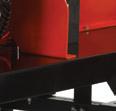




















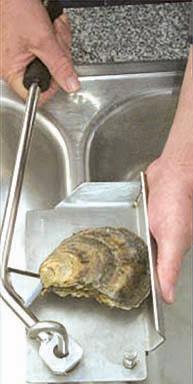

proof carefully. Approval must be returned by responsible for errors once proof has been signed— or if not returned by the above date. that color proof/pdf is to show color break only. Colors do not accurately actual printed advertisement as it will appear in the publication. mark them clearly.________________________________________________________ ________________________________________________________
America’s Original Field and Brush Mower!












new proof necessary) Signature:














...and BRUSH! FIELD...
needed. (send new proof) Signature:
CLEAR 8' TALL GRASS & WEEDS with 26", 30", or 34" cut!











CHEW THROUGH BRUSH including saplings up to 3" thick!




proof carefully. Approval must be returned by for errors once proof has been signed— or if not returned by the above date. color proof/pdf is to show color break only. Colors do not accurately actual printed advertisement as it will appear in the publication.

POWER & PRECISION with engines up to 20 HP and power steering for fingertip control.





mark them clearly.________________________________________________________


proof necessary) Signature:
Towable and PTO models too!





needed. (send new proof) Signature:







“Your house for all occasions”


Candies! For over 50 years we have used only the finest ingredients in our candies—cream, butter, honey, and special blends of chocolates. Call for a FREE brochure. Long famous for quality candies mailed all over the world. Treat yourself or someone special today.

292 Chelmsford Street Chelmsford, MA 01824 For Free Brochure Call: 978-256-4061











Save Energy & your Historic Windows 10 Minute Install 10 Seconds In / 10 Seconds Out Innerglass® Window Systems, LLC The Compression-Fit Advantage stormwindows.com 800-743-6207




Palm Coast, FL 32142-2447 Yankee Magazine DOES NOT contract with third parties to solicit or receive subscription payments. If you receive a renewal and are unsure of its authenticity, please call our subscriber services department: 800-288-4284 Window WITH an Innerglass Interior Storm




SUBSCRIBER Window WITHOUT an Innerglass Interior Storm






e Perfect Storm












(Continued from p. 120)

The reason, of course, is that March 24 is when everything changed. Or rather, March 24 is the day when I fully grasped that everything had changed. Maybe this is because it was the day that I used the last of the cream in my morning coffee and knew I wouldn’t be going to Willey’s store for more (though I was sorely tempted), or because it was the day that our governor issued a “stay home” order for all but essential workers. Most likely, it was simply because the constant drumbeat of news relating to the coronavirus—the overwhelmed hospitals and healthcare workers, the swift and merciless economic fallout— had finally burst through the bubble of our quiet rural life, which until this point had seemed far removed from the chaos unfolding out there.
To be sure, we hadn’t been entirely unaffected by the pandemic. We’d stocked up on essentials (ice cream, check … coffee, check … cat food,
check … and yes, toilet paper, check) and as many fresh vegetables as we figured we could eat before they rotted. We’d already taken advantage of our local library’s “call in” service; after requesting our chosen titles, my wife, Penny, went to retrieve the books, which had been left in a paper bag outside the front door. Figuring there was no better place to practice social distancing than deep in the woods, I picked up some new chains and a few gallons of bar oil for the saw and filled two five-gallon cans with ethanol-free gas. If nothing else, we’d emerge from this pandemic with a heck of a firewood pile.
And yet before March 24, so much seemed exactly the same. I still woke early, still started the fire and sat quietly while waiting for my coffee to perc. I still did the same chores with the same animals, still climbed to the knoll behind the barn to look out over the old church steeple and into Bob’s hayfield. Maybe there was a little less traffic on our road, but honestly, it was hard to tell, since even on a busy day it’s not uncommon for an hour or more to
pass without seeing a car. And unlike so many of our friends and neighbors, I still had work—not a lot, but some, and for the time being, enough. So while I knew the world was changing in ways that would surely reverberate through our lives, it was almost as if we existed in a time lapse, buffered by geography and circumstance. I felt grateful for that buffer. And since I knew what a privilege it was to have it, I felt guilty, too.
I water the cows, and fork hay off the big round bale I’d situated just outside the wooden fence of their paddock. For most of the winter, they’d been running a piece of orchard pasture, but the recent spring weather had gotten their dander up: They’d breached the barbwire fence twice in the previous week, and even wandered across the road and into our (very understanding) neighbor’s backyard. Clearly, this would not do, so in the aftermath of the second escape, we chased them into the confines of the paddock and closed the gate. They would roam no more, at least not until the spring grass had sprung in full. I felt a bit sorry for them—surely they preferred the relative expanse of their pasture lot—but then again, if you can’t do the time, don’t do the crime.
After chores, I change into my ski boots and bee-line through town to Bob’s hayfield. Yesterday, it’d been nearly clear of snow, and on my evening walk I’d counted nine deer, heads bent to the ground, so intent on filling their bellies they didn’t even notice me. Today, it is once again an unbroken sheet of white, and I ski straight to the height of the field, where, if I turn around, I can see back across the mountain road and past the church steeple, to the barn and paddock where the cows are still nosing through their morning ration.
But I don’t turn. Instead, I keep climbing the steep pitch beyond the hayfield’s boundary, right up into the sugar woods, where the sun is just high enough that the trees cast narrow shadows in my path. Where I know that if I just put my head down and keep on moving, everything else in the world will fall away.



















































































































Pests like the invasive emerald ash borer can hitchhike in your firewood. You can prevent the spread of these damaging insects and diseases by following these firewood tips:


Buy locally harvested firewood at or near your destination.








Buy certified heat-treated firewood ahead of time, if available.









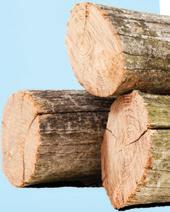
































































































Gather firewood on site when permitted.




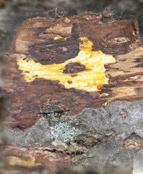


THOUSAND CANKERS DISEASE of black walnut is caused by the walnut twig beetle and a fungus it carries to trees. The walnut twig beetle is tiny — about the size of the “I” on a dime — and thousands of them could be hiding in the bark of a single piece of walnut firewood.







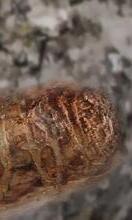
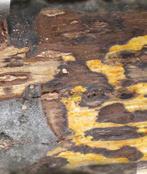









GYPSY MOTH is a devastating pest of oaks and other trees. Female moths lay tan patches of eggs on firewood, campers, vehicles, patio furniture — anything outside! When these items are moved to new areas, this pest gets a free ride.






SPOTTED LANTERNFLY sucks sap from dozens of tree and plant species. This pest loves tree-ofheaven but will feed on black walnut, white oak, sycamore, and grape. Like the gypsy moth, this pest lays clusters of eggs on just about any dry surface, from landscaping stone to firewood!
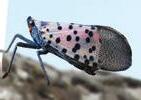
OAK WILT is a deadly disease of oak trees, especially red oaks. This disease is a fungus spread between trees by small beetles — and this deadly fungus could easily be brought to your neighborhood or favorite camping spot through infected firewood.


ASIAN LONGHORNED BEETLE will tunnel through, and destroy, over 20 species of trees — especially maple trees. The larvae of this beetle bore into tree branches and trunks, making it an easy pest to accidentally transport in firewood.



EMERALD ASH






















































BORER — the infamous killer of ash trees — is found in forests and city trees across much of the eastern and central United States. This insect is notoriously good at hitching rides in infested firewood. Don’t give this tree-killing bug a ride to a new forest, or a new state!

Animals to tend, wood to cut, and outside the window, a fast-changing world.
ILLUSTRATION BY TOM HAUGOMAT
n the morning of March 24, 2020, we awake to eight inches of new snow. The ground, which had only just begun to emerge in tawny patches from beneath a winter’s worth of accumulation, is again covered. I pull on my chore boots—the good pair, the pair that hasn’t yet split at the crease where they always split midway through their second season of use—and trudge through the snow to milk and feed the cows. The snow is unmarked. Not even the cats have been out yet; they’d mewled at the door as usual, but when I opened it, they just stood there, ears alert and eyes wide, and then retreated back to the comfort of the couch. Well, I could understand why.
We live a seasonal life, here on our Vermont homestead, so I tend to write seasonally, too. If it’s for a winter issue, I’m writing about snow and cold and skiing. Breaking the ice on the cows’
water. Getting stuck and plowing snow. That sort of stuff. If it’s for a summer issue, I write about swimming in the pond or running fence or maybe pulling weeds in the garden (because if nothing else, there’s always weeds to pull).
And here I am, in the July/August issue of Yankee, at the very height of summer. The blueberries are just now ripening, the sweet corn knee-high (you know the saying, right? “Kneehigh by the Fourth of July”?), the tomatoes still green but showing promise, the cows listless in the heat, tails switching lazily back and forth to shoo flies, the boys cannonballing off the big rock into the cool of the pond—yes, all of this right outside our half-open front door. Yet I am writing about a snowstorm in March.
(Continued on p. 118)
Jimmy is all of the patients, doctors, researchers, event participants, and supporters of the Jimmy Fund. Like Carly, who didn’t let her cancer stop her from dancing. Your donation helps change the way the world treats cancer. Because we’re all Jimmy.
Donate now at iamJimmy.org/carly






